SPECIAL REPORTS:
AI in Content Creation (in collaboration with Vizit)








Engaging Shoppers In-Store (in collaboration with Mood Media)


AI in Content Creation (in collaboration with Vizit)








Engaging Shoppers In-Store (in collaboration with Mood Media)


Marketers from around the world provide perspective on the path to purchase









Our proprietary research examines the potential of AI, showing how marketers plan to move from test-and-learn to full adoption. In collaboration with Vizit.


Our proprietary research provides insights on in-store shopping habits and drivers, as well as the overall in-store experience. In collaboration with Mood Media.


Our latest gallery presents a sampling of eye-catching and effective in-store activations, from grocery and department stores to optometrist offices.




Keith Albright Kimberly-Clark Dana Barba The Lemon Perfect Co.


Stephen Bettencourt CVS Health
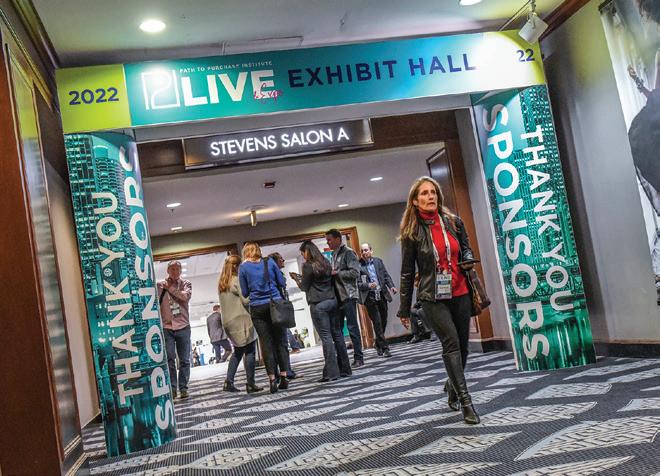
Lianna Cabrera L’Oreal Paris Cosmetics

Mia Croft
Native Christiana DiMattesa Under Armour
Gregg Dorazio
Giant Food (Ahold Delhaize)

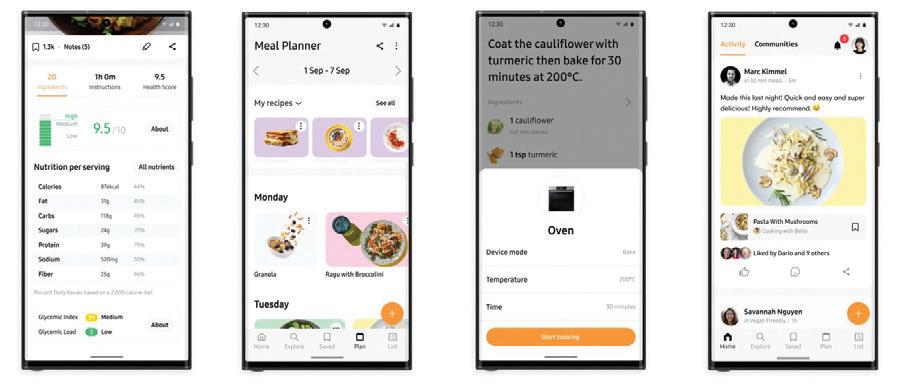


Paige Dunn FIJI Water, JUSTIN Vineyards & Winery, Landmark Vineyards & JNSQ Wines

Tony Fung Bob Evans Farms
Patrick Hallberg Apple Travis Harry Home Depot Carter Jensen General Mills




Here at P2PI, we like to think of ourselves as the OG when it comes to publications covering retail media. We’ve always been at the forefront of helping our industry navigate this field —even back when the questions our members had were quite elementary (as in, “What even IS retail media?”).
So as the proliferation of retail media continues across the globe, we too are bringing our expertise to marketers around the world, starting with a big leap across the pond. This October, we’re beyond excited to co-host our very fi rst international event — Retail Media Summit UK — in London along with our partner SMG.
There’s no doubt retail media has been a hot topic for our industry these last few years, but it seems we are fi nally hitting full stride now. And while there is a plethora of information out there available, it can also be quite challenging for commerce marketers to sort through it all.
Retail Media Summit UK has been carefully designed to help brands and retailers cut through that noise. We get it, there are a lot of events. There’s a lot of confl icting advice. So, it’s our mission to help attendees separate fact from fiction with a content program that is going to outline best practices and do a little myth busting, dig into some data and, most importantly, provide marketers with the knowledge to strategize a clear path forward in this ever-changing landscape.
Our international coverage doesn’t just stop at retail media though. As brands and retailers encounter an increasingly complex matrix of consumer trends and shopper behavior along the path to purchase, P2PI is working to make sure our readers and members are informed, inspired and interconnected. Part of this process includes covering more international stories so that our audience has access to the most innovative ideas, best practices and tactics — regardless of borders. From expanding our member-exclusive retailer profiles online to include new countries like Canada and the U.K. this year (plus more countries and retailers coming in 2024) to interviewing commerce marketers across the world to share their experiences (see page 24) to covering the latest campaigns, in-store experiences and more, P2PI will keep you ahead of the game by offering a holistic view of shopper journeys across the globe.
Today’s consumers aren’t just hybrid shoppers who move fluidly between online and in-store, they’re truly engaging in omnichannel journeys where moments of inspiration and consideration meld into one. That traditional marketing funnel — forget it, it’s gone, dissolved. Consumers are engaging with brands all across that path to purchase, and it’s our goal to help commerce marketers seize each and every new opportunity.
Whether it be retail media, AI or some new, unimagined path that’s yet to reveal itself, we hope you fi nd the fuel on these pages to confidently forge ahead in these unchartered waters. The new world of commerce marketing requires bold ambitions, out-of-the-box ideas and a little bit of bravery to test and learn new ways of thinking. When it comes to disrupting the status quo, retail media has forced our industry to rewrite the rules and reinvent the game. We may still be building the plane while flying it, but what an amazing ride it will be.
BRAND MANAGEMENT
Vice President, Brand Director Eric Savitch esavitch@ensembleiq.com
EDITORIAL
Editorial Director Jessie Dowd jdowd@ensembleiq.com

Executive Editor Tim Binder tbinder@ensembleiq.com
Managing Editor Charlie Menchaca cmenchaca@ensembleiq.com
Digital Editor Jacqueline Barba jbarba@ensembleiq.com
Managing Editor, Member Content Cyndi Loza cloza@ensembleiq.com

Editor, Member Content Heidi Bitsoli hbitsoli@ensembleiq.com
Director, Events Content and Strategic Engagement Lori Pugh lpugh@ensembleiq.com
Contributing Writers Michael Applebaum, Ed Finkel, Erika Flynn, Jenny Rebholz, Bill Schober
ADVERTISING SALES & BUSINESS
Associate Director, Brand Partnerships Arlene Schusteff 847.533.2697, aschusteff@ensembleiq.com
Regional Sales Manager Orlando Llerandi 678.591.8284, ollerandi@ensembleiq.com
MEMBER DEVELOPMENT
Director of Retail Patrycja Malinowska pmalinowska@ensembleiq.com
Sr. Director, Membership Development Nicole Mitchell 203.434.5733, nmitchell@ensembleiq.com
Membership Experience Manager Ann Estey aestey@ensembleiq.com

Manager, Membership Development Brady O’Brien bobrien@ensembleiq.com


Membership Experience Manager Heather Kurtik 724.553.0093, hkurtik@ensembleiq.com
DESIGN/PRODUCTION/MARKETING
Art Director Michael Escobedo mescobedo@ensembleiq.com
Production Director Michael Kimpton mkimpton@ensembleiq.com
Marketing Director Marlene Shaffer mshaffer@ensembleiq.com
SUBSCRIPTION SERVICES

List Rental mbriganti@anteriad.com
Subscription Questions contact@pathtopurchase.com
CORPORATE OFFICERS
Chief Executive Officer Jennifer Litterick
Chief Financial Officer Jane Volland
Chief People Officer Ann Jadown
Chief Strategy Officer Joe Territo
Chief Operating Officer Derek Estey
JESSIE DOWD, Editorial DirectorHERE’S A SNAPSHOT OF INDUSTRY LEADERS FROM THE P2PI MEMBER COMMUNITY.
LINDSAY DEFALCO Shopper Marketing and E-Commerce Sales Manager Eagle Family Foods
Main job responsibilities: Shopper marketing and retail media across all brands and all retailers, plus Amazon sales management.
How you win with shoppers during uncertain economic times: We lean into stacking our shopper marketing and retail media plans with our trade promotions to amplify those offers to our shoppers. In key activation windows where there are not trade promotions, we look to supplement with shopper tactics like digital coupons or rebates to continue driving velocity with our shoppers.
New marketing tactic that you use: Retail media multi-vendorthemed event programs are a new tactic we’ve leaned in on with many of our brands and retailers. They have driven strong ROAS for us. These programs are great, because they center around events or occasions that are relevant to that retailer’s shoppers, such as summer grilling with Suddenly Salad or holiday baking recipes with Eagle sweetened condensed milk.
Best career advice you’ve received: Keep the consumer or shopper at the center of every marketing decision. Then build out from there to also incorporate brand, sales and retailer strategic growth objectives.
Memorable aha moment in your career: Back in 2021, I had an aha moment that retail media was beginning to significantly develop and change how to approach shopper marketing strategy and execution, as well as the overall marketing mix. This epiphany drove me to transition from my past experience as a brand manager into the shopper marketing manager role. I wanted to dig in to learn more about retail media and then guide how, when and where our brands should leverage it to reach the right shoppers, measure return and drive growth.
Fall plans: I have two young boys, so our schedule includes apple picking, pumpkin farms, T-ball games and Halloween costumes.
RICHARD PACE Chief Client Officer and Co-Founder Channel AgencyMain job responsibilities: We have a great team and we wear many hats at Channel. At the core, I manage the client relationships and strategy work along with my partner, Chris Stanton.

How you win with shoppers during uncertain economic times: It has been a challenge. The ever-changing shopper dynamics, the shrinkage of the front end and price increases have really forced us to think about things differently, while at the same time getting back to basics. We’ve been laser-focused on the data, finding the right time, place and route to get our brands into the consideration set along the funnel.
Best career advice you’ve received: Clients come to our agency with a challenge, and we aspire to address the challenge and deliver results. Instinctively we want to solve that problem immediately, often before the client even finishes asking for help. The best advice I received was from my father years ago: Listen. Not just to what the client is saying, but how they are saying it. There is so much you can uncover by not jumping in with a solution.
Memorable aha moment in your career: We do a lot of experiential and other kinds of events for clients. We have worked with brands large and small with the budgets to match. It obviously depends on the objectives, but you see a lot of brands spending significant dollars at events with little benefit for the consumers themselves. To make a connection with the consumer in a meaningful way, you need to speak to them on their level and enhance their experience over that of your brands.
Recent travels: I don’t sit still well, so I’m on the go a bunch. Over the past several months, I had a family reunion in Florida, saw friends in the Outer Banks and flew to Ireland with my father to play golf.
 BY MARGO KAHNROSE
BY MARGO KAHNROSE
Right now, there’s a great deal of hype around generative AI within the advertising and marketing technology industries. Imagining new possibilities with near-limitless potential, while predicting just when and how much things will change, is the feat. But it’s clear that advancements in AI will be an enormous boon in the effort to take marketing omnichannel.
While going omni might be necessary for marketers, this evolution needs some technological tailwinds. The dynamics of commerce have changed dramatically. Control of the digital ecosystem by marketers, media giants and retailers has reversed. Consumers hold most of the power today and their needs have evolved.
Today’s consumers are:
• Entirely omnichannel in their behaviors, migrating seamlessly between media and distribution channels. Marketers typically expected specific behavioral outcomes from specific channels, but consumers don’t care. They expect to be able to do it all, anywhere they are.
• Protective of their privacy. New boundaries for data collection and usage have been established. It’s not the consumers’ problem when marketers lose. They will easily disengage from brands that don’t protect their data.
• Hanging out in walled gardens. Open web advertising can be a poor experience in the consumer purchase journey. Consumers seek curated experiences in social media, search engines and retailer websites. Recent Skai research shows 77% start research within a walled garden and 65% fi nd advertising more useful in walled gardens than the open web due to data protection. For marketers, communication with consumers must be omnichannel and concentrated within walled garden media, while taking full advantage of intelligence and the safe handling of consumer data. Going omnichannel is less a technology constraint and more an issue of time — freeing up resources for cross-channel analytics,
establishing new KPIs outside of channels, and creating new ways that teams work together will map to winning customers over channels. With AI giving gains to marketers, brands can save time and overhead. This leverage helps brands to better prioritize, recognize the pockets of opportunity in audience segments and keyword terms, and make use of competitive intelligence to eliminate wasted cycles.
AI can’t simply be unleashed without checks and balances in its early days. To become an omnichannel marketer, first consider whether you have the tools to thrive within each of the walled gardens, as well as privacy-safe data connectivity between them. Most ad platforms focus on the open web, so this is a short list. Next ask yourself: Are you set up to leverage the latest in AI capability in order to reduce overhead and drive efficiencies that help you prioritize? In order to move fast, you will need to be able to rely on your platform’s expertise in data handling, governance and quality control against AI-generated output and insight. Independent platforms give you an early adopter advantage in leveraging AI without the risk.
Omnichannel marketing is the only way to keep pace with customers who are increasingly omnichannel. The tenets are clear: Go where consumers are, and respect their privacy at every touchpoint.
Margo Kahnrose has more than 15 years of experience in marketing, branding, communications and lead generation across various enterprise and consumer goods industries with an emphasis on technology. With roots in consumer brand e-commerce, she previously led the development and management of Skai’s brand marketing for more than four years before doing the same for marketplace app SpotHero. Kahnrose rejoined Skai in 2018, where she leads marketing for the company globally.
AI can’t simply be unleashed without checks and balances in its early days.

Marie Stafford of Wunderman Thompson Intelligence takes the stage on the morning of Nov. 8 for a session on “The Age of Re-enchantment.”


On Nov. 8, we cap off a full day with a 5 p.m. cocktail reception and ceremony honoring our 2023 Women of Excellence winners.
• P2PI and Chicory will share insights from a new consumer report that highlights how shoppers are inspired by relevant content.

• P2PI and Mood Media will discuss results of a new study examining what draws shoppers into stores, how they respond to media activations, and what motivates them to go from passive to active engagements.


The OmniShopper Awards cocktail reception and ceremony take place at 4 p.m. on Nov. 9. This awards program honors excellence in shopper engagement across the path to purchase.
Discover the latest and most innovative solution providers in commerce marketing. Exhibitors will showcase the tools and technologies that can elevate your marketing efforts to new heights.


We offer specialized tracks dedicated to these important topic areas, identifying new tactics, winning strategies and best practices.
BACi, Commerce Executive Network and Retail Media Guild provide just some of the additional opportunities to connect with key players in the industry over three days.
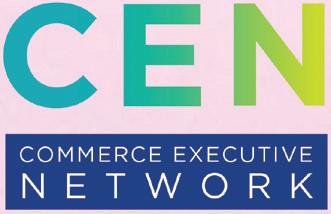
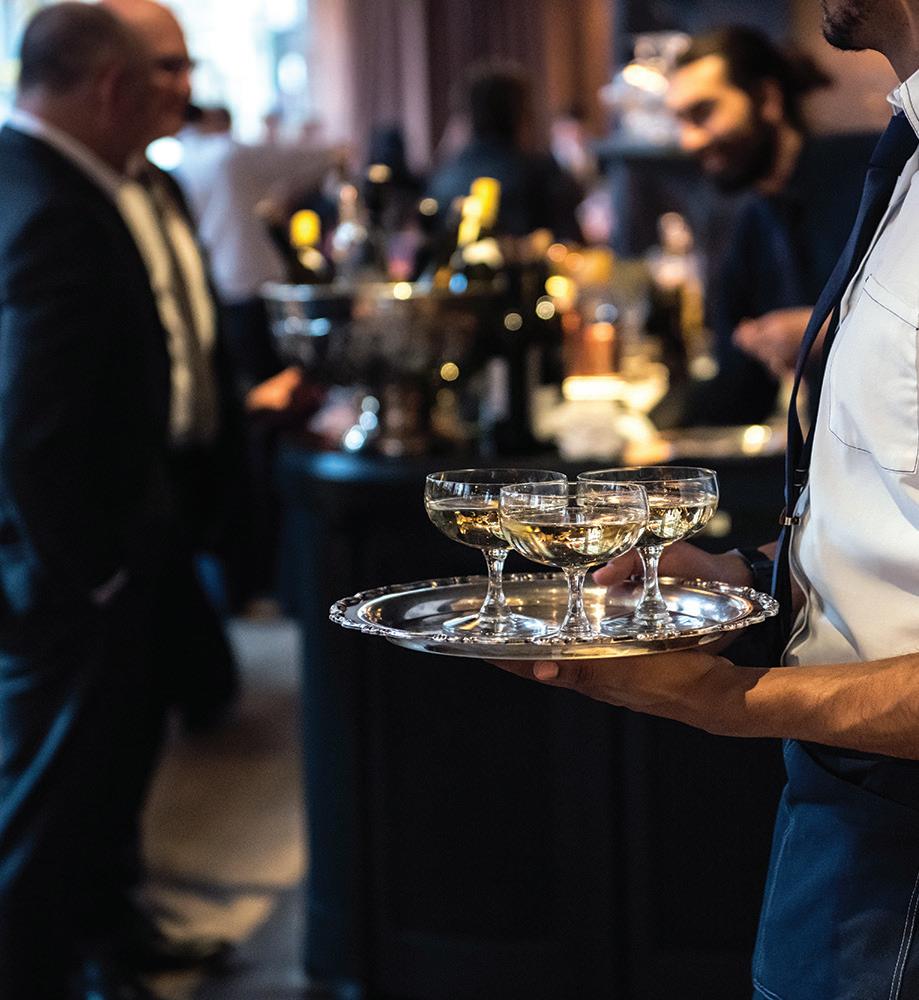

For more information, including the complete agenda, and to register, scan this code.
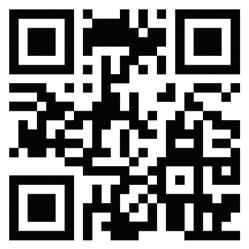

 BY CYNDI LOZA
BY CYNDI LOZA
Technology, including mobile phones, smart TVs and a growing list of streaming services, is driving a rapid and dramatic shift in the television ecosystem. Today’s audiences are in control of what they watch, when they watch it and by what medium they watch it — and they have an abundance of content choices. We recently caught up with Nielsen’s Jeff rey Schmidt, senior vice president, client solutions; Wendy McClintock, vice president, client solutions; and Jenny Park, senior director client solutions, on what role the 100-year-old company plays in this rapidly evolving media landscape. Additionally, they discussed how Nielsen is measuring what programming audiences engage in (and where), so that the makers of content, distributors of content, advertisers and sponsors of content all have a truth set on which to conduct business with each other.
Schmidt: Although retail media has exploded within the past five years, the truth is that Nielsen has been supporting retail media since inception starting in 2014. Nielsen fits into retail media as a source of audience measurement, planning and analytic comparability. Over the last few years, Nielsen has been building out a cross-media audience measurement solution (Nielsen ONE Ads) that helps provide a comprehensive reach and frequency of computer, mobile, linear TV and CTV media. Nielsen ONE Ads covers 100% of linear TV, 90% of computer mobile and 85% of CTV media spending, inclusive of walled garden coverage of Meta and Google properties. Nielsen ONE will also aid advertisers to understand the benefits of investing in retail media partners, through the comparable independent lens they have already been using to evaluate the rest of their media plan for reach and frequency optimization.
Retail media is growing, in part, by increasing its allocation of media spending from other marketing channels, including TV. It is only by understanding the impact of media spend across all platforms that brand advertisers can intelligently allocate their cross-channel spend, for the maximum incremental gain within and across the retail media channel. Clients can take advantage of their retail media-based targets, to either measure audience performance within those targets, or pull those segments through to planning as the advertiser or agency builds out plans for optimization period to period.
What are Nielsen’s retail media solutions and offerings?
Park: Our solution suite is geared toward audience measurement (reach and frequency optimization), media planning and sales impact analytics. Retail media is moving up the marketing and sales funnel into new formats, including open web, social and streaming TV formats, even taking them into the store experience as part of the omnichannel journey. We believe retail media will disrupt traditional TV advertising with its ability to use first-party data for targeting and measurement, and it will need partners like Nielsen that can uniquely match to first-party identifiers and bring in both big data and panels, as well as measure CTV, streaming, podcasts and brand engagement at the shopper and household level.
What is the company’s approach to retail media measurement?

McClintock: Inclusive coverage of the media landscape for retail media is consistent with Nielsen’s vision to capture all audience exposure to media within the cross-media landscape. It is not new, but it is set up to serve with this additional focused reporting.
We are exploring unique partnerships within key retail media partners to offer audience measurement in Nielsen ONE directly through the retail media partner, instead of through Nielsen as a third party, and we are also seeking similar arrangements to use our industry-leading analytic practices as a bridge in comparability for those same retail media partners.
Today’s retail media networks fall into a few distinct categories: digital marketplaces or platforms, mass merchandise or department stores, category specialists, commerce intermediaries and other commerce verticals. Grocery and grocery e-commerce still leads the sector growth. These high-growth verticals are areas where Nielsen has held particularly deep relationships within the industry, as we sit at the nexus of partnerships with advertisers, their agencies and the complex landscape of sell-side providers and supporting tech company enablers. More broadly, we look at our central role in the industry as a helpful asset to the retail media landscape that can bring synergistic partnerships together for mutual gains within the total media landscape.
Johnsonville Sausage had another strong summer this year with the return of a campaign during the key grilling season.
For the third straight year, the brand turned to longtime collaborator Bush Brothers & Co. for the “Best of the Backyard” program, which ran from May 15 through July 7.
“(These are) two products that are No. 1 in their categories working together to create an easy meal solution — protein and side,” says Fiona Redhair, marketing communications manager at Johnsonville.
At the center of the campaign was a sweepstakes with 100 high-value prizes all relevant to backyard grilling. One change Johnsonville implemented to the program this year was optimizing spending by removing the upload receipt purchase incentive. “We saw large drop-off s from prior years on shoppers uploading receipts as an entry mechanism — that tactic also complicated the rules and alternate method of entry,” Redhair says.
The program had increased exposure in-store through secondary merchandising. Display signage touted a URL for the sweepstakes. At all Albertsons Cos. divisions, in-store ads from Vestcom attached to shelf labels for Bush’s SKUs directed shoppers to scan a QR code and enter the sweepstakes. Co-branded creator content supported the effort on Instagram and TikTok. Pit Boss and the American Cornhole League also promoted the sweepstakes, which was administered by Los Angeles-based Sync Marketing.
Four retailer media networks were involved with the campaign this year — AD (Ahold Delhaize)
Retail Media, Albertsons Media Collective, Kroger
Precision Marketing and Walmart Connect. The retail media assets directed consumers to Johnsonville and Bush’s items on the retailers’ respective websites. They did not promote the actual sweepstakes but the overall “backyard grilling occasion,” Redhair says.

“We take a look at each retailer individually

and which tactics are approved to use and/or work well for that particular shopper,” Redhair says. In retailers where traditional in-store activations weren’t accepted, Johnsonville and Bush’s staged co-branded promotions. They executed meal solution offers for either savings off Bush’s items or receiving free Bush’s items with purchase of Johnsonville products.
“Johnsonville had two main measures — percent of sales on display and share of dinner links,” Redhair says. From Memorial Day through Fourth of July, dinner links figures were 3% higher than prior year. Sales also increased 0.5% versus last year, she says.
Marketing agency and Bush Brothers partner Pinckney Hugo Group also worked on the campaign.
From Memorial Day through Fourth of July, dinner links figures were 3% higher than prior year.
If you’re competing in B2B you need a strategic creative partner that knows your industry inside and out. Only EnsembleIQ’s BrandLab offers full-service marketing capabilities and deep experience across retail, CPG, and technology, infused with industry knowledge and marketing intelligence.

The Path to Purchase Institute partnered with global brand consultancy and market research firm Provoke Insights to study socially conscious consumers and their shopping habits for Provoke’s bi-annual consumer trends study. Most American consumers (74%) are socially conscious when making purchases, but they are not consistently buying product from socially responsible brands. (Only one-tenth of respondents said they always do.) To understand these shoppers, the research determined that:
• “Made with clean ingredients” is the No. 1 attribute that consumers (mostly Gen Z and Democrats) consider when buying socially conscious products.
• Companies focusing on charitable donations, minority-owned and B Corp certified were not highly considered factors.
• A third (32%) of respondents will switch brands if the company does not align with their values. (Democrats, wealthier
Made with clean ingredients is the top attribute considered when buying socially conscious. Gen Z and Democrats are most likely to be looking for these types of items.
While most Americans purchase socially resposible items, the cadence is not consistent.
Americans, Millennials, parents and males are more likely to have this sentiment.)
• Those who are purchasing sustainably sourced items say they are more budget conscious than six months ago.
Amid current economic uncertainty, shoppers are divided on what promotions they prefer most, according to July research from Kroger’s 84.51 data analytics subsidiary.
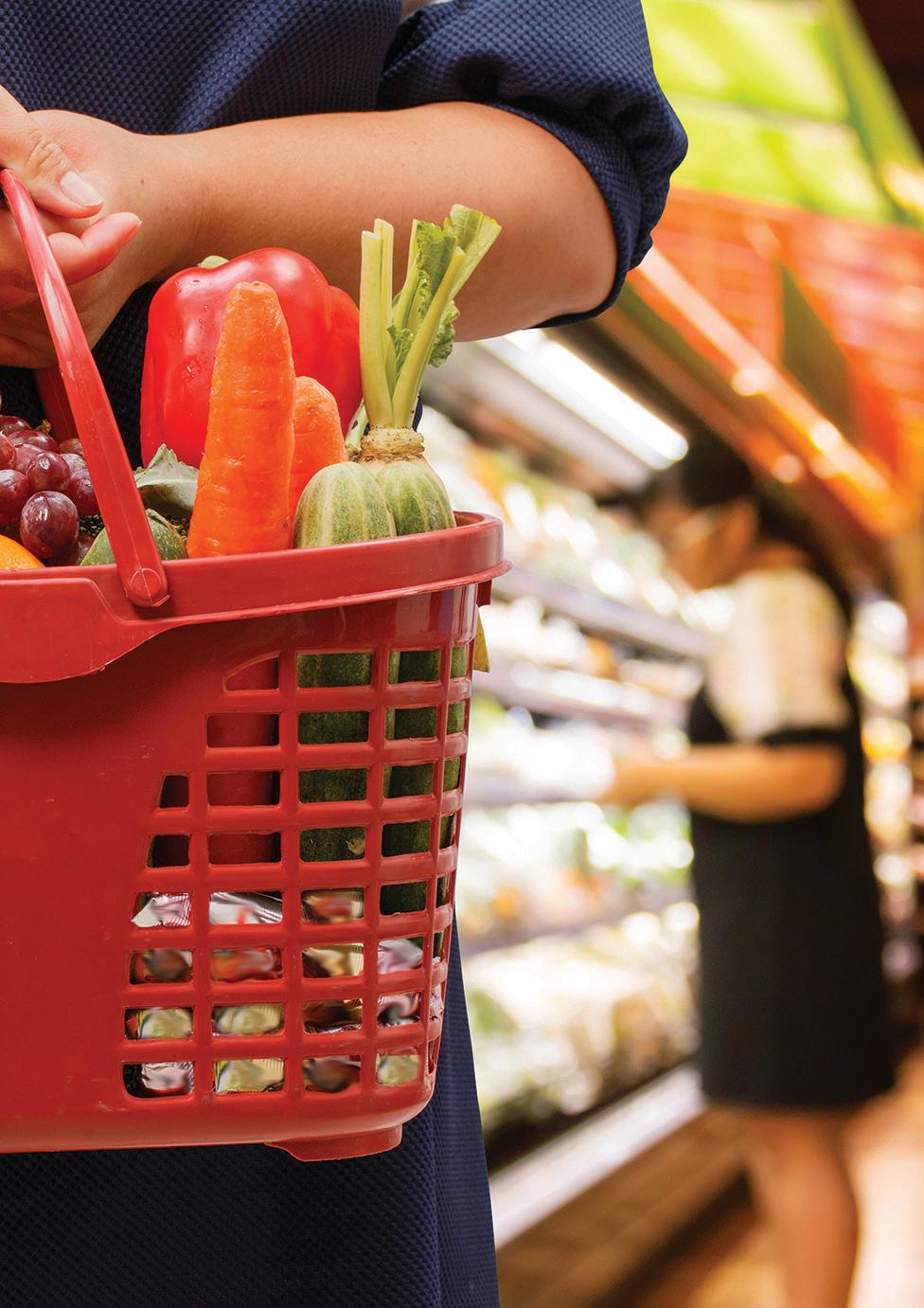
• 17% of shoppers ranked digital coupons lowest on their list.
• Digital coupons are leveraged most when shopping perimeter categories (e.g., produce, dairy, meat/seafood), while threshold events and endcaps are used most often when shopping center store (e.g., shelf-stable, drinks & snacks/candy).
• Lower-income shoppers cited digital promotions as the top way to save money, while higher-income shoppers gravitate toward threshold events.
• When it comes to threshold events (e.g., BOGO/spend x, save x), the most popular is “Spend $15, Save $5,” particularly for younger shoppers.
Other trends highlighted from the last quarter include:
• Store pickup is popular. While the majority of shoppers plan to shop in-store in the upcoming months, grocery pickup showed notable growth over the past quarter.
• Fewer shoppers report noticing price increases in dairy and meat/fish compared to the past year average.
• More shoppers notice price increases in drinks, while produce, frozen foods and paper products trended flat.
Research from Bazaarvoice explored where, what, when and how shoppers will make purchases this holiday season, especially during Black Friday and Cyber Monday weekend (BFCM).
• Shoppers prefer holiday shopping in-store (81%), but not by much: 72% said online and 22% said social media.
• Consumers want to learn about deals in certain places: Ads (64%) are where consumers want to hear about Black Friday deals most, but social media (46%), marketing emails from brands (46%) and news articles and gift guides (42%) are not far behind.
• Social media is a big discovery tool for BFCM: 49% of consumers said they follow brands on social media to discover Black Friday deals, 45% are more likely to discover a product via social media than any other channel over Black Friday, and 25% of shoppers prefer to shop via social media over BFCM. Sixty-three percent said they expect to discover new products on social media over BFCM.
• Reviews are a top priority across channels: Three quarters (74%) of shoppers agree that reviews impact their purchasing decisions, while more than half (59%) say the same about social media.
• Brands should be holiday-ready now: 11% already holiday shopped in July and 14% in August, while 19% will in September, 35% in October, 57% in November and 48% in December.
• Hot-ticket items this holiday season: 70% said they’re gifting apparel, 51% said games and toys, 47% said electronics, 40% said food and beverages, 37% said health and beauty and 36% said jewelry.
Where consumers are shopping for groceries and household items:
THE SPECIALTY GROCER HAS OPENED SMALLER STORES THAT FOCUS EVEN MORE ON THE EXPERIENCE FOR HEALTH-MINDED AND FOOD-CENTRIC SHOPPERS.
BY JACQUELINE BARBASpecialty grocery retailer Sprouts Farmers Market has opened a slew of smaller format stores in 2023 as it grows its physical footprint along the East Coast and focuses its store experience even more on health-minded and food-centric shoppers.


The retailer opened its first small-format store in 2021 in Smyrna, Georgia, and has continued to mold and expand the concept since then, particularly this year. Sprouts plans to have opened more than 30 of these stores in 2023 alone.

The Path to Purchase Institute visited one store that opened in May in Manassas, Virginia, and here is what stood out: Not only is this new format smaller in size, spanning about 23,000 square feet (compared to its 30,000-square-foot traditional locations), but it also features an updated Sprouts logo and decor, revamped signage, rotating displays and some expanded departments.
The stores offer a clean and spacious layout to make it easier for shoppers to discover “betterfor-you” products and convenient prepared food options. The stores’ smaller size may not be very noticeable to shoppers, however, because the space eliminated from its traditional store layout came mostly from the backroom.
At the center of the store, Sprouts’ selection of
fresh produce includes more than 200 organic offerings, many merchandised in wooden (or designed to look like wood) displays, promoting the fresh/ farmers market theme.
Particularly notable is an in-line display — or “Innovation Center,” as Sprouts calls it — located near the front of the store in between the produce and bakery sections. The area features “New for You” signage and highlights new-to-market, attribute-driven products, many of which are exclusive to Sprouts as part of its “Find a New Favorite” program (which rotates monthly).
Dedicated account-specific endcap signage on each end of the display spotlights the merchandised brand(s) and calls out attributes — at the time of our visit, “low-sugar vegan snacks” and other nutritious benefits. The section is a space for Sprouts and vendor partners to test new or local products. Four-way displays near this section also provide brands with shared merchandising space, especially newer, seasonal and healthier products.
Sprouts expanded and redesigned the frozen food section, which features wider aisles and is more intertwined with other aisles. It also particularly highlights innovative meal solutions, including keto, plant-based and paleo options. Additionally, at the time of our visit, in-store sampling was also conducted near the plant-based food freezers.
Other notable elements include:
• A relocated deli counter and conjoined “heatand-eat” meals display, which is now located closer to the entrance.
• A “Plant-Powered” refrigerated section high-lighting the latest plant-based meat alternatives.
• Sustainable and socially responsible offerings are highlighted throughout the store.
• The self-serve nuts and coffee sections are a staple and feature wooden bins and displays. Reusable branded Sprouts bags are also affi xed to the nuts displays, encouraging shoppers to “buy in bulk and save … a bag.”
• Branded displays are still sporadically located throughout the perishable aisles.

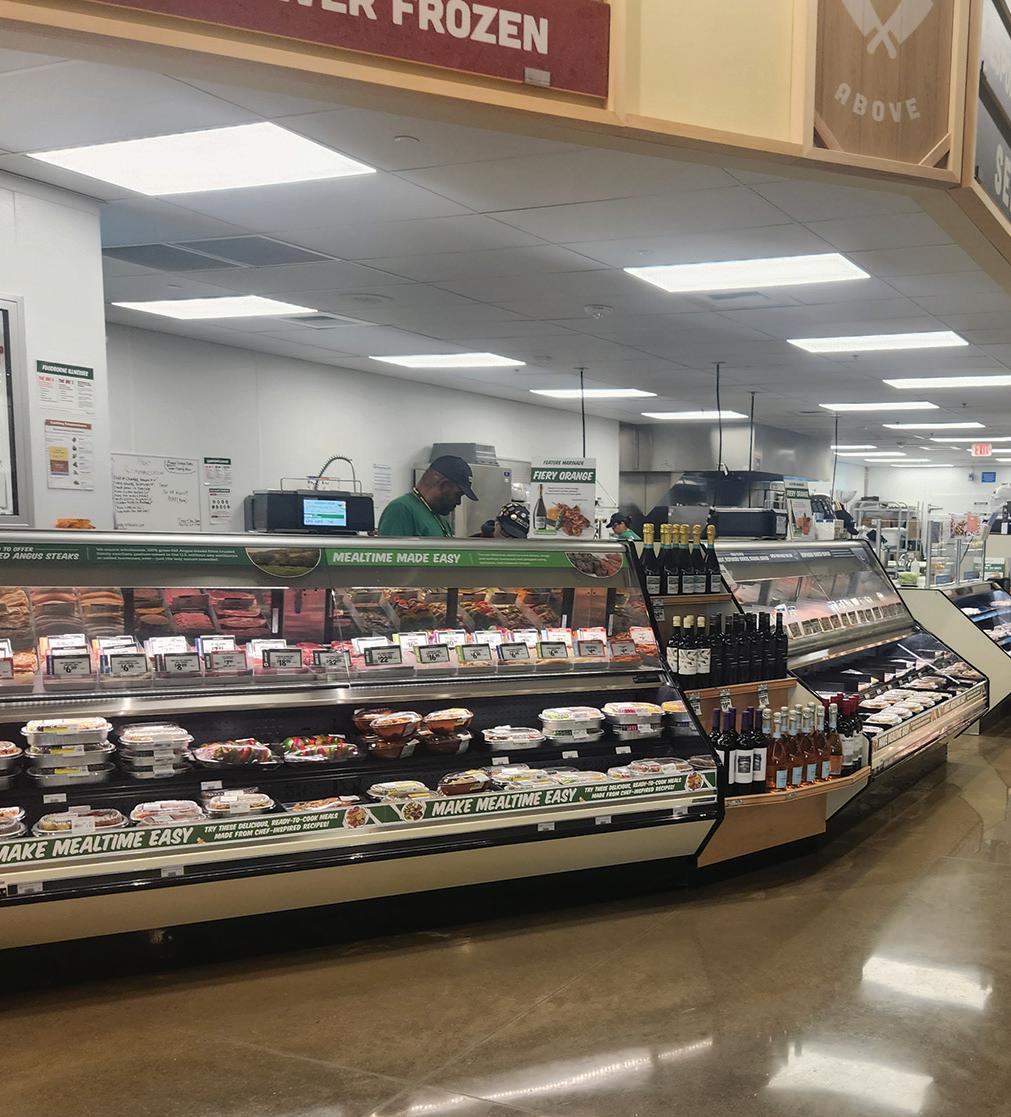

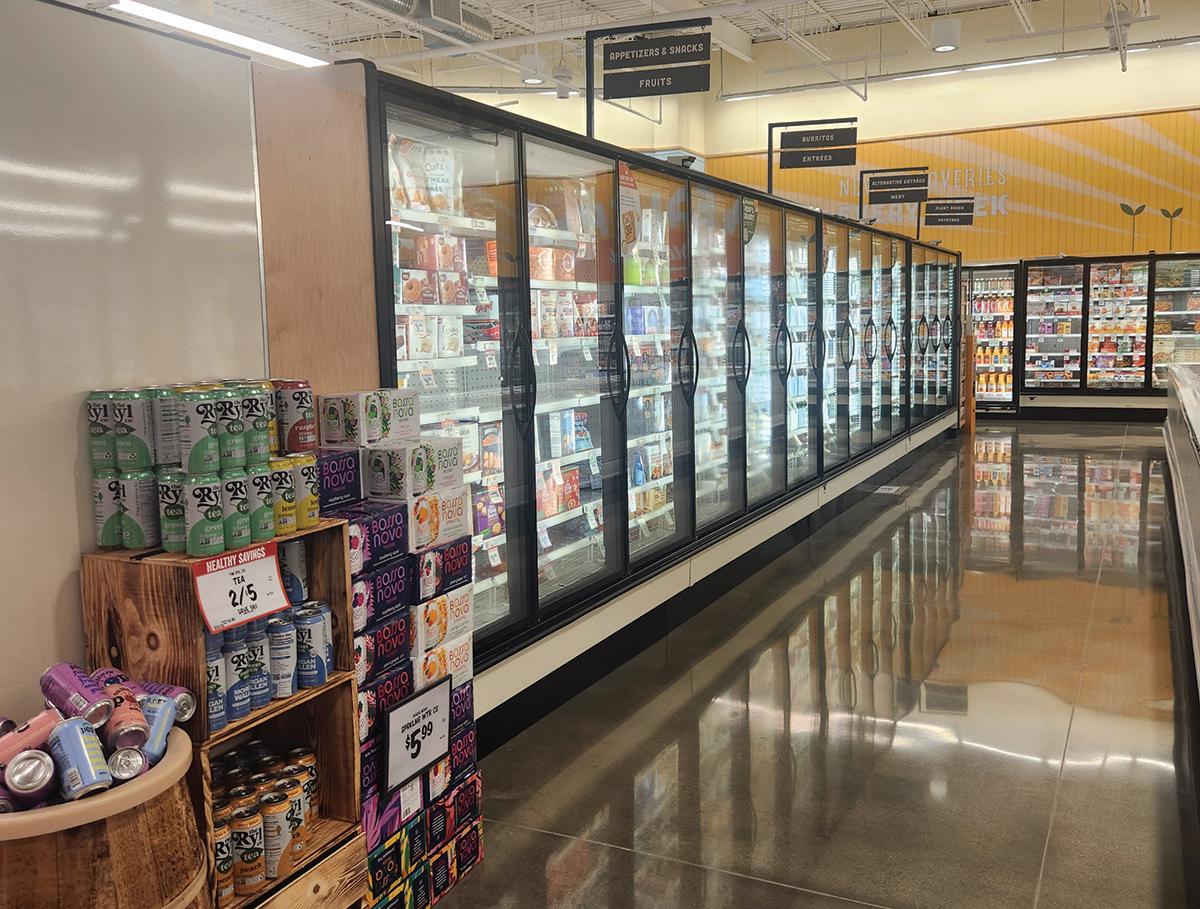
Artificial intelligence (AI) has been around and evolving for decades — but within the last year it has hit a fever pitch as it has begun unavoidably touching our daily lives with new tools and platforms. Consumers and professionals across numerous industries can’t seem to escape this hot topic of conversation.
For commerce marketing professionals, there are a plethora of questions regarding how AI will transform everything from processes and hiring to campaign execution, measurement and content creation.

This special report — based on a Path to Purchase Institute survey (conducted in July in partnership with Vizit) — begins to uncover the potential of AI when it comes to visual content creation. The respondents comprised 35 professionals who indicated that they lead or work in a role that includes visual content strategy, image creation, content syndication or measurement.
From the familiarity and adoption of different tools/services to AI budget allocations and the relevance of applications, this report reveals how AI is currently making a mark in CPG content creation. What does the future hold? Highlights include the perceived benefits and risks of using AI and how professionals see work habits changing in the year ahead.

OUR PROPRIETARY RESEARCH EXAMINES THE POTENTIAL OF AI FROM A MARKETER’S PERSPECTIVE, SHOWING HOW THEY PLAN TO MOVE FROM TEST-ANDLEARN TO FULL ADOPTION.In collaboration with
When OpenAI released an early demo of ChatGPT in November 2022, AI began to dominate social media and news headlines and took the content marketing world by storm. In our survey, familiarity with the concept of using AI for visual content creation and measurement was expressed by the majority of the survey respondents, with 46% saying they were very or extremely familiar. This demonstrates a cautiousness that is reiterated by the rate of adoption of AI tools and services. Three out of five respondents said they have at least experimented with using AI tools to support visual content creation and measurement. However, none of the professionals surveyed have fully integrated the available tools into their internal processes. The feedback on familiarity and adoption shows the industry has a big learning curve ahead.
Q. How familiar are you with the concept of using AI in the visual content creation and measurement process?
it.
we have experimented with AI tools but very much in the initial stages.
we have begun to use AI tools in some cases but have not fully integrated them.
we have fully integrated AI tools into our visual content creation and measurement process.
Q. Has your organization adopted any AI tools or services to support its visual content creation and measurement process?

effective
Q. Overall, how would you rate the effectiveness of the AI tool(s) or service(s) you have recently used to support the visual content creation and measurement process?


From tools that generate copy to platforms that measure and optimize images, there are opportunities to use AI to help with words, graphics, music, video and more. There are AI applications to support every step of the content creation process from ideation to creation to measurement.
Of the collection of AI tools and services available on the market, respondents identified the following as tools they are using or experimenting with: ChatGPT, Proprietary Tool, Vizit, Google BARD AI, OpenAI Dall-E, Midjourney, Stable Diff usion and Adobe Firefly.




The majority of respondents who have used one or more AI tools have found them to be effective — 62% of respondents said they are moderately effective while 10% found them highly effective.
With professionals recognizing the need to learn AI tools or be left behind, the creative world seems to be in an experimentation mode. This means teams need to invest time, energy and funds to explore AI with a trial-and-error mentality. While current budget allocations for AI-based tools or solutions are at a minimum (currently 5%), respondents expect a 15% average allocation in one year.



Based on their current familiarity with AI, respondents were asked to consider the relevant ways the technology may enhance or support visual content creation and management. Advanced analytics (80%), content testing and optimization (75%), content personalization and customization (74%), and content syndication selection (72%) were considered the most relevant.
When contemplating current versus future uses, respondents demonstrated a level of confidence in further exploration. Those who are currently using AI are most often utilizing tools to generate images, videos, and/or music (52%). Looking to the year ahead, there is a desire to use AI to support ongoing content performance measurement (66%), SEO recommendations (60%), advanced analytics (60%), and content personalization and optimization (60%). In addition to these areas of growth, all uses referenced in the survey — from image generation and editing to content testing and optimization, and curation of user-generated content — showed a projected 34% or greater usage. Only 6% of respondents said they don’t expect to use any AI tools or services.
According to respondents, the most compelling

Q. Which AI tools or services have you used or are you currently using to support visual content creation and measurement? (Respondents who indicated having used AI tools and services.)
Q. Which AI tools or services are you considering using to support visual content creation and measurement? (Respondents who indicated not having used AI tools and services.)
Q. What proportion of your marketing budget would you estimate is currently allocated to AI-based tools or solutions for visual content creation and measurement? What do you expect the allocation will be one year from now?
potential benefit of AI for visual content creation and measurement is the ability to improve campaign performance (52%). This was followed by the ability to leverage data-driven insights to optimize marketing efforts (40%) and expediting processes and enabling faster turnaround times (39%).
While there are perceived benefits to adopting AI, respondents are treading carefully due to potential risks and the numerous unknown variables. Seventy-one percent of respondents question the quality and authenticity of AI-generated content. This is followed by fears of potential liability concerns (63%), such as copyright infringement, as well as ethical










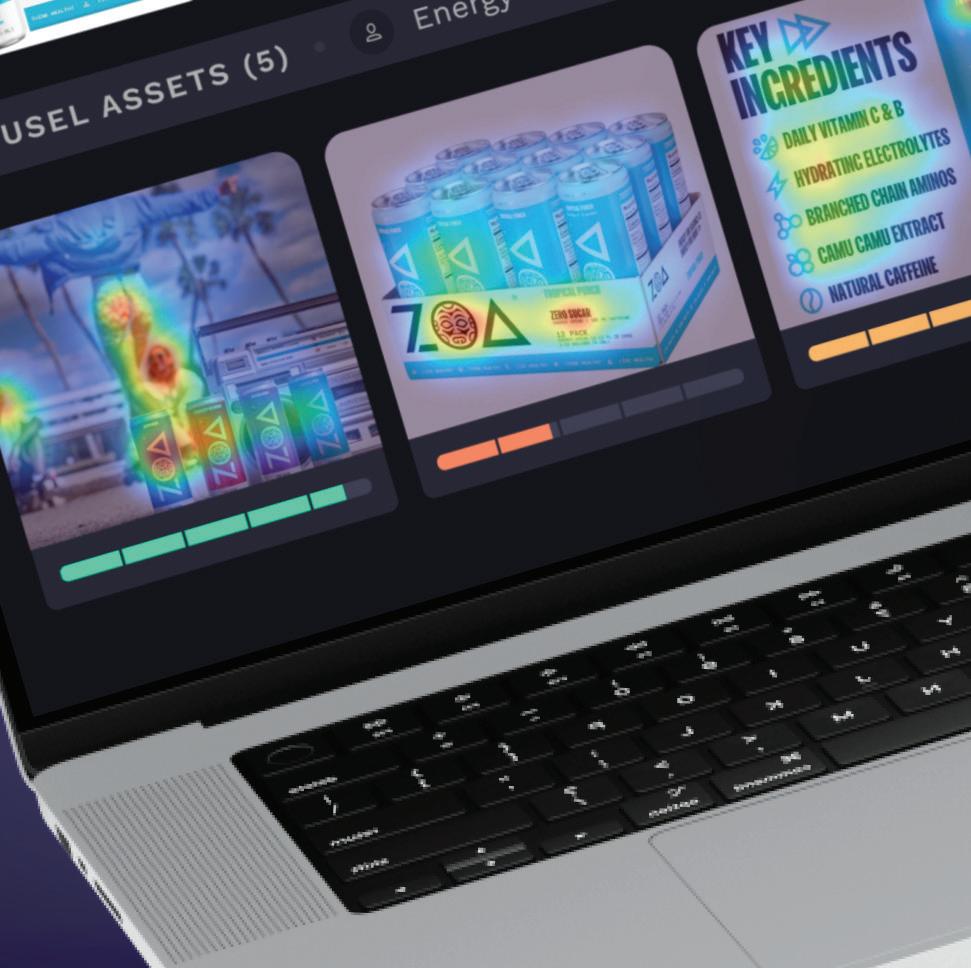
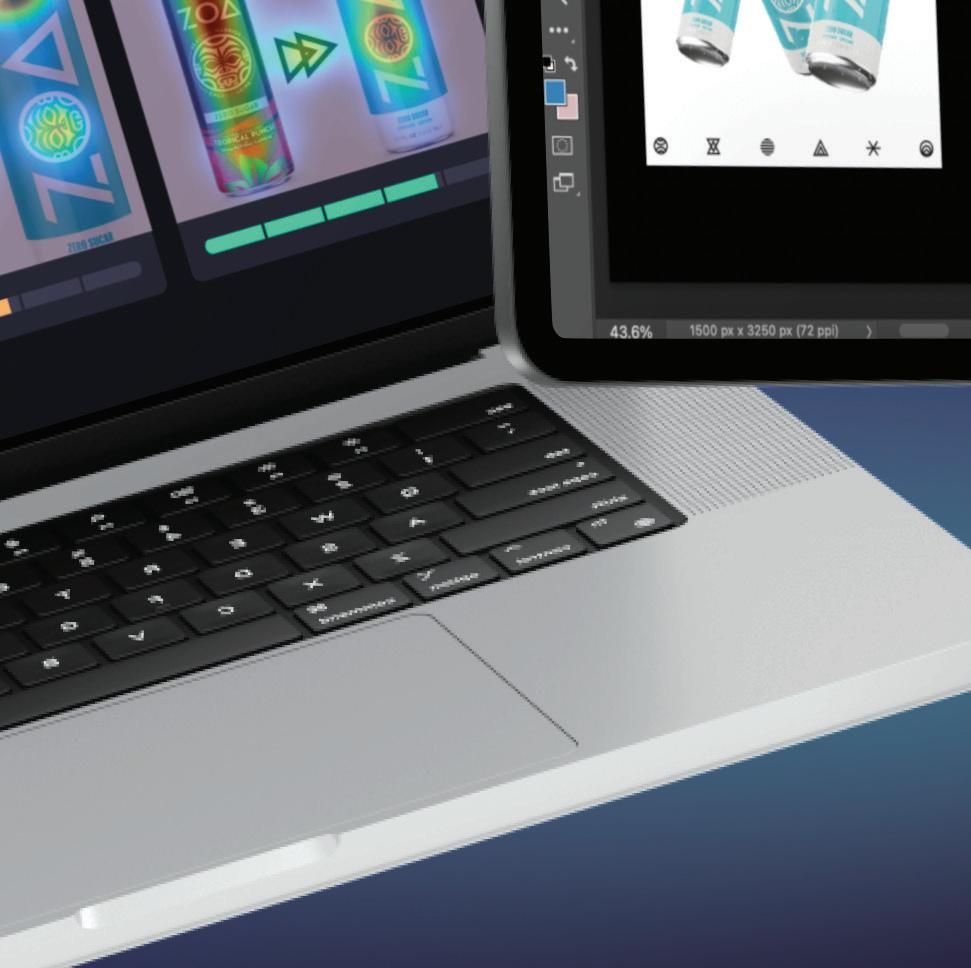




Q. Below are various aspects of the visual content creation and measurement process that AI tools may enhance or support. How would you rate the relevance of each of the following to your role and/or organization?
considerations (54%), data privacy and misuse of customer data (46%). With the emphasis on developing an authentic brand over the last decade, 63% are concerned about the misalignment of AI-generated content with brand voice, values and objectives.
Other concerns include the complexity of integrating these
tools into existing systems and processes, staff training and fi nding the right balance between human and AI collaboration. It is clear that the industry is in a phase of uncharted territory, which requires a commitment to exploring, learning, growing and adapting.
Respondents believe, like with all new technology, there
of images, videos and/or music
Image editing and enhancement
Creative ideation and concept development
Content testing and optimization
Content personalization and customization
Video editing and production
Advanced analytics to optimize content performance
Content syndication selection
SEO recommendations
Curation of user-generated content
Ongoing content performance measurement
Q. In which of the following areas are you currently utilizing AI tools or services to support? Which are you not using today but hope to be using by this time next year?
With all of the hype surrounding generative AI programs like ChatGPT, DALL-E, Midjourney and others, you’d be forgiven for wondering how AI fits into your content creation and execution workflows. But the recent survey from the Path to Purchase Institute and Vizit backs up what I hear in conversations with agency and consumer brand leaders: Professionals have high hopes for AI’s potential, especially as a tool to optimize the content creation and execution processes — and they’re ready to implement it in 2024.
The survey responses include a number of professionals who are hopeful that AI can help them be more efficient with their team’s time, so creatives and strategists can do what they do best. While some teams are experimenting with generative AI, many are more curious to find how AI can complement existing staff and structures. Several respondents call out the opportunity for AI to reduce costs and allow team members to focus more on creativity in e-commerce imagery, packaging and advertising.

We saw this reflected in the tasks and functions that professionals are hopeful AI can assist with in the visual content creation process. When thinking about how AI can enhance or support visual content creation and measurement, respondents saw most relevance in advanced analytics (80%), content testing & optimization (75%), content personalization & customization (74%), and content syndication selection (72%).
Applying AI to the measuring and testing side of content creation to free up time for employees is a far cry from the widely held belief that generative AI is coming for all writing and designing jobs. What’s driving the different opinions? Professionals may be wary of the quality of AI-generated content or could struggle matching generative AI outputs with brand guidelines. But an underrated factor may be the creativity and brand alignment that comes from your employees.
“AI is great, but trained creatives, writers and marketers bring unique, human ideas to the table that are valuable and personable,” one respondent said. Another respondent pointed out that younger generations today want authentic experiences
from the brands they frequent, and teams aren’t yet convinced that generative AI can deliver in that way.
This matches the conversations I’ve had with peers and Vizit customers, many of whom are intrigued by AI, but are fi rst and foremost focused on creating the best possible branded experience for consumers. They don’t need AI that will attempt to replicate their jobs. What they need is technology that gives them time and resources to focus on building and maintaining customer relationships.
We’ve seen this at Vizit for years. With AI providing the backbone of content analysis, e-commerce and design teams are free to spend their time doing what they love: creating, strategizing, designing and building out big ideas. If this is the future of AI — and it seems like a number of industry leaders want it to be — then weaving predictive AI into the fabric of your teams now is the best way to get ahead of the competition, win in an image-infused retail landscape, and retain and maximize your talent.

AI’s potential can only be fully realized when combined with the strengths of human staff. Bringing together AI’s efficiency and your employees’ creativity and emotional intelligence gives e-commerce teams a competitive edge by leveraging cuttingedge technology while ensuring customer-centricity, brand differentiation and ethical conduct. The future of e-commerce isn’t a battle between humans and AI — it’s about harnessing the strengths of both to drive success in the digital age.
Jehan Hamedi is the founder and CEO of Vizit. With more than a decade of experience in computational social science and artificial intelligence, Hamedi’s innovations have led to important advances in AI and computer vision, consumer insights and e-commerce, resulting in eight patents and an award-winning software platform.
Improve campaign performance
Leverage data-driven insights to optimize marketing efforts
Expedite our processes and enable faster turnaround times
Increase efficiency and productivity
Optimize our content strategy for better results
Create more visually compelling content
Improve targeting efforts
Create personalized content at scale
Reduce our outsourcing costs
Foster creativity, allowing for innovation and experimentation
Q. Below are some potential benefits organizations may realize from the use of AI for visual content creation and measurement. Which of the following are most compelling to you and your organization? Rank up to the top three most compelling benefits or write in your own.
will be an initial wave of fi rst adopters who will pave the way. Some believe these organizations will have an advantage. “There are many challenges in these beginning stages that may cause organizations to shy away from innovating with AI tools. Organizations that are able to effectively use AI tools will hold a tremendous advantage over those who are not,” said one respondent. “Early adopters who get effective results out of the tools will have more high-quality output with fewer resources.”
Another respondent believes a slow and steady adoption process is the best course of action, including a meticulous analysis of the integration into the organization. “I think overall it will be a slow adoption process following a crawl/ walk/run approach. There will be early adopters, but ultimately slow and steady wins the race. Organizations will need to methodically track and measure the accuracy of the content and data generated to ensure it is on par with the level of human-generated content. A rigorous evaluation process will be needed to ensure accuracy.”
Survey respondents indicated that CPG organizations will embrace AI tools at varying levels, while figuring out the best uses to support visual content creation. Respondents believe many companies will start utilizing AI more frequently in the next year.
“I see the next 12-18 months as a test-and-learn phase where we’ll begin to see the potential impact,” said one respondent. Others in agreement believe there will still be some apprehension on full adoption.
From automating menial creation tasks to reformatting base
creative to different specs and offer messaging, respondents see the potential of AI to improve team efficiencies. Rather than a fear of AI taking human jobs, a more positive outlook sees AI freeing the team up to focus on creativity.
On a broader scale, one respondent said: “More companies in the industry will adopt AI for a wider variety of applications, so content creation and personalization will be streamlined and become more efficient. AI will also become involved more robustly in the development of strategy and help drive direction, making its fi ngerprint ubiquitous across all content consumers engage with.”
Striking the right balance between human creative talent and AI tools and services will be a focus in order to authentically connect with consumers and maintain the integrity of a brand. “I think AI will be used by a majority of brands/agencies to drive efficiencies and ideation; however, there will have to be a balance between human and AI content development. The industry will learn what that right balance is to leverage AI most effectively. If they do not, the risk is coming across as inauthentic to the consumer, which could be detrimental to the brand.”
The industry will learn what that right balance is to leverage AI most effectively. If they do not, the risk is coming across as inauthentic to the consumer, which could be detrimental to the brand.
— Survey respondent











Marketers from around the world provide perspective on the path to purchase. Our report includes interviews with marketers from Brazil, Mexico, Panama, Spain, Switzerland and the U.K.
BY ERIKA FLYNNLocation: Zurich, Switzerland
Advisor, Independent Consultant, Athoria Consulting; NonExecutive Board Director, Clas Ohlson, Viva Wine Group. She works globally, with a focus on Europe and the Nordic region, Swedish/Norwegian National.

Shopper behavior: “Since the [Russia-Ukraine] war started, I’ve observed a number of changes in people’s behaviors and I would say these are typical across multiple markets. Shoppers have become more price-sensitive and less impulsive in purchases. The downtrading is clear, and there is a reluctance in spending. Shoppers think and behave differently depending on the category: small-ticket items are less impacted; larger ticket items are more impacted and purchases are put off. Consumers continue to need ways to balance their mental state and be happy. As an example, wine consumption is shifting to slightly less expensive wines or, in the Nordic region, bag in box, while volume is staying pretty much the same.”
T he path to purchase: “The shape of the consumer journey
has not changed, but the importance of a step might have. An example from consumer durables is that more research and investigation is done up front, and planned purchases are postponed, whereas distress purchases (when an appliance has broken) will still take place. It’s very important to adjust actions and, for instance, offer different payment terms (often happens via retailer) or offer guarantees. Consumers and shoppers want to a greater extent to be heard and understood, and there is less tolerance for friction in the consumer journey. We need to know their pain points and address them immediately, or we risk losing a shopper or consumer who has been loyal previously.”
Brick-and-mortar stores: “Campaign intensity is high in Sweden right now. Some stores are incredibly cluttered and difficult to maneuver for shoppers. The risk is that shoppers stop to engage with anything when campaign intensity is high. The store and many activities become wallpaper, and shoppers become task-oriented and de-select the many messages. The retailers who know their shopper base well — and can adjust and ensure they focus on what is most important to their most important and loyal shoppers as they enter the store — will win.”
Internal/external technologies: “Machine learning and AI are at the forefront of technological breakthroughs transforming the insight and analytics industry. When companies are analyzing huge amounts of data and consumer feedback, they can gain a lot of efficiencies from automation.”
FELIPE BRAGA

Global Director, Category Commercial Strategy, The Coca-Cola Co.
Shopper behavior: “The primary variable in recent years was inflation. In many countries, it was the first time a generation faced rising prices. The differences between low-income and high-income consumers becomes more pronounced, and shoppers may switch to cheaper alternatives, delay purchases or focus on essential goods. The industry must think of solutions in product, service and communication for those distinct audiences, eventually bringing more complexity to their business.”
E-commerce: “Artificial intelligence (AI) and machine learning, in particular, are increasingly pivotal in offering tailored experiences, product recommendations and customer service. The growth of mobile commerce is also critical. Businesses are optimizing their websites for mobile use and launching dedicated apps to enhance product discovery
and ease of purchase. Instagram’s Shop Tab and Pinterest’s Shopping Feature have revolutionized how consumers discover and buy products, which has placed greater emphasis on the importance of engaging, authentic content that caters to a diverse and informed audience.”
Brick-and-mortar stores: “Retailers are embracing technology to enhance in-store experiences and facilitate seamless transactions, and use data analytics and inventory management systems to optimize store layouts and offerings. The integration of online and offline retail, or ‘omnichannel retail,’ has emerged as a vital strategy, enabling businesses to sync their online and in-store inventories and allow customers to buy online and pick up items at a nearby store, thus leveraging the advantages of both platforms. The future of brick-and-mortar retail lies in the successful adaptation to and integration of modern technologies, consumer preferences and sustainable practices.”
Retail media/retailer media networks: “Retail media networks have been experiencing global growth as they increasingly become essential players in the future of commerce and marketing. We should expect a greater prominence of formats such as video and native ad placements, better sales attribution models to measure return on investment and engagement, and integration of more advanced technology to optimize ad targeting and improve campaign performance.”
Location: London, England
Head of Shopper, pladis
Shopper behavior: “There are so many different ways in how we shop, buy and behave today because there’s so much more opportunity than ever before. Shoppers have become fickle, and while they may have been brand loyal before, they aren’t any longer. Since COVID-19, people are more demanding and choosy because of the opportunities available to engage with products. The cost of living crisis has defi nitely impacted shopper behavior as well, but demand would have happened regardless in the U.K., with shoppers now having more time to think about their purchase behaviors.”
The path to purchase: “It is so squiggly right now in the U.K. in terms of how customers interact with products and brands. There are so many different interactions before you physically pick up an item, or have it delivered to your door. It has morphed into a whole digital experience and is getting more sophisticated than a traditionally simple shopping experience.”
In-store shopping: “Customers want to have more of an experience that is convenient for their lifestyle. Because the world has shrunk in terms of what is available, variety is crucial in-store and customers want to see interaction. Experiences received online or digitally need to be replicated.”
E-commerce: “There will be a saturation point. During the pandemic, e-commerce saw a huge spike but has plateaued since. While quick commerce is a great idea, it’s consolidating and doesn’t drive much business. It’s shown that it’s not for everyone. There is a fi nite amount of people who are prepared to shop through e-commerce, and it may not grow any more than it is today as generations weave in and out of life stages.”
Retail media: “This is absolutely bonkers at the moment and we expect it to only get bigger as the cookie dies. We’re working more and more with agencies and retail media networks that have been collecting data for a long time. It helps retailers make money, and we know that it delivers. While it can be pricey, retail media networks have done a great job — so much so, that more people across the business are realizing how powerful it is. We’ve been doing some great things with partners so far, but there’s so many more opportunities for us to target shoppers, and it’s really exciting.”
Web3/the metaverse: “It’s in the early stages for us and we work closely with agencies and teams to be guided in how best to use it, demonstrating what it can return for us and why it’s the right thing to do. With so much happening across the industry, it feels big and scary, but we’re here to learn.”
in driving better value and brand choice.”
Location:
Head of Insights & Analytics, MENAP, Mondelez International


Shopper behavior: “Middle East, North Africa and Pakistan (MENAP) is a cluster of markets with diverse retail structures. We have Egypt and Pakistan with high traditional trade presence and then markets like KSA and UAE with sizable modern trade presence. The challenge across markets is quite diverse for us. However, one thing that binds across markets is the pressure of inflation on shoppers, and the choices they are making depends on the role of category/brands in their daily lives. Hence, when we think of in-store, interrupting shoppers and reminding them of the moment of consumption, bringing to life the occasion becomes critical, be it via POS material or via adjacent category placement. Shoppers are also increasingly prioritizing convenience in MENAP markets, leading to growth of online shopping platforms. With the context of high inflation, dialing up some of these aspects automatically helps
The path to purchase: “With shoppers actively looking for deals/value, pre-store touchpoints do influence shoppers, and being present on retailers’ online platforms and fl yers is becoming as important as presence in the promotion area. Also, with the clutter increasing in the promotion area, it is more important than ever to stand out with the POS that brings to life the consumer occasion. Magic price points alone are not enough. Given that shoppers are spending a lot of time in the promotion area, they might also skip some of the aisles. Identifying cross-category placement based on high shopper basket incidence and synergy with our brands also plays a key role to drive multiple touchpoints for the shoppers in-store.”
E-commerce: “E-commerce is one of the fastest growing channels in MENAP, where we see new players coming up across markets and the established players (retailers) consolidating their position by investing more to give an omnichannel experience for shoppers. It’s important that we don’t try to make it one size fits all. For us, UAE is the biggest market in terms of e-commerce penetration, and we have built our strategy focused on individual channels: omnichannel, pureplay and last-milers. We have seen shoppers going for distinct needs in each of these channels, so it is important to replicate the same from an assortment/activation/pricing point of view.
Location: Santa Fe/Mexico City, Mexico
Manager Shopper Insights, Mondelez Snacking Mexico

Shopper behavior: “Due to an inflation of approximately 5.5% and price increases of 12% within the market, shoppers are pushed to look for more options to distribute their spending. They are losing loyalty in modern trade formats and looking for more retail environment options, where discounters are the only format having a growth in number of stores. In that way shoppers make their shopping basket more efficient, looking at larger sizes or private-label options even in food products, which is a new behavior versus previous years.”
The path to purchase: “Shoppers are prioritizing categories to keep the basic supplies at home and are becoming more savvy about value per money, even adding more trips to fi nd the best options for their baskets.”
In-store shopping: “Secondary displays are more relevant to select than main aisle by 20% more, where they know the



E-commerce: “Grocery shopping is gaining relevance year by year, and where last-milers took the lead during the pandemic, in recent years brick-and-click, pure players are now more relevant due to safety in their shopping experience, better prices and promotions, and better navigation within their platforms.”

Brick-and-mortar stores: “Physical stores are still the most important channel to do shopping, but we are seeing a reduction in hypermarkets in store space with the leasing of extra spaces to other businesses like gyms, cafeterias, etc. Also, we are seeing a growth in discounters. These stores are evolving into brick-andclick to become more digital, adding spaces for pickup parking, and jumping into the trend to become more frictionless shopping.”
Successful activity: “With insights around the globe and taking a step forward in payment seamless trends, we track the best way to place our products in the self-checkout area, understanding the shopping trip in the hot zones, and thinking about ergonomics that all products should fit in our arms without bags.”
Web3/the metaverse: “Defi nitively we have to pay special attention to younger generations that can connect and socialize in different manners with our brands and people. Digital transformation is pointing to metaverse actions in the near future.”
Shopper behavior: “It has changed more in the past three years than in the last 10, driven by cost of living, the pandemic and changes of weather. It is much more volatile and dynamic because of our ability to learn and relearn, which can only make us succeed and not take anything for granted. Where consumers shop and how they make decisions is changing more often than before.”
The path to purchase: “We would previously run massive campaigns with a single media touchpoint doing the job to get customers to a supermarket, but that’s just not true anymore. How consumers interact with media changes over time, throughout the week, based on the weather, etc. It’s way more complex than before so we need to be working more cross-functionally with the consumer at the forefront of our minds.”
In-store shopping: “This is an interesting one with HFSS (regulations in the U.K. regarding foods high in fat, salt and
sugar), the rise of discounters and the pandemic, which has encouraged us to invest more in in-store theater to create excitement for customers. We expect to see entertainment instore coming back. The touchpoints today are more effective, impactful and digitized, and there’s been a greater investment from retailers, along with brands that want to inspire more at shelf. Haagen-Dazs used to invest in creating huge experiences but at a lower return. We’re now clear on what our bread and butter is to fi nd the next key moment and then go above and beyond. This became even more important than before with HFSS, and it’s the same for every brand.”
E-commerce: “It will no doubt continue to be the future and there will still be growth, but there may not be the same level of over-investment that we saw previously. We have seen retailers get more agile and flexible in what they can do on e-commerce as a test-and-learn, inspiring grocers on their instore approach via meal deal opportunities, for example. Ondemand grocery channels are exciting, but they don’t have the scale yet, and the proposition needs more time.”
Retail media: “We’re talking about it more than we ever did before, and know that there are a lot of new opportunities available. While we think the U.K. is ahead of many other countries, there’s still a lot to learn from the U.S. We’ve partnered with retailers here, especially after COVID-19 to get closer to shopper behaviors, but we could still do more to continue to learn and test opportunities. Each retailer is at a different stage in their journey with retail media networks.”
Location:
Shopper behavior: “The big thing in the U.K. at the moment is the cost-of-living crisis, which is driving a massive awareness of value and price among shoppers. Retailers are responding by offering special discounts through member pricing and loyalty cards. ... Of course, in turn, retailers are using that data to drive their retail media networks and protect or grow their margin.”
The path to purchase: “We see the path to purchase as continual movement between different mindsets. As a result, we’re combining media to drive brand awareness, while also having embedded calls to action. The measurement of that provides the way forward. Customers are bouncing around what we call the ‘messy middle,’ becoming aware of new brands and purchasing them very quickly. The brands that do really well are the kings of that messy middle; they’re able to reach customers at those specific points and drive a purchase in a seamless way.”
E-commerce: “E-commerce growth has returned to the natural curve that we saw pre-COVID-19, but it differs by category. We expect its share of sales to grow to between 25% to 30% in the next five years as its capabilities grow. Those new capabilities will play a really important role in the future of retail and those companies that are investing heavily behind it are winning.”
Retail media/retailer media networks: “All the major players in the U.K. are now starting retail media networks. Retail media is now able to go further up the funnel and through that messy middle, so we’re starting to see more value in utilizing some of the traditional budget in retail media or retail media influence channels. Brands are starting to consider retail media as an integral part of their overall communication strategy, beyond just how they deal with the store. Those that provide a full omnichannel experience that’s driven through fi rst-party data and ties the awareness channels in with the conversion channels in a seamless way will win.”
Keeps you up at night: “The lack of transparency in retail media in general, and the impact that could have on the future of the business. Unless we can create the right standardization of measurement, and the right transparency and truth in activation, we’re not going to see the full potential of the industry realized as quickly as we should, because brands will become despondent with the results they’re seeing and question the investments they’re making.”


Shopper behavior: “In my journey within the FMCG and pharmaceutical sectors, I’ve maintained a laser focus on shopper behavior. This isn’t just about data collection; it’s about actively listening to the shoppers and putting ourselves in the shoppers’ shoes, grasping their motivations, aspirations and pain points. Only then can we design strategies that not only catch their attention, but also genuinely address their needs.”
The path to purchase: “It has evolved from a linear process to a multifaceted and complex journey. Consumers interact with diverse touchpoints across various channels before making their fi nal decision. Mapping people’s journeys transcends the surface level. It involves pinpointing the critical ‘aha’ moments— those instances where consumers experience a significant shift in perspective or make pivotal decisions. These moments of insight often hold the key to crafting strategies that truly resonate.”
In-store shopping: “In-store shopping has demonstrated remarkable resilience. The essence of physical shopping experiences — the tactile engagement with products, the sensory exploration and the immediate gratification — remains irreplaceable. It’s not just about purchasing products, but about creating memorable interactions. It’s evolving, and companies are embracing technology to enhance the experience rather than being overshadowed by it.”
Brick-and-mortar stores: “They possess a distinct advantage in providing tangible interactions that digital platforms cannot replicate. The natural market sector places strong emphasis on merging physical presence with exceptional service, accentuating this advantage. By crafting immersive environments that stimulate the senses, these stores forge meaningful connections and enduring relationships between customers, products and brands.”
Keeps you up at night: “Navigating constant change. New technologies emerge, consumer preferences shift, and market dynamics transform. Staying ahead of these changes requires perpetual adaptation and innovation. The ever-changing landscape is both a challenge and an opportunity.”
Current AI work: “From analyzing vast amounts of shopper data to gaining insights into consumer behavior, AI has become an integral tool in my toolkit. By harnessing AI-driven analytics, we’re able to uncover valuable trends, patterns and predictive insights that shape effective strategies.”
Location: Panama City, Panama
DAMIEN RINJONNEAU

CMI (Consumer Marketing Insights) Manager, Nestle
Shopper behavior: “In Central America, price increase is the population’s No. 1 concern, and shopping decisions are more than ever driven by prices. When inflation started, shoppers began to organize themselves to control their spendings and purchase in a smarter way, but the second wave of price increases pushed them to shift toward value for money and promotions. They are visiting more channels and spending more
time at the point of sale in order to analyze, compare and find the best deals. Households facing double-digit inflation in lowincome countries made sustainability and health claims slightly less important. These shopping behaviors vary among income groups, with higher socioeconomic levels opting for bigger packs while lower levels shift even more toward lower out-of-pocket.”
E-commerce: “Even though e-commerce sales have exploded during the pandemic, they remain a marginal percentage of food and beverage sales. The main barriers are higher perceived prices, on top of the delivery fee, and overall experience with a lack of physical interaction with the products and problems with the delivery (errors, damaged products or about to expire, etc.). E-commerce remains an interesting touchpoint that some shoppers use to compare prices and fi nd the best deals before shopping offl ine. Interestingly in this region, sales through WhatsApp and phones remain higher and are the preferred option for lower socio-economic levels.”
understand better what’s happening across the entire path.”
In-store shopping: “It is getting relevant again in Europe, and shoppers are requiring omnichannel experiences.”
Brick-and-mortar stores: “This is the biggest channel with a lower growth trend, but the most relevant in Europe in customer mix.”
Location: Madrid, Spain

E-Commerce Digital Content and PPA lead Europe, Mondelez International

Shopper behavior: “Consumers have much more info online than in traditional channels.”
The path to purchase: “We are now able to measure and
Retail media: “It is getting more relevant for retailers as a new source of profit compensating extra delivery costs.”

Keeps you up at night: “A new end-to-end digital shelf project that I am leading globally.”
Successful activity: “We have seen great improvements in search due to titles improvement in relevant customers.”

Internal/external technologies: “Mainly AI, as well as content management tools such as DAM, PIM.”
media capabilities and use them as important touchpoints for omnichannel experiences. Retailers are also looking at how they can creatively improve the shopper experience in stores. They are leveraging key categories to make them more impactful at stores, giving more space, improving merchandising, assortment, P-O-P, etc. ”
Location: Mexico City, Mexico

Senior Director, Digital Commerce Mexico & Latin America Capabilities, Colgate-Palmolive
The path to purchase: “After the pandemic, Latin America increased not only the number of smartphones, but also the number of apps/social media used by consumers. Therefore, it is becoming more nonlinear, as the consumer journey starts and ends everywhere.”
In-store shopping: “It continues to be the strongest habit among Latin American shoppers. However, more and more they use digital tools while they are shopping. Some retailers are also leveraging technology in-store to strengthen their retail
E-commerce: “It’s still one of the fastest growing channels in Latin America. Growth is coming not only from more mature digital commerce categories (e.g., electronics) but also from FMCG categories. Omnichannel experiences need to be a priority for both retailers and suppliers since, as mentioned before, the consumer journey starts and fi nishes everywhere.”
Retail media: “With the retail landscape in Latin America — pure players such as Amazon and Mercado Libre, omniretailers such as Walmart, Carrefour and Cassino, strong local ones, and last-milers such as Rappi, iFood and Uber that exploded during the pandemic — we see that almost all types of retailers are trying to do something on retail media. Currently, there are different stages of maturity in terms of retail media capabilities across the region.”



 BY JENNY REBHOLZ
BY JENNY REBHOLZ
s the end of 2023 draws near, brands and retailers are addressing strategic plans and 2024 marketing initiatives.
Shopper insights provide valuable information for these planning efforts, reinforcing successful strategies and shedding light on areas for innovation and improvement. How has the in-store shopping experience evolved over the past year? What challenges and opportunities lie ahead?
The Path to Purchase Institute’s July 2023 “Engaging Shoppers In-Store” survey, conducted in collaboration with Mood Media, gathered responses from 1,000 shoppers varying in age from 18 to 56 and income levels from less than $35,000 to $150,000 or higher. The qualifying participants reported shopping in-store in one or more categories of interest, ranging from grocery, health and beauty and department stores to fashion/clothing stores, luxury, quick service/fast food, specialty stores and automotive dealerships.
This report shares insights on in-store shopping habits and drivers, including in-store physical and digital details influencing shopper satisfaction. The report also highlights opportunities for brands and retailers to capitalize on consumer shopping habits and expectations to increase in-store shopper engagement.
Similar to shopping patterns recorded over the past few years, the survey respondents reflect a combination of in-store and online habits. Instore-only shopping accounts for more than 32%
I know exactly what I’m looking for and try to spend as little time as possible inside the store.
I have a shopping list but often enjoy browsing as well.
I have a vague sense of what I need but usually spend time browsing the store.
Q. When shopping in-store at each of the following, which typically best describes you?
of shopping practices across categories, with 52% of respondents saying they shop in-store only at grocery stores. This is closely followed by quick-service/ fast-food restaurants at 47% in-store only. Despite the evolution of shopping options in the automotive industry, it is interesting to note that 69% of shoppers say they have visited a car dealership within the last year.
Consumers shopping in-store seem to be organized, focused and timeconscious. Forty-four percent or higher across categories said they know exactly what they are looking for and try to spend as little time as possible inside the store. This suggests brands need to grab shoppers’ attention before
Q. In a typical month, do you shop at any of the following stores, either in person or online?
Q. Which of these stores do you shop at in person in a typical month?
Ability to see products in person/interact hands-on
Discovering new products
Being able to go shopping with friends, my significant other and/or family Immediacy of purchase/instant gratification
Easier to navigate/find products in-store than online
Wider selection of products
The overall atmosphere and experience
Learn more about the brands available Interaction with/assistance from the shop staff
A stronger sense of, and ties to, the local community Tech-enabled experiential offerings/interactivity
Q. What are the most important reasons why you may choose to shop in a physical store rather than online, if any? Select all that apply from the list below or write in your own response.
they head in-store, so consumers are confidently looking for their products. In fact, three out of five shoppers say they often seek out brands in-store after seeing their ads online.
While a higher percentage of shoppers seem to take the focused approach, other respondents admit to taking time to browse while in-store no matter their intended purpose, and some approach shopping with a vague sense of a list and time allotted for browsing. It is relevant to note that male shoppers are significantly more likely than their female counterparts
to say they try to spend as little time as possible inside stores, across nearly all categories.
Despite the tech-driven state of the world, there is still a desire to see and touch products in person. According to 52% of respondents, the ability to see products in person and engage in hands-on interactions is the most common reason for in-store shopping. Other motivations for consumers to visit physical
Has a pleasant scent
Interactive digital screens or tablets where you can customize, personalize and/or configure products
Supporting sustainable practices in-store
Interactive digital screens or tablets providing in-store access to all the same search and discovery tools that are available online
Hosts brand-relevant and/or community events
video walls to bring products to life
and/or virtual reality
Digital screens which provide inspirational content, information about products and/or atmospheric images
Incorporates branded music playlists and sound
Q. How important would the following factors and/or characteristics be to you if choosing to visit a physical store?
Connecting consumers with brands to shape perceptions, activate behaviors, and drive business results through on-premise media solutions.
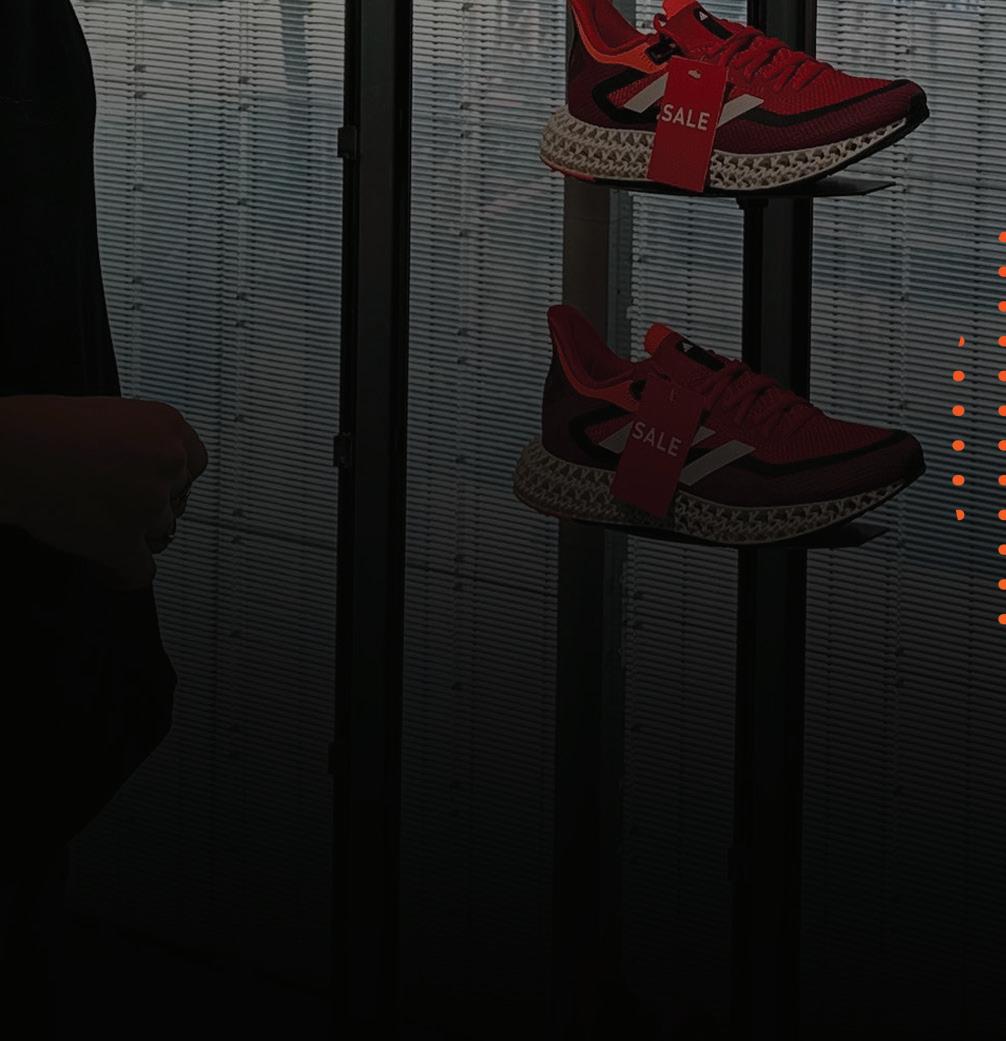

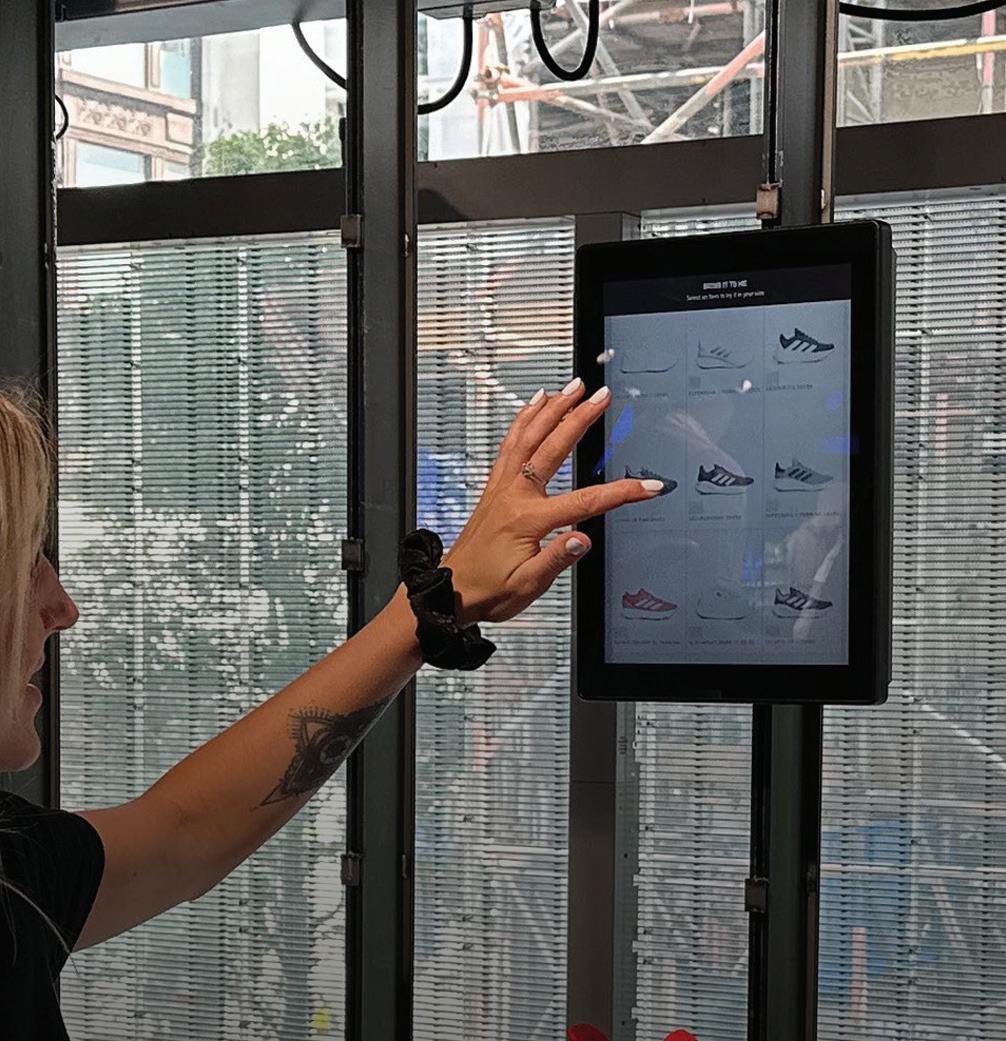

Learn More about Mood Media, the world’s leading experiential media company, as we redefine the on-premise customer experience and deliver unparalleled value to businesses and brands globally. moodmedia.com





stores are to discover new products (37%), to enjoy shopping with friends and family (36%) or for a sense of instant gratification (35%). Some respondents also consider it easier to navigate and fi nd products in-store vs. online (35%).
Male shoppers and those with higher household incomes were more likely to reference ease of navigation, the overall in-store atmosphere, the ability to learn about available brands and interactions with shop staff as driving factors for in-store shopping.
These connections to the physical store reinforce the need for brands and retailers to continue to invest in in-store enhancements. From refi ning floor plans to support ease of navigation and intuitive wayfi nding to enhancing the sense of discovery, amping up the overall experience for learning, entertainment and enjoyment remains valuable for capturing consumer attention.
Other important drivers influencing the decision to visit physical retail include everything from the scents and sounds within a store to technology integration. Consumers are also interested in the sustainable practices of retailers and the scheduling of brand-relevant or community events. All of these factors were considered very or extremely important by at least 50% of respondents. Sixty-five percent identified the pleasant scent of the retail environment as impacting their decision to visit a physical store.
Likewise, an overpowering or unpleasant scent was cited by 39% of respondents as a cause for avoiding or leaving a shop. A lack of product information, the visual appeal of the store and the noise levels, both too loud and too quiet, were also referenced as reasons to avoid or leave a retail setting.
Video content that doesn’t seem fitting for the store or is unpleasant to watch Music too loud
Too many screens with video content
Too quiet in the store
Don’t like the music being played
Q. When thinking about shopping inside stores, which of the following cause you to avoid or leave a shop, if any? Select all that apply.
I enjoy seeing or hearing about the products available at retailers and am open to considering purchasing them during my shopping trip
I enjoy seeing or hearing about the products available at retailers and may consider purchasing them during future trips, either in-store or online
I don’t usually pay much attention or notice the product information or messaging when shopping in-store
I find in-store product information or messaging intrusive, and it takes away from my shopping experience
Q. When thinking generally about the information or messaging you might see or hear inside stores, which of the following best describes you?
I like when retailers’ in-store information or messaging suggests new products that I haven’t heard of before. I am often reminded of products I have considered purchasing by information or messaging inside stores.
I often make purchases based on seeing a sign, display, video, etc. in a retailer’s store.
I rarely pay attention to in-store product information or messaging.
I feel like most in-store messages are not relevant to me.
Q. When thinking about shopping in stores, how much do you agree or disagree with each of the following statements?
At the forefront of retail transformation, shopping experiences extend beyond transactions to become immersive and interactive journeys. The power of hands-on engagement, personalized connections and seamless technology integration across diverse retail landscapes drives the shift from passive encounters to vibrant interactions.
More than half of shoppers, especially Millennials, enjoy browsing when visiting stores. Understanding shopper behavior is key to maximizing on-premise experiences. Enhanced engagement, personalized offerings and trend adaptation are essential in building unwavering customer loyalty.
Mood Media’s recent “In-Store Shopper Engagement” report with the Path to Purchase Institute dives deep into the consumer shopping pulse, analyzing data from 1,000 individuals spanning income levels, generations and genders.

Shopping spaces should transcend the ordinary to meet demand, making products more than items on shelves. Every touchpoint should encourage customers to explore products, forge connections and fi nd inspiration. Mood’s cutting-edge technology crafts sensory-rich encounters, encompassing music, artful audio messages, captivating digital displays and fragrance to appeal to modern consumers.
Our research demonstrates that 52% of consumer preference for on-premise shopping is rooted in the desire to interact with products firsthand. Transitioning from passive to active shopping aligns with evolving consumer expectations and the shifting retail landscape. Passive shopping misses the engagement of hands-on interactions that shoppers crave. Active shopping — shaped by ease of navigation, a store’s atmosphere, audio for business, brand exploration and conversing with knowledgeable staff — is the foundation of immersive experience.
Converting traditional passive touchpoints into active platforms facilitates product engagement. We found that most shoppers — especially Millennials — enjoy discovering new products while wandering the aisles, and nearly half are willing to add these newfound items to their carts.
Consumers frequently notice scents and brand displays in aisles, walkways and endcaps when shopping in-store. These elements resonate most with diverse shopper personas — including bargain hunters, browsers, mission-driven, spontaneous and loyal shoppers — through strategic placement and zoning. Stores can craft immersive, shopper-centric experiences by blending music for business, video and interactive messaging strategies.
There’s no silver bullet for capturing shoppers’ attention with
on-premise messaging. Brands need to explore and diversify messaging channels in addition to relying on traditional strategies like promotions, discounts and seasonal campaigns.
The increasing demand for interactive choices — such as mobile apps for navigation, self-service kiosks and QR codes — is on the rise, particularly among Millennials who already use them for restaurant services.
There’s a growing demand for interactive solutions like QR codes and digital signage that blend the physical and digital realms into “phygital” experiences that allow for enhanced interactivity and omnichannel integration. These technologies offer valuable data insights, enriching user experiences and brand relevance.
By harnessing the potential of QR codes and self-service kiosks, businesses can seamlessly bridge phygital domains. Embracing the omnichannel approach for on-premise technology allows customers to engage with brands through synchronized, interactive touchpoints that resonate with modern consumers.
On-premise experiences offer limitless prospects for refi ning consumer relationships with brands. Interactive engagement bridges shoppers and brands by blending technology and humans: 56% of respondents in the survey said that customizable interactive engagement with on-premise screens/tablets was extremely or very important.
When brands shape shopping experiences with consumer preferences top of mind, customers are more likely to return and become brand advocates. This two-way interaction transforms passive transactions into memorable journeys, ensuring customers purchase products and develop brand affi nity.
Our fi ndings highlight the transformative impact of handson interactions, strategic visual placement and technology integration for transformative experiences. To elevate themselves above the competition, retailers must think globally and holistically, embracing an omnichannel approach that delivers impactful experiences.
Jaime Bettencourt, senior vice president of North American sales and brand strategy at Mood Media, is a senior-level sales and marketing leader with a proven ability to achieve double-digit revenue growth, recognized for designing world-class customer experiences for leading lifestyle and retail brands.

As seen with the responses to the in-store shopping drivers, there are numerous factors that influence the in-store shopping experience. Furthermore, these drivers confi rm there are opportunities for brands and retailers to improve the customer journey and create a deeper connection with shoppers.
Information and messaging play an important role in the customer journey. Four out of five shoppers say they enjoy seeing or hearing about available products while in-store. In fact, the information conveyed during a shopping trip may impact a purchase. Fortyfive percent of respondents (down from 59% in 2022) said they may consider a purchase during their current shopping trip while 34% (up from 25% in 2022) confirmed the information may impact a future trip.
Of the surveyed shoppers, three out of five appreciate in-store information or messaging highlighting new products they haven’t heard of before. This supports the sense of discovery noted as a driver for in-store shopping. Likewise, a similar proportion of respondents say in-store messaging reminds them of products they have considered purchasing.
When contemplating the right messaging to connect with consumers, there isn’t a clear answer. From sales/promotional offers, information
Tells me about a promotion or sale
Introduces me to a new or unique product Happens to be related to my reason for that shopping trip
Advertisement is unique or eye-catching
Is exactly what I want or need on that trip
Reminds me about a product I needed to buy Inspires me and makes me want to purchase the product
Advertises for a brand I know and trust
Directs me to a location within the store to find a particular item
Advertises a new brand I haven’t heard of before None, I don’t pay attention to in-store messaging
Q. What is it about a retailer’s or brand’s messaging inside stores that most catches your attention or makes you want to learn more about the product being advertised? Select up to two items from the list.
relevant to the current trip, and eye-catching ads to product reminders or sources of inspiration, different messages resonate with different shoppers. It is relevant to note that responses indicate a decline in the impact of promotional/sales messaging year-over-year. And promo messages tend to have a greater impact on women compared to men. The attention of men and respondents with mid- to high-income households is more likely to be captured by content related to their current shopping trip.
Q. When you shop in physical stores, how often would you say you notice any of the following?
Brands and retailers have numerous options for in-store message delivery, but what tools and tactics grab shopper attention? In addition to once again referencing the importance of the scent of the store, respondents say they most often notice brand displays in aisles, walkways and endcaps or on shelves. These static physical elements rank higher than a variety of content
Video ads on TV screens for specific brands
Seasonal or inspirational table fixtures featuring multiple products
Tabletop displays for specific brands
Digital screens or displays at check out featuring specific brands
Informational or inspirational content on TV screens
The scent in the store
In-store audio
Something else I have not made any impulse purchases recently based on seeing product information or messaging in a store
Q. Think about any impulse purchases you might have made inside a store over the last couple of months. Which of the following, if any, encouraged you to make those purchases?
on TV screens or digital displays.
Digital content is still influential, and Millennials, women and shoppers with higher household incomes are more likely to say they notice content on TV screens or digital displays. Video ads on TV screens, informational or inspirational content on TV screens and digital screens/displays at checkout appear to have the greatest impact on purchasing an item, either in-store or online. Meanwhile, brand displays in aisles, walkways or on endcaps may have a stronger impact on in-store movement. These displays are noted to persuade a shopper to locate a product in-store and consider purchasing it.
A wide variety of tactics also encourage impulse shopping. From brand displays on shelves, in aisles, walkways or endcaps, and video ads on TV screens to seasonal or inspirational table fi xtures featuring multiple products, brands and retailers have options for tapping into consumer impulses.
In order to support the desire for ease of shopping in-store, respondents expressed a greater interest in a mobile app for mapping/ navigation, self-serve kiosks and QR codes. While shoppers are more familiar with these technologies due to current availability and use, these insights reiterate the desire to move through stores effectively and efficiently with easy access to information or answers to questions.
In-store mapping/navigation via app on your mobile device
Self-serve kiosks to find product information or purchase items not available in-store
QR codes for extra product information or promotions
Real-time recommendations while you shop, shown on a tablet or screen
Ability to influence the music you hear in store via app or touchscreen
Augmented, mixed or virtual reality using an in-store device or your mobile device
Interactive digital content triggered by your picking up a product
Q. How interested are you, or would you be, in each of the following types of technology that could be available in physical stores?
Across categories, it is not surprising that grocery stores rank highest for in-store and online shopping over the course of a typical month (81%). Furthermore, this category represents the greatest percentage of in-store-only shopping by respondents (52%).
When evaluating the in-store shopping experience at grocery stores/supermarkets across a variety of influencers, consumers highlighted ease of in-store navigation as a top-performance area with 64% of respondents rating it as good or excellent. Shoppers also ranked overall ambiance/ atmosphere (55%) and the ability to customize the shopping experience (52%) as favorable. A nice scent (48%) and pleasant music/sound (46%) were additional positive factors noted.
Diving deeper into consumer expectations, respondents were asked what features contribute the most to an enjoyable in-store atmosphere. Pleasant music/sound, access to free Wi-Fi and a nice scent topped the list. In fact, more than half of grocery shoppers say pleasant music/sound in-store would make them feel happier while shopping. A similar percentage of respondents referenced the power of a nice scent saying it would motivate them to revisit the store. Access to free Wi-Fi also provides the draw for a return visit as well as interactive kiosks to order products not available in-store.
Digital displays and video present opportunities for grocery stores looking to deepen shopper engagement. Approximately 36% of respondents believe in-store digital displays and videos
Q. How often do you seek out brands in-store after seeing their ads online?
demonstrating how to combine multiple products, such as making a recipe, would be valuable. In fact, the respondents showed a general interest in a variety of content offerings via digital display and video.
With grocery stores already capturing in-store shoppers, there is a captive audience for increasing engagement. From scent and sound to visual attention grabbers, sensory stimulation seems to be key to creating positive engagement and elevating the grocery shopping experience.
We examine the results from the Health & Beauty and Specialty Stores categories in our Retail Media Guide, which is included as an insert in the September/October issue of P2PI Magazine.
Q.
Q. Thinking specifically about grocery stores/supermarkets, which of these features would motivate you to do any of the following?
Our latest gallery presents a sampling of eye-catching and effective in-store activations, from grocery and department stores to optometrist offices, across the globe.

Brand: Ralph Lauren
Display manufacturer: Bish Creative
Ralph Lauren’s holiday campaign at Macy’s stores featured a captivating, blingy display of the New York skyline. The large-scale, eye-catching exhibit showcased three-dimensional buildings. Despite holding minimal product, the display successfully attracted shoppers and heightened brand awareness in the fiercely competitive fragrance department. With an emphasis on sustainability and quality, the exhibit endured the multi-month holiday shopping season, and its seamless shipping and assembly process delighted store managers.
Brand: Jose Cuervo


Display manufacturer: Bish Creative
Introducing the Jose Cuervo “El Jimador Harvesting Experience” campaign, this spectacular 6-foot-tall hand-sculpted statue of El Jimador serves as an iconic display, educating consumers about the authentic tequila distillation process. With strategic timing before Cinco de Mayo, this rugged tequila producer statue locked in valuable floor space and drove a surge in sales across the entire Jose Cuervo portfolio. Its success has inspired the development of new life-size displays, like the upcoming Miss Margarita, solidifying the brand’s retail theater strategy.
Brand: Nivea Sun
Display manufacturer: Visual Branding
Visual Branding created and manufactured an innovative island display for Nivea Sun as part of the brand’s 2023 summer campaign. The design took the form of a sandcastle, symbolizing a beachside family activity and aligning with Nivea’s offerings for both children and adults. This display was successfully implemented in 35 Walmart stores across five Central American countries. The islands arrived fully assembled, eliminating the need for an assembly manual and making installation convenient. To prevent the appearance of empty spaces due to low inventory, product dummies were strategically incorporated.
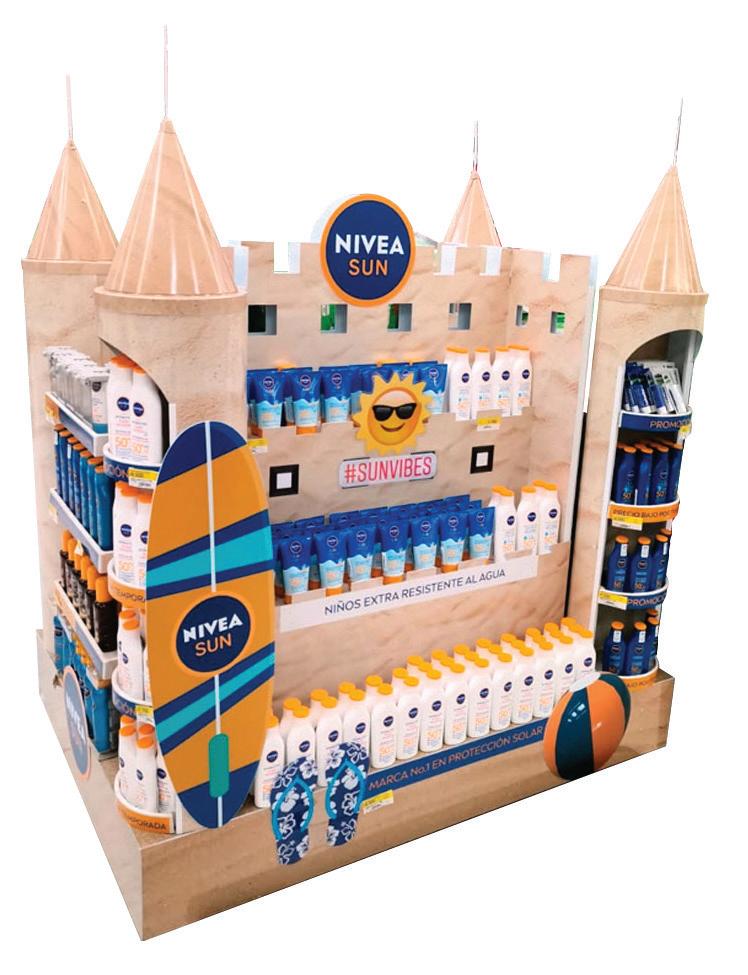
Brand: PopSockets
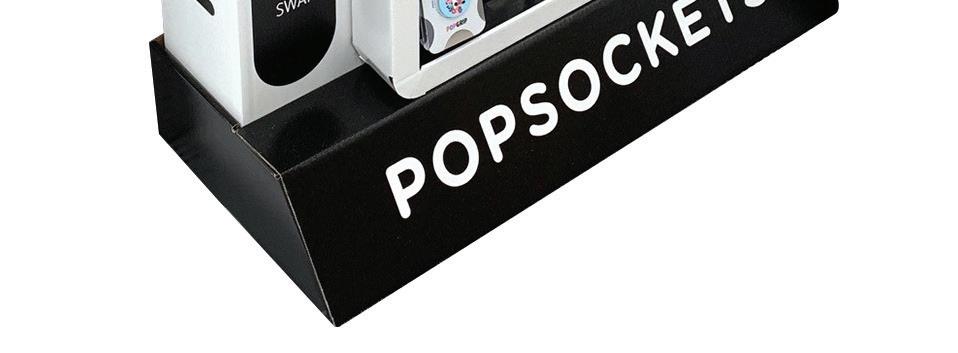
Display manufacturer: Vanguard Companies

Vanguard Companies and PopSockets created this fourway fi xture for Walmart stores. The main objective of the program was focused on a customized phone grip display that would hold a variety of product choices and fit on a Walmart four-way fi xture. To drive awareness and ROI, the display had to leverage key brand attributes, appeal to shoppers and maximize in-store effectiveness. The brand wanted simplicity to attract, engage and convert shoppers. Through customer collaboration, leveraging insights and strong design activation, the display maximized ROI and increased product sell-through.
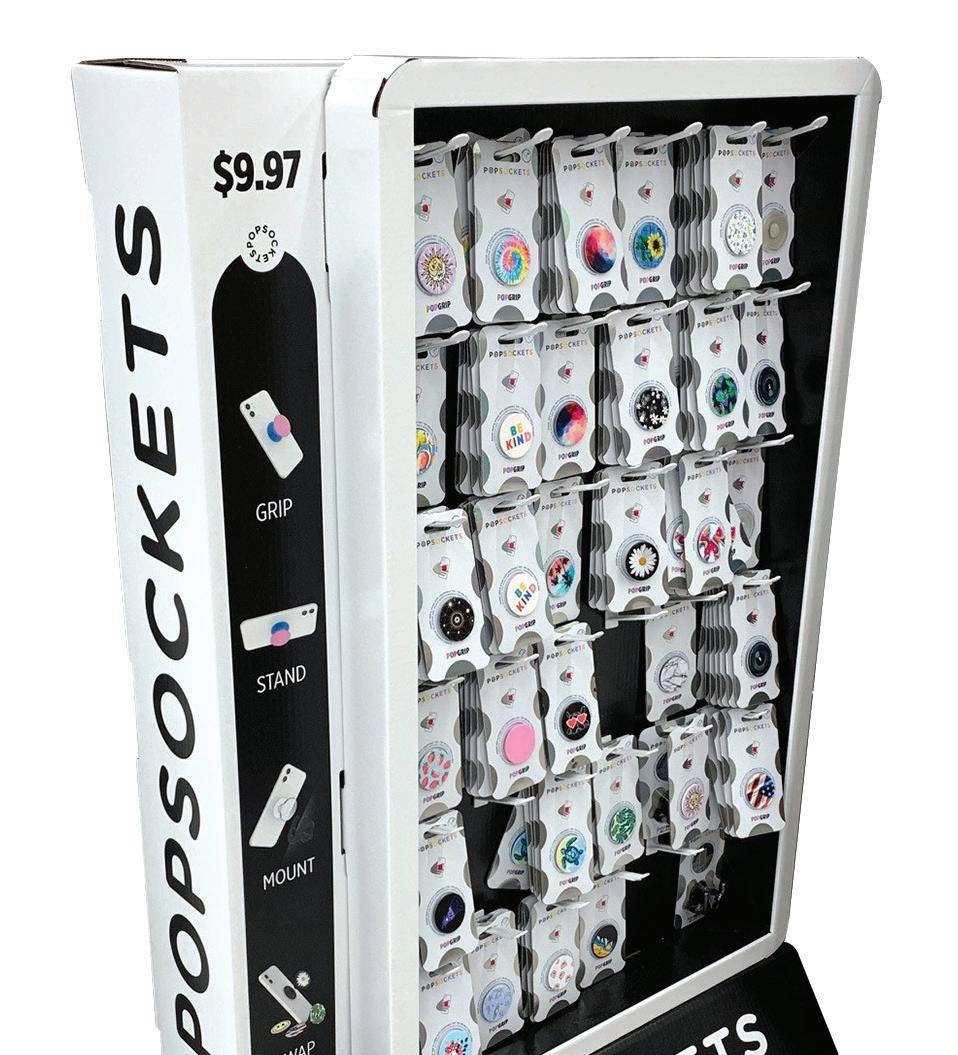
Brand: Pringles
Display manufacturer: Visual Branding
Visual Branding crafted an innovative endcap display unit for the Pringles snack brand, aimed at driving sales in both Guatemala and the Dominican Republic. Given Pringles’ premium positioning compared to other snacks, the focus lay in presenting the product dynamically and distinctively while accentuating its exclusive and well-positioned packaging. The display successfully achieved its goals of brand positioning and promotion, effectively endorsing the product with an emphasis on its distinctive packaging.
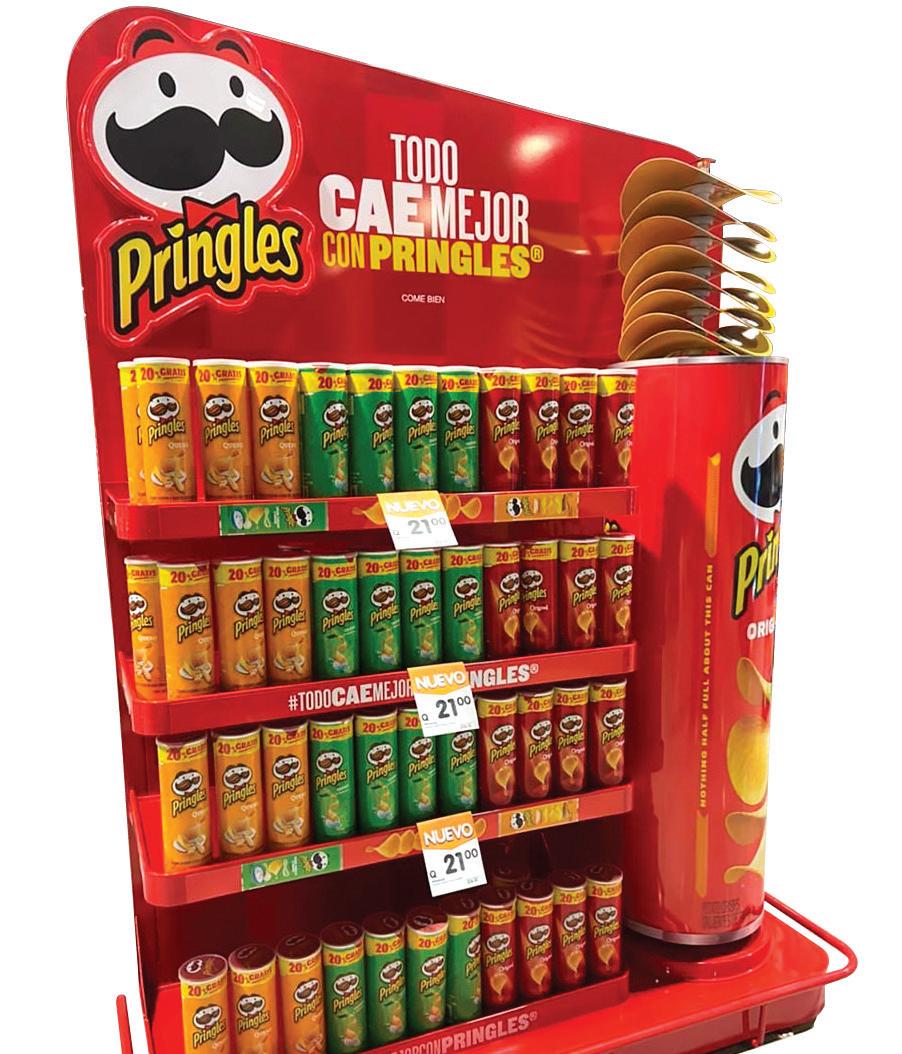
Brand: Bubly
Display manufacturer: Innomark
Bubly wanted to drive awareness and sales for Bellini Bliss, a new flavor with notes of peach, pineapple and mango. The brand needed a unique display to support the launch and break through the clutter. Bubly and Innomark worked together to elevate the traditional case stacker with a tropical theme, multidimensional design and a unique way of merchandising product. The result, which was well-received by retailers, showed that innovation and engineering can transform a basic display into a fun and memorable shopping experience.

Brand: Blue Buffalo
Display manufacturer: In-Store Experience
In-Store Experience created a shelving display system to showcase Blue Buffalo pet products in vet clinics. The 2-foot-wide display can be set up by itself or can be joined with others to create a full Blue Buffalo experience. Interchangeable headers and graphics allow customized messaging as needed for special clinic partners, as well as seasonal changes to support new product launches. The heavy-duty units hold a massive amount of weight yet feature rollers to allow them to be easily moved.

Brand: PC Richard
Display manufacturer: In-Store Experience
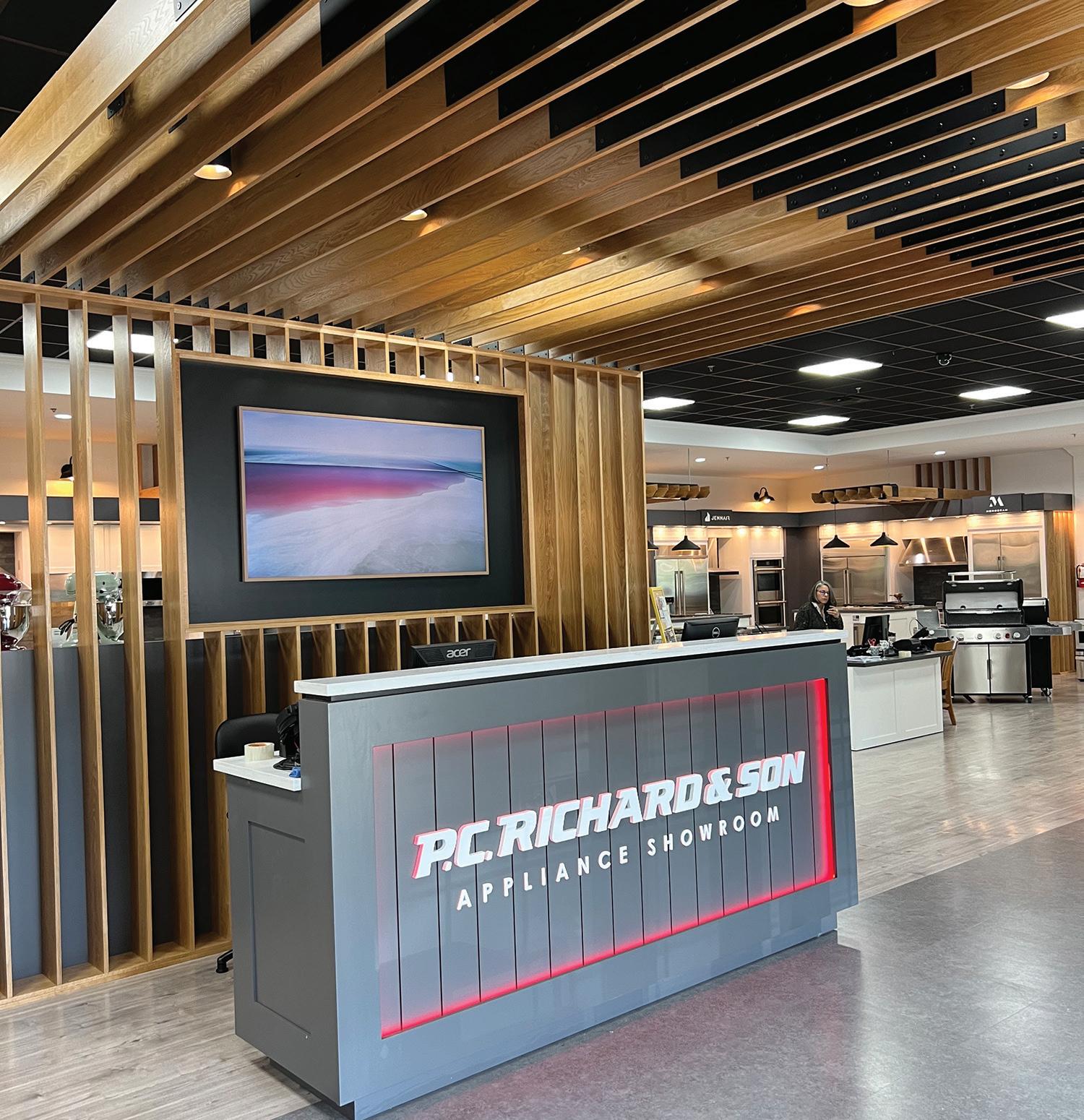
PC Richard tapped In-Store Experience to create a Signature Kitchen Showroom that showcased all of the top brands the store carries — in a way that appealed to the refi ned taste of their prestigious customers. Beyond a welcome desk, the product categories were reorganized so that they are easier to navigate, and contextual elements were added to enhance the storytelling and inspire shoppers as they view the products. PC Richard has reported a dramatic increase in foot traffic as well as longer and more profitable sessions with their customers.

Brand: Springs Window Fashions

Display manufacturer: Frank Mayer
Going through a brand refresh, Springs Window Fashions looked to Frank Mayer to design updated retail display fixtures for independent flooring stores nationwide. Modularity was key for these displays. The company needed both floor and wall fixtures, each with three modules that could hold product in different ways. There is a swing arm module option that displays swatches or a light box to demonstrate the opacity of the window covering in front of it.
Brand: Marchon Eyewear
Display manufacturer: Trans World Marketing
Marchon Eyewear needed a display that would feature its highly durable Flexon frames in numerous optometrist offices. A slim, metal and acrylic cylindrical structure was created with a custom aluminum rod to hold product. Atop the metal structure was a clear tube that housed a pair of Flexon frames with a large circular plate that appeared to be compressing the frames — like a vice —clearly demonstrating the strength and flexibility of the frames. The entire display had a compact footprint that held 24 SKUs and fully rotated for ease of shopping.


Brand: Marchon Eyewear
Display manufacturer: Trans World Marketing
This display embodies the high-quality craftsmanship and lightweight look of the Pure frames. Water-clear, injection-molded frame holders and zero-visible fasteners ensure the Pure frames were the focus of the display. A clear acrylic top section was printed using translucent inks in an ombre fashion, giving the display a fresh, lightweight appearance. The main body was a bright white, causing both the translucent top and the product to stand out. All elements came together to achieve a quality merchandiser that held 35 SKUs and spoke both to the brand and the lightweight frames.


You cannot overstate the impact and reach that the July 21 theatrical release of Warner Bros.’ “Barbie” had this year. It resulted in one of the largest cultural marketing moments ever. During the promotional period, seemingly everyone was talking about the movie, and every brand, retailer, restaurant and business found a way to partake in and capitalize on it — especially Warner Bros. and toy maker Mattel. While not every movie release or licensed product can or will measure up to the impact “Barbie” had on marketing in 2023, entertainment tie-ins and licensing agreements are not a new concept to brand marketers. But the way they leverage the occasions has evolved, perhaps with a widened view of what is possible. Here’s a sampling of some tie-ins the Path to Purchase Institute spotted this year.
BY JACQUELINE BARBA1
2



Ulta Beauty tied in to the “Barbie” movie with a sweepstakes, popup events and multiple licensed exclusives, including a weeklong launch window for a limited-edition Barbie The Movie collection from



L’Oreal’s NYX Professional Makeup. In stores, bright pink floorstands promoted the film’s release and promised that the collection offers “dream artistry for every Barbie and Ken.” Racks positioned alongside the NYX floorstands stocked additional Barbie products from brands, including Farouk Systems International’s CHI, Truly Beauty and Hally. Window posters also spotlighted the movie tie-ins. 3 Target leveraged the “Barbie” movie via an interactive online brand shop. The retailer launched a dedicated character shop that spotlighted Barbie-inspired products (some exclusive) — including those from Wella’s OPI, Unilever’s Suave and
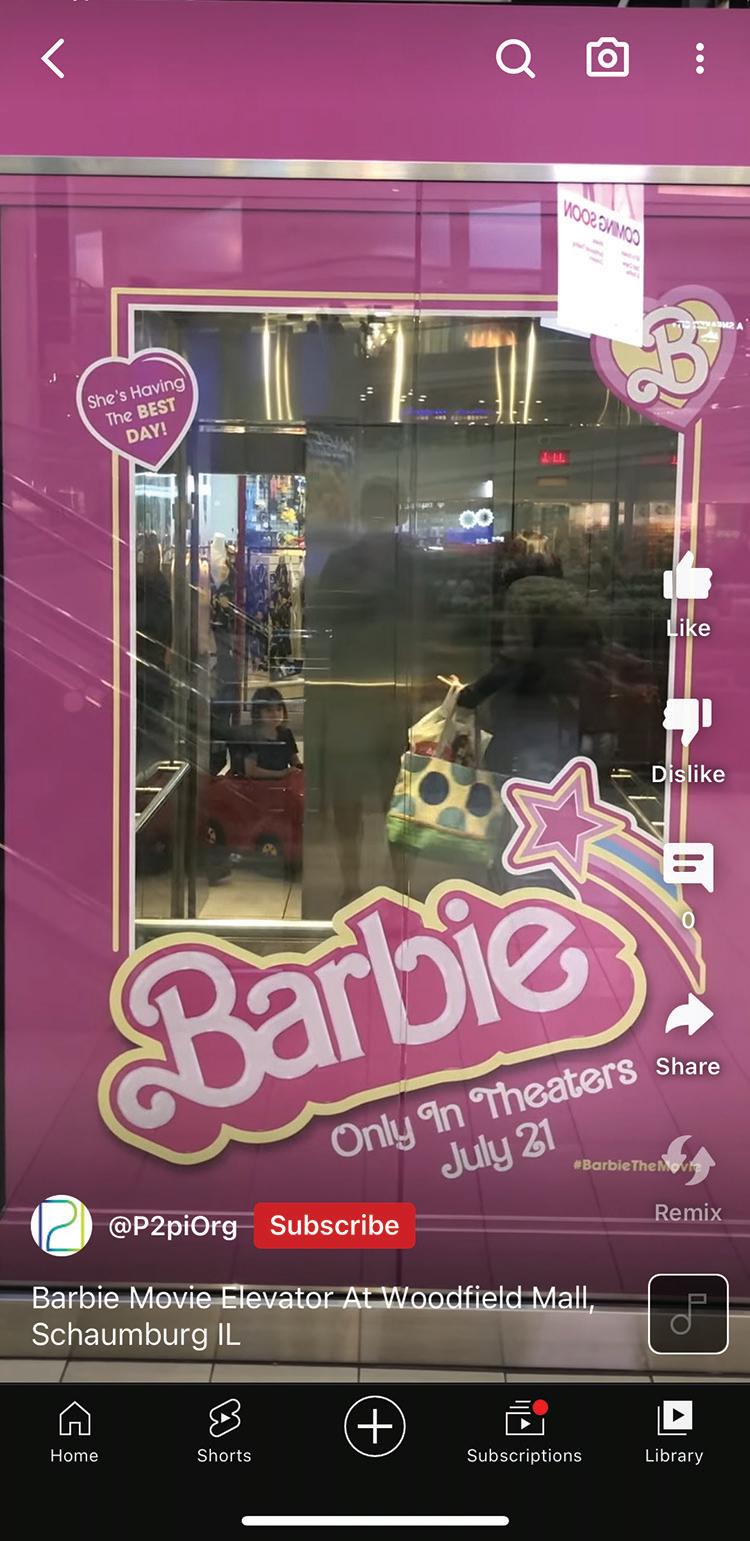
4 5













































































































Mattel — across categories in a virtual Barbie dreamhouse. Users could click on different product categories in the house to browse related SKUs. The page also offered other activities, including a link to a Barbie selfie generator. Target also launched a dedicated Trends shop spotlighting Barbiecore fashion. 4
7-Eleven tapped into nostalgia by partnering with Bandai Namco’s “Pac-Man” video game franchise on a sweepstakes that ran from Feb. 22 through May 23 and awarded a slew of prizes, including a custom retailer-branded Pac-Man arcade machine. Loyalty members could enter by purchasing a qualifying product from select brands (e.g., Hershey Co.’s Reese’s or 7-Select). The sweepstakes was heavily promoted in stores. 7-Eleven also temporarily renamed some of its proprietary drinks for PacMan’s ghost antagonists. 5

Cosmetics brand ColourPop brought a line of licensed Naruto (a Japanese manga series) products exclusively to Ulta Beauty in July as part of an ongoing partnership with the retailer. Some SKUs even sold out through both Ulta and ColourPop. In stores, the line was stocked on a table display, while a home page banner ad on ColourPop.com and posts across the brand’s social media accounts supported the launch.















































6
8
9


The Walt Disney Co. launched an exclusive Disney100 collection at PetSmart stores and on the retailer’s website in May as part of its 100th anniversary with retail collaborations. The line featured 26 toys for cats and dogs, which were merchandised in stores on endcaps encouraging shoppers to “share Disney fun with your dog” or offering “Disney favorites for your cat.”
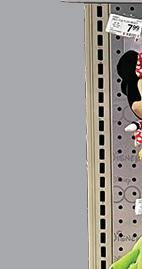

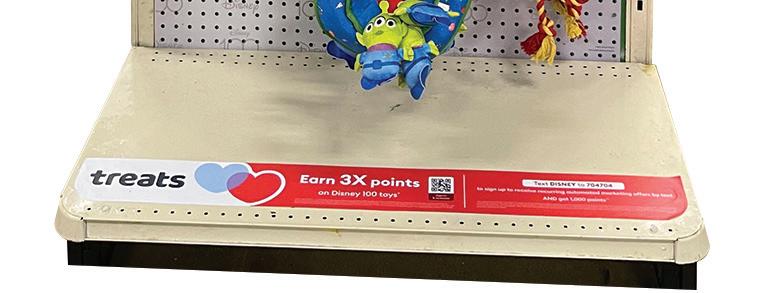

6
the first grocer to offer the cartons, which comprised six special cartons depicting “fan-favorite” dinosaurs from the Universal Pictures and Amblin Entertainment blockbuster franchise, including T. rex, Stegosaurus and Blue (the famous Velociraptor).



7
Popular video game Angry Birds debuted its first themed retail cafe in New York, in the Flushing neighborhood of Queens, in July. The 3,300-square-foot store concept, iSwii by Angry Birds Retail Cafe, is located in the food court area within the Tangram retail center. The place offers playful desserts, bubble teas, gaming stations, a retail section and interactive activities geared toward kids and families.

8
Boxed Water is Better rolled out “Jurassic World”-inspired cartons of its sustainably packaged water to grocery retailers across the U.S. and its brand website. In April, Meijer became

9Walmart supported the rollout of Mondelez International’s limitededition product collaboration with Nintendo’s “Super Mario” game franchise and Oreo. Walmart promoted the “Oreo x Super Mario” cookie packages, which feature characters from the game, within Walmart.com using a banner ad inviting shoppers to “Find All 16 Super Mario Designs” and linking to the product details page.

Samsung recently rebranded its Whisk app (acquired in 2019) as “Samsung Food,” an AI-powered, personalized food and recipe service. The app is now accessible in eight languages in 104 countries. It offers 160,000 recipes plus meal plans, nutritional information, automated shopping lists, ingredient searches and food reviews. It integrates with Samsung appliances through its SmartThings home controls system. Samsung plans to add Samsung Health integration and, in 2024, will implement “Vision AI” technology that recognizes food items and meals and saves ingredients to shopping lists.


Surveys suggest that 50% of adults collectively possess unused gift cards, vouchers or store credits worth $23 billion. In August, Yahoo beta-tested an AI tool called “Shopping Saver” that can search through a user’s Yahoo email for forgotten cards, discount codes and credits. It also has a writing assistant that can draft suggested messages to vendors to recover the savings. Yahoo Mail is currently accepting sign-ups to join the beta.


More than two-thirds of J.Crew’s online store traffic comes via smartphone, so it recently modified its Passport loyalty program to give app users an exclusive 48-hour shopping head-start on new product launches. The company also opened an immersive virtual store created by Obsess, a New York-based experiential e-commerce platform. This 3-D, shoppable experience is a beach house with themed rooms that explain the materials and design history of various products, which the company calls “interactive, contextual merchandising.”
Quotient has announced that users of its “Shopmium” app can connect Venmo accounts to receive cash-back deposits from redeemed offers. Since the cashback app’s U.S. launch in fall 2022, shoppers could only use PayPal accounts, but research indicates that up to a third of consumers use Venmo, and it is now preferred by both Millennials and Gen Z. Offers change weekly from more than 500 product manufacturers, including Nestle, SC Johnson and PepsiCo.
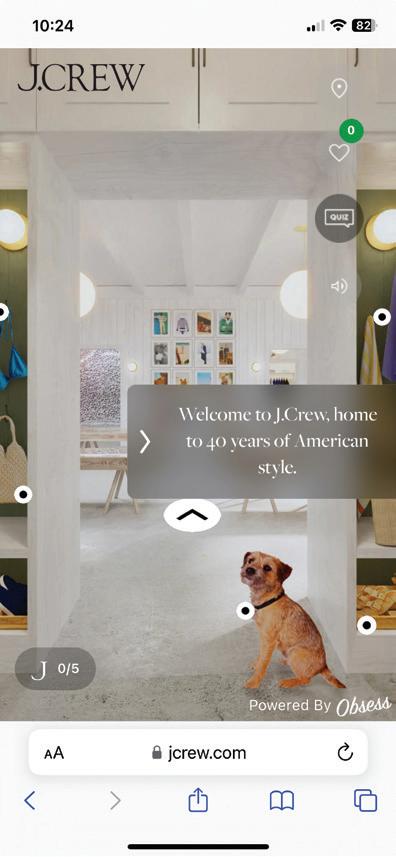
In August, Bloomreach introduced a conversationalshopping product for e-commerce using generative AI and large language models (LLMs). Called “Bloomreach Clarity,” the system is said to be able to deliver personalized, human-like product expertise about a shopper’s favorite brands. It is built upon a real-time customer data engine that, along with real-time targeting, enables Clarity to prompt conversations on websites, chat and SMS based on a customer’s current journey while refining the chat using a brand’s guidelines over tone of voice.
Roku and Instacart recently announced an advertising partnership that pairs TV streaming with online grocery delivery. The partnership merges first-party viewership data from Roku’s streaming platform with e-commerce insights collected by Instacart, enabling CPG marketers to measure how ads affect purchasing by streamers. In a pilot with a personal care brand, 60% of those who purchased the brand after seeing its campaign on Roku were new to the brand. Advertisers can access consumer insights drawn from 1,100 retail banners and 80,000 stores.

While just “retail-adjacent” at the moment, here’s an AI function heading to stores eventually: DoorDash announced “agentpowered” voice-ordering. According to its surveys, up to 50% of customer calls are left unanswered, so during peak times, this AI capability can take over and offer a personalized voice-ordering experience in multiple languages. Returning customers can quickly reorder favorite meals, and a live agent hovers to take over calls at any time.


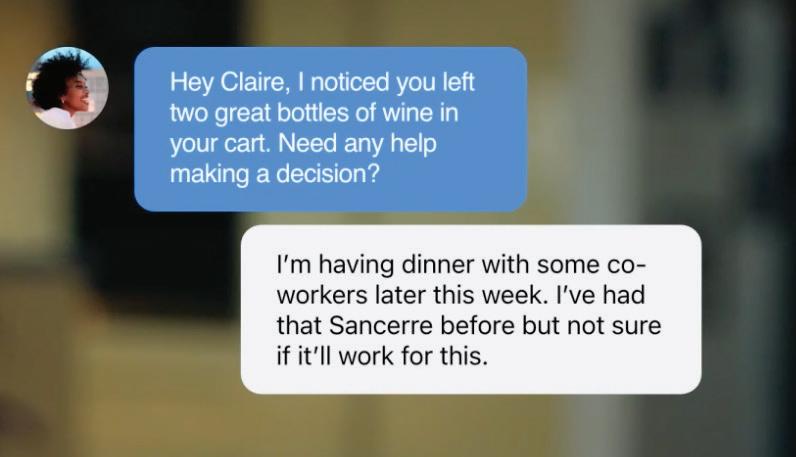
In May, Cadent , a platform for advanced TV advertising, signed a multi-year agreement establishing it as Catalina’s preferred platform for linear, addressable and connected TV ad campaigns for CPG. The companies offer brand marketers an ability to re-engage shoppers who’ve seen a TV ad with an in-store or digital coupon to incentivize purchase during a campaign window.
In June, Fractal launched Flyfish, a generative-AI sales platform that helps brands build “AI sales advisors” that can engage in one-on-one shopping experiences with consumers. Fractal’s platform can analyze a shopper’s buying patterns and history to create a personalized experience that mimics human interaction. Brands sync their catalogs and marketing collateral by connecting Flyfish to their CRM; the platform is said to be able to configure an AI sales advisor within minutes.

Looking for an alternative to AI/ChatGPT-only customer assistance systems? Meet Feel , which lets online shoppers talk to live, work-from-home sales associates who use AI to make recommendations. Feel places a button/widget on retail websites that, when clicked by a shopper, connects them via video chat to the associate. The platform connects through platforms such as Shopify, Magento, Commercetools, SalesForce and Woo Commerce.

In late August, Darko unveiled “ShopperAccess,” a cloudbased mobile technology that lets retailers showcase valuable merchandise securely in-store while also delivering usage analytics. The system uses dynamic QR codes that allow shoppers to control their access to merchandise via their mobile phones, replacing reliance on manual keys or aisle-call buttons. Darko collaborated with Philips Personal Health consumer products on the technology, which is currently being tested at chains throughout the U.S.
In mid-August, the Consumer Healthcare Products Association (CHPA) and Family Dollar launched “Health In Hand” to help shoppers choose and use OTC products and dietary supplements. The program is placing QR codes on in-store wayfinding strips in 8,000 Family Dollar stores to direct shoppers to custom landing pages on HealthInHand.org. The goal is to advance self-care literacy among vulnerable communities. The first two Family Dollar categories featured are digestive health and pain management; soon other categories will be added including cough/cold/flu and allergy.
In July, Shipt teamed up with online gaming developer Voldex for a back-to-school shopping immersion within “Driving Empire,” Voldex’s racing game on the global Roblox platform. Users take on the role of a shopper with Shipt to deliver popular items on customers’ back-to-school lists, battling against scheduled delivery times to earn in-experience currency. This gamification exercise is basically an awareness campaign for Shipt, as the game boasts more than 1 million daily visits.

GivBux recently launched the “GivBux Super App,” which has the support of both local retailers and national chains such as Amazon, Old Navy, Petco, CVS, Home Depot, Lowe’s, Sephora and Staples. Purchases made using the app rewards the user with cash back, a part of which (from 1% to 100%) can be directed to a charity. GivBux manages the collection and distribution. The app’s platform also offers social networking, banking, messaging, food delivery and transportation.
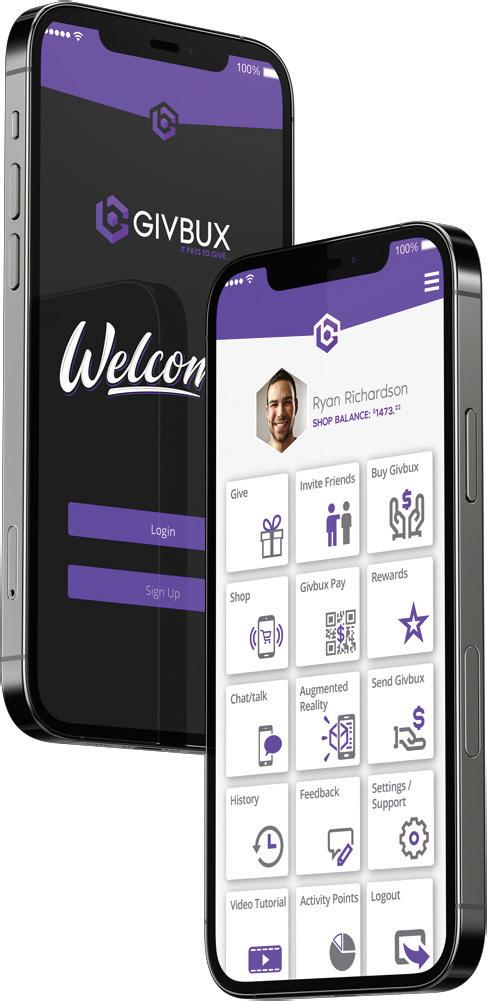



YouTube star Emma Chamberlain launched a ready-to-drink (RTD) line of her DTC coffee brand exclusively at Walmart in April.
“We worked closely with Walmart from the beginning, even before we had developed a product,” says Elizabeth Ahern, chief marketing officer of Chamberlain Coffee. “Based on insights from our consumers, we knew that there was a large demand for cold coffee, especially in a ready-to-drink format. Walmart was an ideal partner because of their national presence and reach among the Gen Z shopper. Because of the convenience of this product, we wanted to be as close to our consumers as possible.”
Stocked at Walmart stores in the aisle with other RTD coffee, the line spans four latte flavors made with almond milk and coconut cream: cold brew, mocha, cinnamon bun and vanilla. The 12-ounce cans cost $2.98 and remained a Walmart exclusive through September. Walmart will also

begin stocking the brand’s Early Bird, Social Dog and Fluff y Lamb ground coffee blends soon.
“We’re looking to continue to expand our brand’s presence in retail locations,” Ahern says. “We want to be a part of our consumers’ daily lives, and ensuring we’re available when and where they shop is a part of delivering on this. Our own website will continue to be a platform for discovery of exciting new products and fun collaborations.”
Chamberlain partnered with Quan Media Group to promote the launch with the brand’s fi rst out-of-home campaign. Running for four weeks in May, the effort included placement in Walmart parking lots, digital kiosks near the University of Houston and Arizona State University, and ads in Dallas’ American Airlines Center sports and entertainment arena.
“We identified markets with a high concentration of Walmart stores and then overlaid our knowledge of the Gen Z population in those markets,” Ahern says. “We brought this list then to Quan Media Group, and they were super helpful partners in helping us home in on the right neighborhoods based on these goals and the right premium inventory. They helped us identify trade-offs with different placements and negotiated on our behalf so we could meet our budget goals.”
The campaign incorporated a mix of static and digital ads with simple messaging designed to drive awareness of the product and inform consumers where they could buy it. Chamberlain supported the effort across its social channels, most notably with a YouTube video where the brand founder dressed up as a can of coffee to ask Walmart shoppers trivia questions.
ON-DEMAND The Home Improvement Sector
ON-DEMAND Experiential Retailing
ON-DEMAND Grocery Trends & Tactics
ON-DEMAND Inside Beauty Retail
ON-DEMAND The Well-being Movement DECEMBER 12
Featuring special retailer guests in each episode, join us for a dialogue about current trends and strategies that are driving innovation for the next era of retail.
In partnership with Great Northern Instore, the Path to Purchase Institute invites you to listen in to a discussion with executives from today’s leading retail chains, emerging brands and parallel industries as we dive into the issues impacting the evolution of retail.
Attendees will:
• Hear firsthand retailer insights and experiences navigating successes and challenges in the market
• Discover how changing shopper behavior is reinventing retail across various segments
• Explore the shifting dynamics that will impact commerce marketing across all channels of the retail arena
Sign up now to gain insights, get inspired and go enact change at your own organization with the learnings from Retail Intel 2023.
PLEASE VISIT






Retail media’s influence and power in the commerce marketing world is undeniable. U.S. retail digital ad spending will grow by 12.2% this year to reach $73.55 billion and account for 27.9% of all digital ad spending, according to Insider Intelligence The market research company estimates retail digital ad spend will jump to $84 billion in 2024 and $92.23 billion in 2025 — and that’s just in the U.S. IAB Europe forecasts that online retail media ad spend will exceed traditional linear TV ad spend by 2026 to reach 25 billion euros (stateside, retail media is closing in on traditional TV, too).
“Advertising is changing the world, and retail media is changing advertising,” said Cara Pratt, senior vice president, Kroger Precision Marketing, at the Path to Purchase Institute’s Retail Media Summit (RMS) in June. “People outside of our industry are wondering: Is this just the next shiny object? Is this the Beanie Babies of media — the fanny packs of advertising? Listen, retail media is here to stay. We are on a course to change advertising forever.”
When Pratt delivered these opening remarks in Chicago this summer, there was a definite excitement (and a collective understanding) in the room. We all knew retail media wasn’t a fad. And I was personally filled with an immense sense of pride that the key retail media stakeholders — from brands to retailers to solution providers — spearheading and changing advertising forever were all in one room, brought together by the Path to Purchase Institute. My amazing coworkers stood up a sold-out, industry-leading event for the second year in a row (catch up on RMS in the next few pages). I’d be remiss if I didn’t share a bit about how we got here.
P2PI launched 30 years ago to serve the needs of brand manufacturers, retailers, agencies and solution providers.
A lot has happened in the past 30 years — a lot has happened in the past five years — but since our launch, what’s differentiated us from other publications and organizations is we listen vehemently. We interact with our community members constantly, listening to their concerns and challenges, and looking for places where we can fill a learning gap. That said, there was no way we could ignore the rise of retail media and the challenge our community faced understanding how to best navigate and activate in this space. So we leaned in early and hard, creating not only a first-of-its-kind event devoted to retail media, but:
• A Retail Media Awards program (see images of the winners on pages 3-4 of this guide);
• A column devoted to the subject, “Focus: Retail Media,” that I lead, as well as numerous, daily articles from our superstar digital editor, Jacqueline Barba;
• The Retail Media Unplugged video series, in partnership with Criteo, featuring executives from retail media networks (for sound bites, see pages 20-21);
• Multiple proprietary research reports on the subject (browse findings from one report on pages 15-16);
• A retail media image vault (for a sampling of images, see pages 11-14);
• Engaging industry partners with common interests, such as the Interactive Advertising Bureau tackling measurement standardization;
• A share group, the Retail Media Guild, devoted to the subject; and
• So much more.

And there’s more to come. From AI’s role in retail media and commerce marketing to new retail media partners and solutions, I’m excited for what the new year will bring and I encourage you to bookmark P2PI.com and to engage and connect with us in person at one of our live events. As our Editorial Director Jessie Dowd loves to say, we’re the OG (original gangster) of retail media, and we’ll continue to be the go-to resource for the industry in this space.
Cyndi Loza Managing Editor, Member Content
We interact with our community members constantly, listening to their concerns and challenges, and looking for places where we can fill a learning gap.
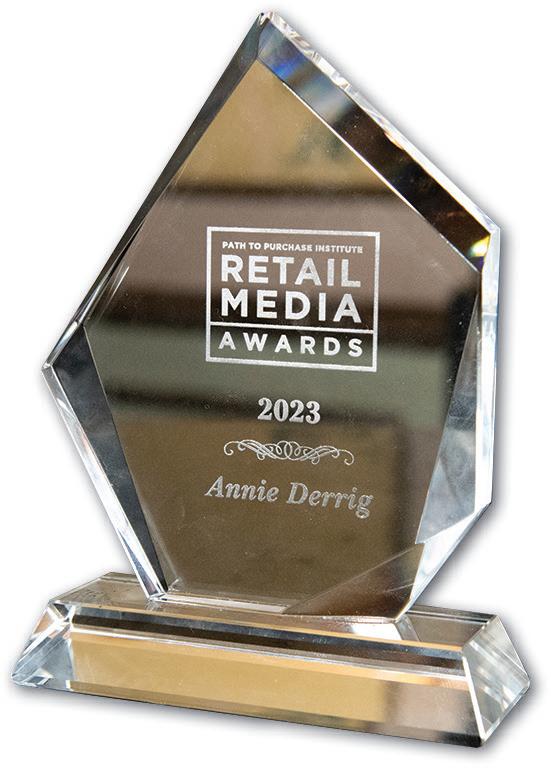

From insightful sessions to the Retail Media Awards ceremony, P2PI’s sold-out Retail Media Summit brought together brands, agencies, retailers and technology solution providers in Chicago to discuss the challenges and opportunities available in this rapidly evolving space.








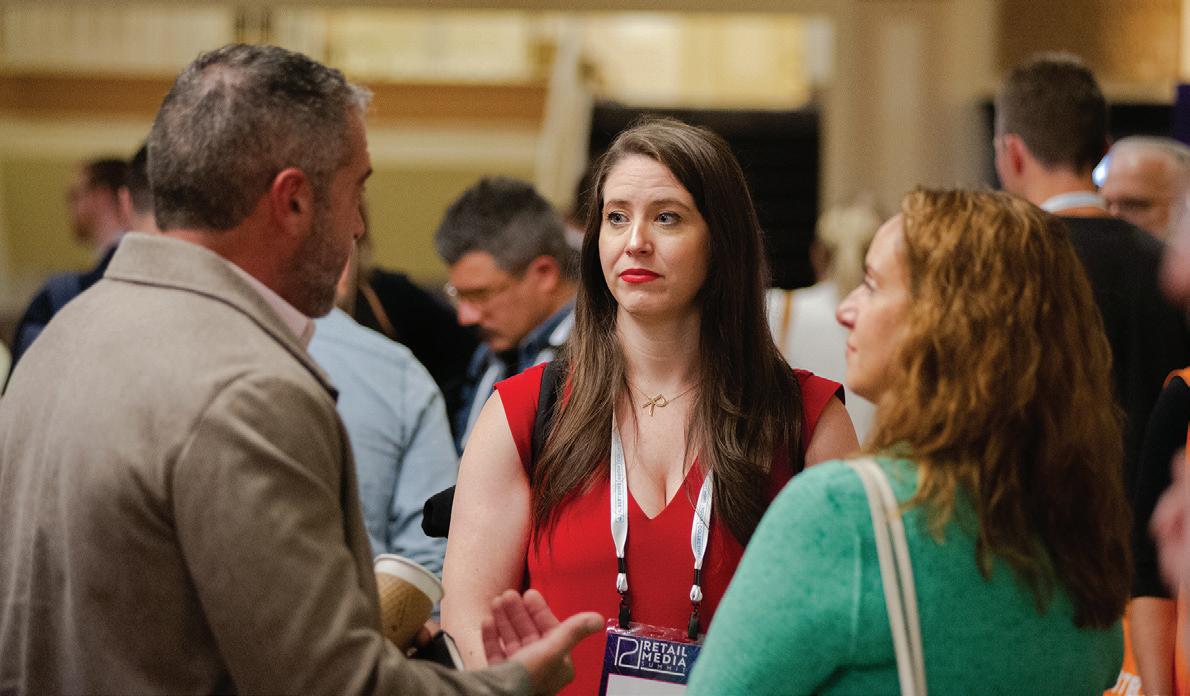
During her June 28 keynote address that opened the Retail Media Summit, Andrea Leigh set out to show how retail media is a complicated space but can yield incredible advantages in terms of brand exposure and share.

The founder & CEO of Allume Group, which bills itself as an e-commerce knowledge network, presented four dynamics or trends that exist currently with regard to retail media, and then walked attendees through her company’s M.E.D.I.A. framework for retail media success.
“We’re gonna talk about how to win,” Leigh said to the audience at the Path to Purchase Institute’s event in Chicago. “[And] we have a video framework that we’ve built that we provide to a lot of advertisers to teach them about how to work with retail media.”
“I like to call this a regional media push and pull,” Leigh said. “You have the push side, which is the retailers pushing regional media onto the advertiser. … In a lot of cases, it’s part of the joint business plan between the supplier and the retailer. … But at the same time, we have a pull coming from the manufacturers. They’re asking for better targeting capabilities.”
She continued: “The retailers need to listen to the advertisers. … And then the advertisers need to be really persistent in asking for what they need.”
“I don’t know about a lot of you and your interactions with applications that sit on top of generative AI brains, but I’m pretty much exclusively using ChatGPT instead of Google now because it’s so much easier to get the answers that you need to get product recommendations,” Leigh said. “This won’t be tomorrow. It’s not like retailers are going to adopt this type of technology until we can monetize it. But I do think it underscores the importance of thinking more broadly about retail media, because we’ve been very, very focused on keywords. And generative AI is not keywordbased. It’s really good at taking unstructured data and structuring it in a way that can be meaningful.”
Leigh showed a chart comparing the monthly in-store audience reach of major retailers compared to the digital reach, and the in-store reach was significantly higher for many of them.
“You can see why they need to do this, right?” she said about adding retail media inside stores. “It’s the only way to ensure that all of the traffic can be monetized.”
She offered Instacart’s Carrot Tags (electronic shelf tags) and Caper Cart (an AI-powered smart cart) as examples.
“There’s been a really good push over the last couple of years for data clouds,” Leigh said. “This is where advertisers and retailers can kind of tentatively share data with one another and kind of eagerly combine it so that we can understand a little bit more about our shoppers, and we can develop new targeting capabilities. … This is a muscle that organizations have to build — and they don’t all have it.”
Leigh then took attendees through Allume Group’s M.E.D.I.A. (an acronym for the strategies below) framework for advertising success, part of the company’s advertising strategy course:
Maximize readiness. “Maximize readiness is really about not wasting your advertising dollars as an advertiser,” Leigh said.
Establish goals. “One of the biggest questions that I get from brand manufacturers is, what should my budget be? How much should I spend on retail media? How much should I spend on Amazon versus Walmart versus Target and all these media platforms? So, we always ask, what are you trying to accomplish?” Leigh said.
Design strategy. “This is really about meeting the shopper where they’re at and what we like to call: the layering techniques,” Leigh said.
Incorporate tools. “Incorporate tools speaks to budget resourcing and tactics,” she said. “This is more like picking an agency who’s going to help us execute this.”
Analyze and optimize. This is about “how challenging it is to measure things in retail media, and compare apples to apples across the different platforms. And this is where you really have to go back to what your goals are.”
Is retail media disrupting the foundation of the buyersupplier relationship? Upending the trade relationship dynamic?
During his June 29 keynote address at the Retail Media Summit, Colin Lewis said it is, and he set out to show how both brands and retailers can navigate their way into a different world that will benefit both parties, rather than continue the often-adversarial nature of buyer-supplier relationships.

At the Path to Purchase Institute’s event in Chicago, Lewis of RetailMedia.works compared the adversarial relationship to that of boxers Muhammad Ali and Sonny Liston in the 1960s, showing a famous photograph of Ali (representing retailers) standing over Liston (representing suppliers) after a knockdown during their title match.
With regard to retail media and the retailer-supplier relationship, the elephants in the room are trade funds and real data. “The game of elephant in the room can’t continue,” Lewis said. He then compared retail media to a platypus. “What the hell is it?” he asked.
Lewis also made a case for creativity: “We should inject creativity into everything we do.”
He said there’s a “problem with teams,” identifying marketing’s “Fab Four” — brand marketing, trade marketing, shopper marketing and retail media — and offering these realities:
• “Trade, shopper, retail media and brand marketing work with different objectives, different KPIs, different datasets and are segregated as a result.”
• “All of those teams have different asks of the brand. They don’t understand what others have asked. They don’t even understand how things fit together.”
• While trade marketing is “a B2B (business-to-business) game” and about consideration, brand marketing is about B2C (business-to-consumer) and awareness, and shopper marketing is about B2C and conversion. Retail media, meanwhile, is about B2B and B2C as well as consideration.
Another way of saying the same things, according to Lewis: People who buy things for a living and people who sell things for a living have very different skills. So, what’s a marketer to do?
• “Responsibility for generating brand demand is no longer solely the domain of the supplier brand team; it has become a shared responsibility between the brand and the retailer.”
• “Thinking of those budgets in silos is not optimal to drive the best results. Instead of negotiating individual budgets, look at the total spend across all budgets to drive sales for a retailer.”
• “Expand the remit from selling advertising to being the purveyor of creative ideas that provide solutions to business problems.”
Lewis says the new game is total collaboration to unlock value:
Stop the silos: Get them all in the room.
Align incentives and budget: Come together and drive collaboration.
Brands: Hold retailers to account but align your teams.
Retailers: Think like a media business and solve joint problems.
Both brands and retailers: Get creative.
In conclusion, Lewis said the challenge is to form new models of governance:
• How do you really break down silos?
• How can you shift budget across teams?
• How do you figure out budget allocation?
• What is the decision-making process ?
• What is the right cadence of being connected?
• How do you figure out governance?

Speakers: Austin Leonard, Head of Sales, Sam’s Club Member Access Platform (MAP); and Lindsay Letterle, Director of Sales – Sam’s Club, The Clorox Co.
Clorox wanted to reach all Sam’s Club members during the retailer’s 40th anniversary and spotlight brands such as Kingsford. The brand manufacturer partnered with the retailer media network Sam’s Club Member Access Platform (MAP) on live events and digital activations throughout the grilling season. From April 19 through June 11, a total of 145 festival events were held, along with 83 pop-up events at Sam’s Club parking lots. The average number of event attendees was 485, with food and interactive games on site.
Speakers: Kristen DiCorleto, Head of Marketing, CVS Media Exchange; and Cyndi Loza, Managing Editor, Member Content, P2PI
The Path to Purchase Institute, together with CVS Media Exchange, surveyed nearly 90 agency professionals to find out what they — and their clients — think when it comes to retail media. The survey was conducted March 7-April 5. To qualify, participants must have indicated leading or working in a role that includes engaging with clients on retail media.
Participant profile:
• Nearly a third of respondents were managers, 34% were senior management and nearly a quarter were directors.
• All said their client focus was CPG with about a third also noting retail, and nearly a quarter saying they had direct-to-consumer clients as well. Among the results:
• Nearly four out of five agency professionals said their CPG clients have increased investments in retail media over the past year.
• CPG clients are allocating about a third of their budgets to retail media today, and agencies expect they will increase that allocation to half within the next year.
• The most important capabilities for a retail media product to offer CPG clients, according to survey takers, are transparency in how campaign performance is measured, access to first-party data and real-time campaign optimizations.
Agencies see an array of burgeoning areas in retail media, most notably:
• Shoppable video content,
• Increased personalization,
• Omnichannel audience tracking, and
• In-store digitalization.
Branding was present throughout the events, such as on a counter sign that detailed how to get olive oil stains out of clothes using Clorox products. At the bottom of the sign was a QR code urging readers to “Buy now at Sam’s Club.” The events resulted in 45,600 giveaways and product samples. The in-club events, including those with Kingsford grilling elements, exceeded brand expectations. Live broadcasts from local radio stations helped drive traffic to the events. Clorox also reached members through in-club digital screens, gas station screens, social media, the Sam’s Club landing page and on-site display.
Speakers: Peter V.S. Bond, Co-Founder & CoHost, The CPG Guys Podcast; and Matt O’Grady, President of the Americas, dunnhumby
The COVID-19 pandemic accelerated the entire retail media opportunity. Retail media is going to be bigger than linear TV, but it’s important that it doesn’t suffer the same mistakes seen in social media and search.
The most successful retail media networks are incentivized to sell media and are openly collaborative.
Collaboration at all levels has to be stellar to ensure success. Networks are advised to share the data with brand partners, be transparent about it and agree on standards. The entire industry
would be better if stakeholders could agree on standards and transparency in retail media. Lack of trust is holding retail media back from becoming a well-oiled machine.
Brands should not be solely focused on return on ad spend (ROAS) to measure retail media success. Unless it’s a big national campaign with a retailer such as Walmart, positive ROAS can be elusive. And even if metrics such as cost per click don’t work as well at times in retail media, the foundational aspects like reach or duplication are not going away.
Traditional on-site retail media tends to be focused on the lower funnel, but it needs to go to the upper funnel.
Support the image of your brand in advertising. When it’s not supported, sales fall off.
Personalization can be possible for in-store retail media, but it must not invade privacy. It’s important for brands to continue a dialogue with shoppers. Not every person is going to be nimble enough to open an app for savings at the register. It boils down to basic customer acquisition and retention at the local level. Turn to retail buyers and ask, “What are they most responsive to?” Beyond a specific campaign, companies should assess how their overall brand or brands performed over a set period of time, such as the past year.
Speakers: Liane Gonzalez, Vice President, Client Development, Epsilon; and Dom Manna, Director of Ad Operations, UB Media
Partners since 2015, Ulta Beauty and Epsilon discussed the evolving retail media landscape and shared insights from their work together for UB Media as well as joint research, including:

• Brands and retailers said that inconsistent targeting is the top source of retail media inefficiency across channels and tactics.
• More than anything, brands want transparency on up-to-date campaign performance reports (75%).
• The top two most important metrics for brands for measuring retail media campaigns are total sales and return on ad spend.
• Transaction data at the retailer level is important.
• Having a first-party audience of active shoppers is crucial to have a successful RMN. Over 95% of all transactions are tied to a loyalty member at Ulta Beauty.
• Crafting audience segments around people (i.e., loyalty members) will be much more efficient than individual first-party cookies and device IDs that lack a rich profile.
• A strong first-party audience foundation helps provide accurate, deterministic closed-loop reporting within programmatic display and video ads.
• UB Media leverages its breadth of campaign performance to provide benchmarks at the category level for brand partners so they can gauge effectiveness.
• UB Media provides additional granularity on the mix of sales that were driven in-store compared to online.
• Soon UB Media will release a self-serve reporting solution that gives greater transparency and access for brand partners to monitor their campaigns.
Speakers: Art Sebastian, Retail Strategy Consultant, NexChapter
Sebastian discussed the power of omnichannel marketing and its potential to drive business growth and customer engagement during his session. Key takeaways and highlights include:

• Retail media spending will surpass $100 billion by 2027 (eMarketer).
• Macro trends the industry is currently seeing include the economy, labor, generative AI and competition.
• Current and forthcoming challenges
— including cookie deprecation, privacy
Speakers: Peter V.S. Bond, Co-Founder & Co-Host, and Bryan Gildenberg, Co-Host, The CPG Guys Podcast; and Andrea Leigh, Founder & CEO, Allume Group

The speakers covered a variety of topics as they relate to retail media. On the issue of supply chain, they said brands will waste a lot of money if they are not looking at advertising spend together with other factors such as commercial efforts. Being in-stock is crucial to making sure a brand’s retail media programs will be successful. Not all of the retail media networks are aware of inventory. In this scenario, there is no magic advertising strategy that will increase brand sales by a large number. Brands simply need to fulfill online orders. If they are diversified in their fulfillment strategy, they will have more in-stock opportunities.
The speakers also pondered what the future of in-store shopping will look like as retail media plays a bigger role. Although online pickup is serving a need for speed and convenience, many of those pickup shoppers are parking and going inside the store from which they ordered products. They might be pre-ordering the essentials, then going inside to browse and leisure shop for unique products. Brands should take advantage of any sampling opportunities available within store pickup orders. Or be part of suggested and recommended similar items shoppers might be served as they place their orders.
It’s important for brands to continue considering impulse purchases both in-store and online. If a shopper can be convinced to buy a larger pack size or in bulk online, then that addresses the profitability situation for baskets and basket size.
When the discussion shifted to organizational structure and process, the speakers said all aspects of communication are key. When bringing teams together, watch out for jargon issues and terms that can mean different things to different people, depending on their job function. More important than structure for organizations is having a good workflow and fearlessness. Successful companies are not afraid to fail. It’s a test-and-learn environment.
regulations, walled gardens, consumer limitations and marketing attribution — are making it harder for marketers to track/analyze customer behavior and provide personalized experiences.
• 96% of retail media marketers/sellers confirmed that retail media programs achieved desired brand impact last year.
• 53% met or exceeded their KPI goal expectations for 2022.
• 87% of organizations plan to maintain or increase spending on retail media.
• Top challenges marketers cited still include data transparency/sharing, investment level requirements, difficult to manage and no consistency in measurement across platforms.
• The digital ecosystem is creating billions of touchpoints and interactions, such as point-of-sale in-pad, digital menu boards, fuel pumps and mobile apps.
• On-site and on-premise offerings make each retailer unique.
• Essential elements of retail media going forward: first-party data, investment in inventory (e.g., e-commerce website), frequent output of new content and layering AI to make a program even better.
Speakers: Cyndi Loza, Managing Editor, Member Content, Path to Purchase Institute; and Claire Wyatt, VP of Businesses Strategy & Marketing Science, Albertsons Media Collective
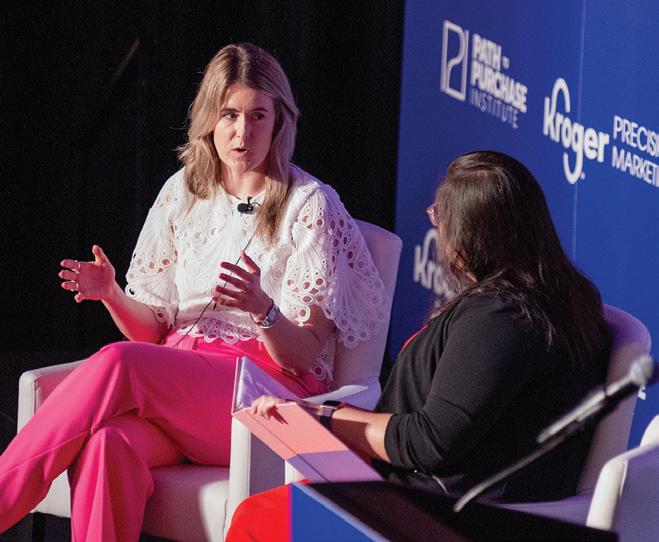
Loza and Wyatt discussed Albertsons’ media network as well as incrementality and the need for industry-wide standardization. Highlights from their conversation include:
• Because of all the brands investing in retail media, it’s almost becoming unsustainable with the amount of RMNs out there currently, according to Wyatt.
• The growth is eventually going to stall if retail media networks can’t figure out how to create ways to work better together and for brand advertisers.
• “Retail media is like social media was 10 years ago, or how programmatic was 15-20 years ago.”
• Marketers should look holistically at media budgets.
• There are four areas of focus Wyatt says we need to acknowledge in the push for standardization:
- Measurement and performance metrics, and does the industry at large define these words and methodologies the same?
- Product specifications.
- Third-party verification.
- Retail media capabilities.
• Transparency of incrementality methodology and what third-party verification retailers provide is needed going forward.
• Wyatt thinks all RMNs should change their definitions and names of channels and methodologies to make it easier for marketers.
Speakers: Charlie Menchaca, Managing Editor, Path to Purchase Institute, Matt Cleary, U.S. Head of Retail & E-Commerce, Global Business Solutions, TikTok, and Diana Finster, Head of Partnerships, Walmart Connect

Menchaca facilitated a Q&A discussion covering TikTok and Walmart’s relationship and how the retailer has found success leveraging the shortform video sharing platform. Highlights from the session include:
• TikTok identified six data-driven best practices, including:
- Think TikTok first and scale assets.
- Leverage trends, which is one of the easiest ways to align relevance with a brand.
- Build with sound, which is somewhat unique to TikTok and not limited to just music, but also voiceovers and narrative devices, etc.
• Creative is crucial. Eighty-five percent of sales lift is driven by creative, indicating what works on different platforms.
• Walmart Connect creates efficiencies across the full funnel by looking across different places (e.g., search, off-site, social).
• Walmart and TikTok are testing paid ads and layering Walmart targeting and closed-loop measurement, which TikTok says is seeing high engagement with those video ads and 2 times higher engagement than TikTok’s benchmarks.
• “When advertising messaging is delivered as entertainment, we see a significant amount of engagement,” Cleary said.
• To show up authentically on TikTok, marketers should understand their customer or “community” and what brings them to the platform.
• Some things more brands should consider include:
- Don’t copy and paste across retail media networks.
- Don’t just focus on search.
- Think about TikTok as a way to push brand awareness.
- Think outside of the shopper marketing budget.
- Test and learn across the full funnel; also, go beyond #challenge trends.
- Consumer behavior will continue to change so following them where they go is important.
- It’s more important than ever to be specific about campaign objectives.
• Beyond ROAS, brands should focus on:
- TikTok measurements, metrics compared to benchmarks.
- Engagement metrics.
- Power of the view and understanding that view.
Speakers: Kelly Sheehan, VP, Advertiser and Agency Solutions, NCSolutions; and Kyle McWhirter, Senior Director & Head, Emerging Sales, Walmart Connect
Walmart Connect is NCSolutions’ client. NCSolutions provides incremental sales lift solutions for Walmart Connect to help show how the network drives sales at other retailers.
Shopper insights:
• Walmart shoppers are coming back to stores in droves, but that pattern of buying things online has proven to be really sticky, McWhirter said. Walmart’s customer base has evolved into an omnichannel consumer.
• Shoppers are increasingly going to multiple destinations online. A marketer’s job has never been harder because of the multiple touchpoints they need to engage in due to the collapse of the marketing funnel, McWhirter said.
• 53% of Americans said they saw a product advertised by one retailer, but purchased at another retailer, according to an NCSolutions consumer May 2023 study.
• 90% of American households shop at Walmart each year, and the retailer has 122 million customers who visit Walmart.com monthly.
Brands are interested in retail media:
• The U.S. retail media market will grow to $100 billion by 2026, according to McKinsey.
• 78% of brands use multiple retail media networks, according to a P2PI research report.
• 34% of marketers say retail media networks are an efficient method of advertising, according to a P2PI research report.
Why purchase-based targeting? Past purchasers are indicative of future buyers. Purchase-based targeting has three times the return on ad spend (ROAS) of other targeting methods for CPG companies, according to NCSolutions study of results from 750 digital advertising campaigns for more than 30 CPG brands totaling $258 million in online spend.
Stats from NCSolutions and CMO Council’s “Optimizing Outcomes in Media Marketing” 2023 report:
• 28% of marketers said that not knowing why their campaigns are successful holds back their marketing efforts.
• 85% evaluate media placements based on if they receive a sales lift report.
• 82% of marketers want to know about multiretailer sales.
Path to Purchase Institute members have access to thousands of images depicting displays and signs, and digital activity. Here’s a few examples of retail media activity available on P2PI.com.
Coca-Cola Co. used a promotional page with Target.com this summer to spotlight SKUs from Coke and Black-owned brands, including A Dozen Cousins and Yolele, as well as the manufacturer’s sponsorship of the 2023 Essence Festival of Culture this summer. A display ad within Target.com inviting shoppers to “refresh your meal time” and “explore Black-owned & supporting brands” directed shoppers to the page.

Haribo used a digital ad on a Freeosk sampling dispensing kiosk at Sam’s Club to plug “over 100 years of happiness” this summer.

A brand showcase on Meijer.com encouraged shoppers to “make every dae a lick more special” this summer by creating treats using Ben & Jerry’s, Talenti, Breyers and Klondike SKUs. The page shares a “frozen treat inspiration” for each day of the week including dropping a Talenti raspberry mini sorbetto bar into berry-flavored sparkling water for a treat on “Mondae.”
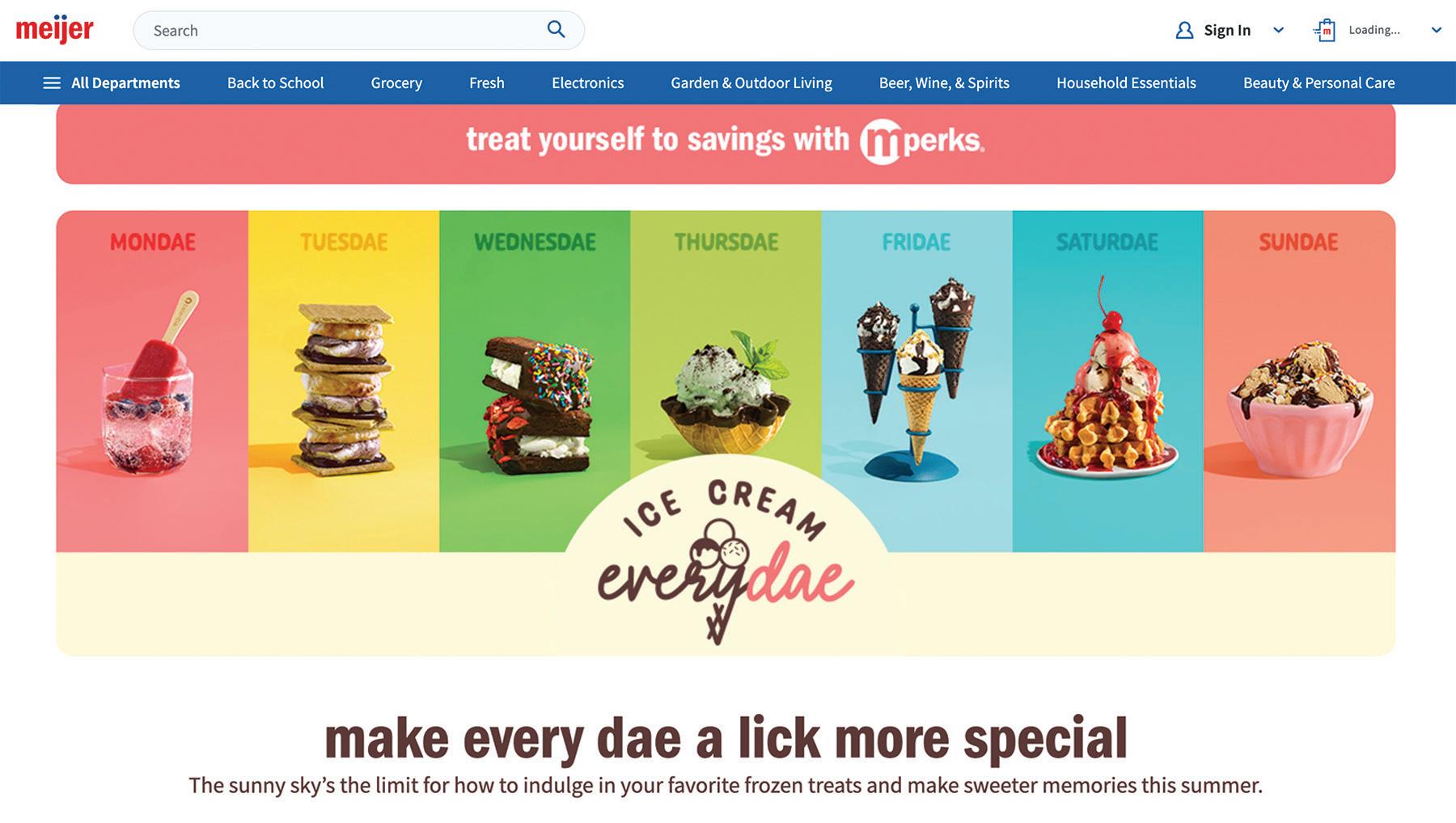

The Walt Disney Co. launched an exclusive Disney100 collection at PetSmart in May as it continued to celebrate its 100th anniversary with retail collaborations. A home page display ad on PetSmart.com linked to a showcase for the collection.

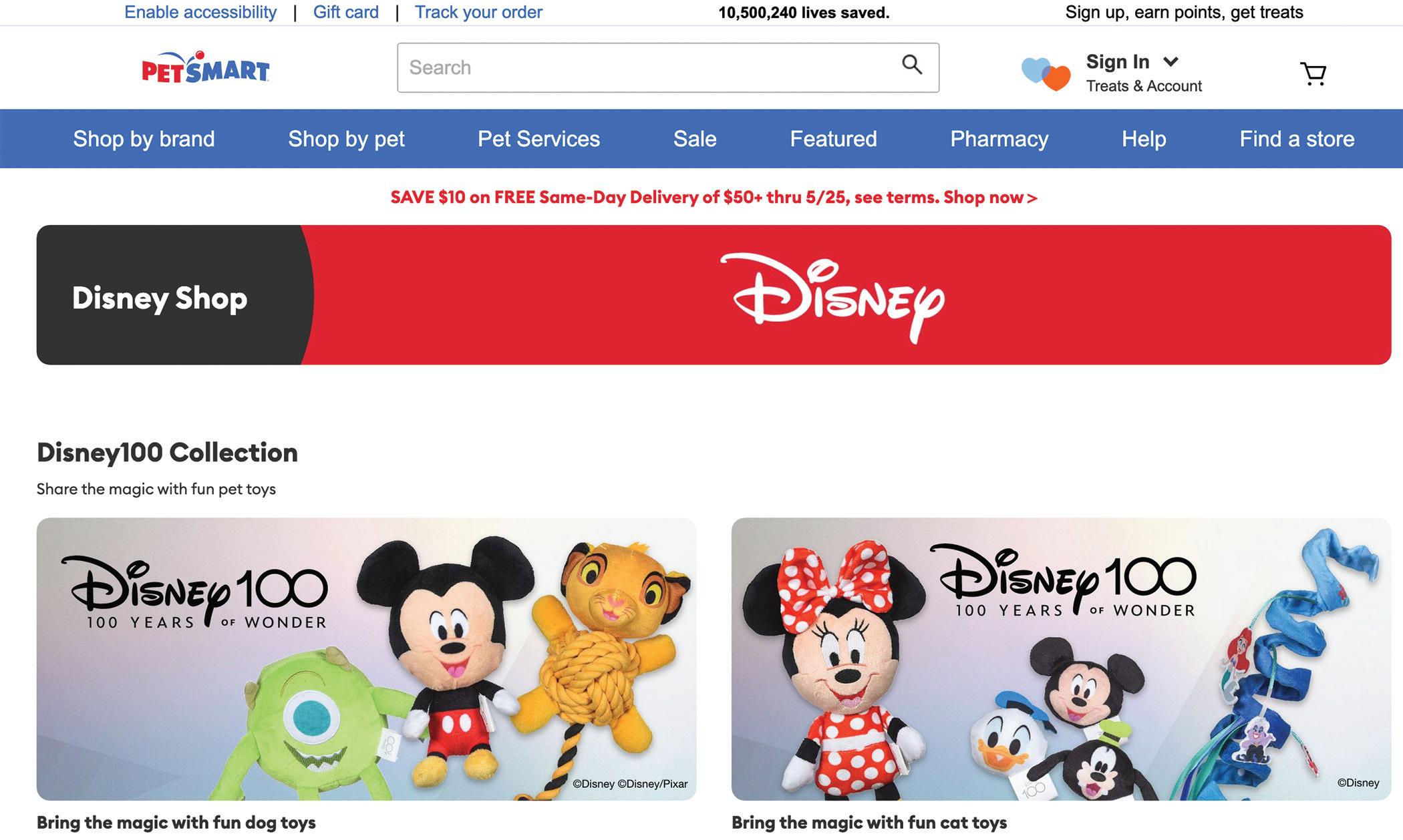
PepsiCo ran an ad on Kroger.com to tout the launch of its new Starry lemon-lime flavored soda earlier this year.

A leaderboard ad within Walmart.com touted the launch of Bare, a limitedingredient dandruff shampoo line from Procter & Gamble’s Head & Shoulders. The line launched exclusively at Walmart in May.

Nestle ran a digital campaign on Target.com positioning its Nespresso Vertuo coffee and espresso machines and compatible Starbucks capsules as ideal items to help shoppers develop their java rituals this new year. Employing a “craft your coffee ritual” message, a digital ad within Target.com invited shoppers to browse the full collection of Starbucks by Nespresso for Vertuo and directed them to a brand showcase.

Mondelez International employed a trio of home page display ads on Walmart.com to tout its pumpkin-flavored SKUs from brands including Oreo and Tate’s Bake Shop
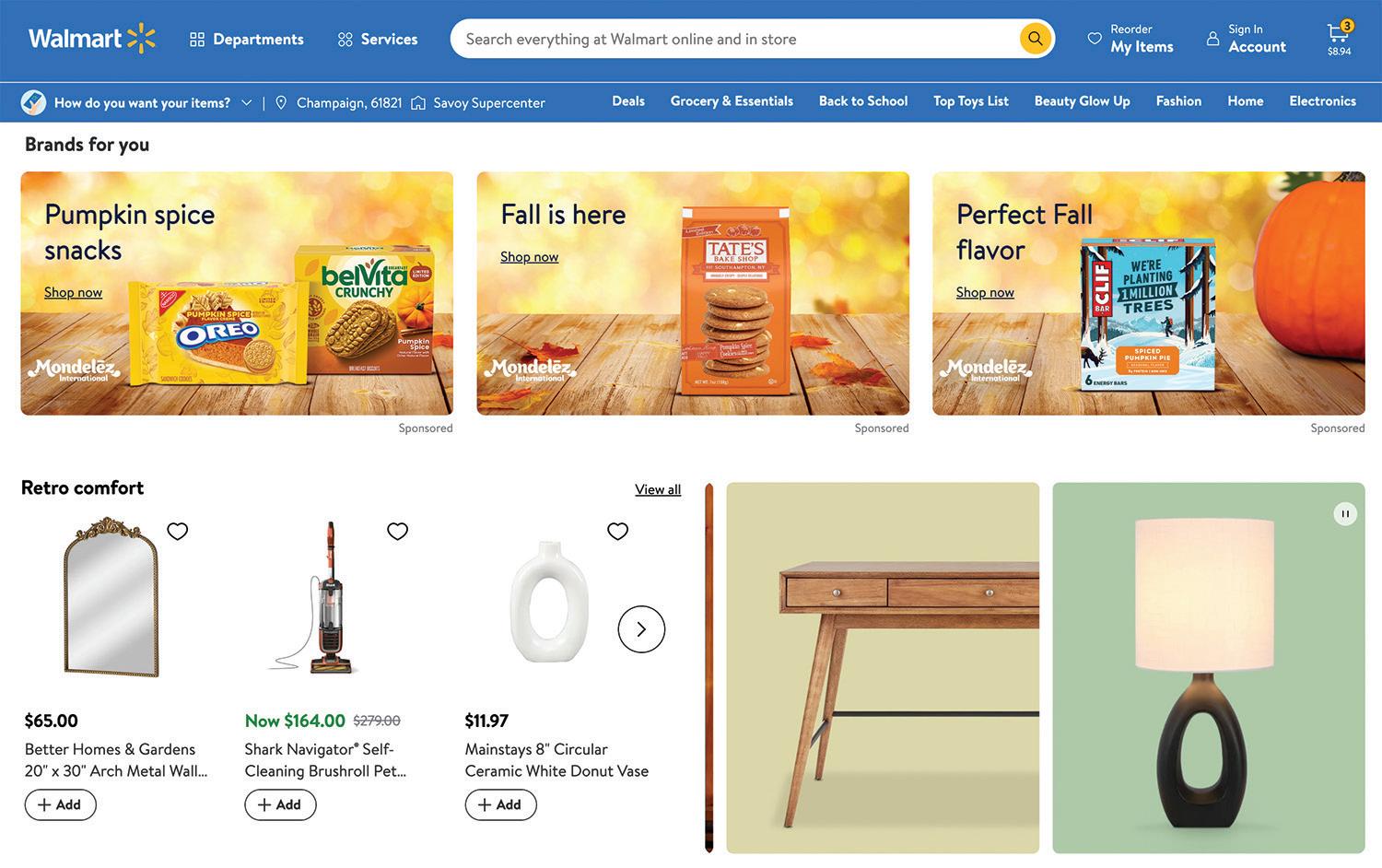
Haleon’s Sensodyne teamed with Walgreens to send an email to the drugstore chain’s shoppers this spring plugging the brand’s new toothpaste SKUs and a BOGO offer.

BlueTriton Brands’ Ice Mountain ran a banner ad on CVS.com in the summer promoting its sustainable sourced spring water and encouraging shopper to “join the journey to better.”

A brand showcase within Amazon.com earlier this year highlighted OTC SKUs from Bayer’s Alka-Seltzer Plus, including cold and flu effervescent tablets that dissolve in water, and extended-release tablets for cough and mucus, and communicated the differences between the diseases. (A fever, for example, is a common symptom of influenza but not a cold, while chest and nasal congestion are most often associated with a cold.) A display ad spotted on Weather.com depicting skiers and promising “unbeatably fast cold & flu release” directed shoppers to the showcase.
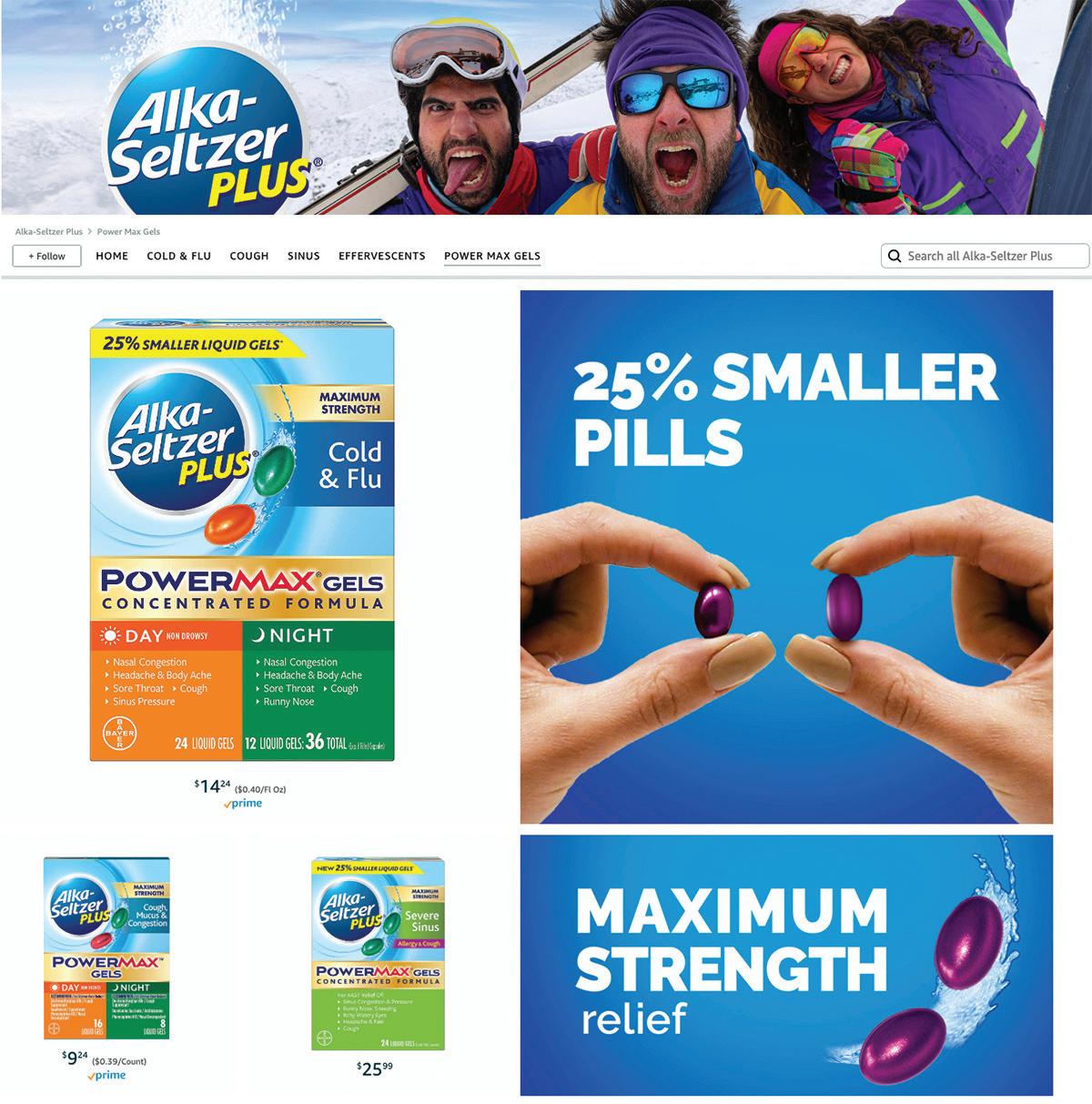
Procter & Gamble’s Olay used ads on cooler doors (via Cooler Screens) to spotlight its moisturizers at Walgreens in March.


The Path to Purchase Institute’s July 2023 “Engaging Shoppers In-Store” survey shares insights on in-store shopping habits and drivers as well as the overall in-store experience. The primary report is published in the September/ October issue of P2PI Magazine, as well as on P2PI.com. Here, we provide bonus content related to the health and beauty and specialty stores categories, building on the grocery stores results featured in the magazine.
Sponsored by Mood Media, the survey gathered responses from 1,000 shoppers varying in age from 18 to 56 and income levels from less than $35,000 to $150,000 or higher. The qualifying participants reported shopping in-store in one or more categories of interest, ranging from grocery, health and beauty and department stores to fashion/clothing stores, luxury, quick service/fast food, specialty stores and automotive dealerships.

The ever-evolving health and beauty category is a mainstay of shopping needs for many consumers. In a typical month, 53% of respondents noted shopping for health and beauty products in-store or online with 38% of consumers shopping in-store only.
Pleasant music and sound
Ability to personalize specific products to fit my needs
Screens with engaging or useful information Free Wi-Fi in the store
Interactive kiosks to order products not available in the store
Interactive digital screens
An area to hang out and relax Audio or video advertising
An area for children to play
Q. Which are the most important among these features to create an enjoyable in-store shopping atmosphere in health & beauty stores, if any? Select up to five items from the list below or write in your own response.
Q. In general, how would you rate the in-store shopping experience at health & beauty stores across each of these dimensions?
Health and beauty retailers seem to be in tune with the desired in-store experience of their shoppers. When evaluating the retail environment across a variety of dimensions, respondents identified scent (64%), ease of navigation (63%), overall ambiance (61%) and pleasant music/sound (60%) as top performance areas. Shoppers’
satisfaction in this category is influenced by a variety of factors, but a nice scent (43%) and pleasant music/sound (39%) are considered highly important, similar to other shopping categories. Nearly two-thirds of health and beauty shoppers admit to feeling happier in-store due to pleasant music or a nice scent.
Digital displays or video showing product benefits or comparing products to one another to help you make the best choice
Digital displays or videos showing you how to combine multiple product available in-store
Digital displays or video highlighting a retailer’s sustainability initiatives, responsible product sourcing practices, and/or charitable causes it supports
In-store radio or audio from brand ambassadors or influencers talking about a product
Digital displays or video featuring brand ambassadors or influencers for a product
Q. How valuable are, or would be, each of the following when considering shopping in health & beauty stores?
later online
Choose to continue shopping in-store rather than online
Build my trust in the brand/retailer
Feel happier
Feel more engaged with the brand/retailer
Explore the store for longer
Recommend store to others
Re-visit the store
Consider purchasing while in-store
Consider purchasing later online
Choose to continue shopping in-store rather than online
Q. Thinking specifically about health & beauty stores, which of these features would motivate you to do any of the following?
Personalization rises in the ranks for health and beauty shoppers. The ability to personalize the shopping experience and specific products contributes to greater shopper enjoyment in this category. Men in particular note the desire for screens with engaging and useful information, an area to relax and audio or video advertising as adding to an enjoyable in-store atmosphere.
For retailers looking to boost online sales instore, nearly half of respondents said in-store audio or video advertising would motivate them to consider online purchases later.
Health and beauty customers seem open to information and advice, presenting an opportunity to leverage digital displays and video to deepen in-store engagement. Over half of health and beauty shoppers find value in digital displays or video showing product benefits or comparisons and content demonstrating how to combine multiple products available in-store.
The unique needs and interests of today’s consumers are often best served with specialty stores. That is why this shopping category ranks high in monthly shopping, ranked third in our survey after grocery stores and quick-service/ fast-food restaurants. Each month, 53% of respondents shop in-store or online at specialty brands and retailers, with 39% shopping in-store only. This provides brands and retailers with opportunities to make the in-store experience as nuanced as the products and their shoppers.
When rating the in-store shopping experience, ambiance (62%) and ease of navigation (61%) top the list for specialty store shoppers. These
Ease
Ability to personalize the shopping experience
Ability to personalize specific products to fit my needs
Free Wi-Fi in the store
Screens with engaging or useful information
A nice scent in the store
Pleasant music and sound
Interactive kiosks to order products not available in the store
An area to hang out and relax
Audio or video advertising
Interactive digital screens
An area for children to play
Q. Which are the most important among these features to create an enjoyable in-store shopping atmosphere in specialty stores, if any? Select up to five items from the list below or write in your own response.
aspects of the experience are closely followed by satisfaction with the nice scent and pleasant sounds of the store. It is not surprising that specialty store shoppers are looking for customization. The ability to personalize the experience and specific products to suit their needs are the primary contributing factors to creating an enjoyable in-store experience. It is particularly important to Gen Z and Millennial shoppers in this category. Brands and retailers looking to deepen connections with their shoppers should focus on sensory stimulation. Approximately three out of five shoppers admit that pleasant music or sound and interactive digital screens would motivate them to explore a store longer. Furthermore, interactive digital content would encourage them to revisit the store. Other digital enhancements to consider are interactive kiosks.
A nice scent in the store
Pleasant music and sound
Ability to customize my shopping experience
Audio or video advertising
Interactive technology that enhances my experience
Fifty-four percent of shoppers note access to kiosks would motivate them to consider purchasing while in-store.
When planning for content creation, brands and retailers have an opportunity to capture attention with digital displays or videos showing product benefits or comparing products as well as content showing how to
combine multiple products. More than 50% of respondents consider this type of product information valuable and engaging. Digital content featuring brand ambassadors (45%) or highlighting the retailer’s sustainability initiatives, corporate responsibility and charitable causes (44%) was also of interest to specialty store shoppers.
Digital displays or video showing product benefits or comparing products to one another to help you make the best choice
Digital displays or videos showing you how to combine multiple product available in-store
Digital displays or video featuring brand ambassadors or influencers for a product
Digital displays or video highlighting a retailer’s sustainability initiatives, responsible product sourcing practices, and/or charitable causes it supports
Q. How valuable are, or would be, each of the following when considering shopping in specialty stores?
Feel happier
Feel more engaged with the brand/retailer
Explore the store for longer
Recommend store to others
Consider
Q. Thinking specifically about specialty stores, which of these features would motivate you to do any of the following?
Retail media is flourishing, with Insider Intelligence predicting it will become a $55 billion market with double-digit growth by 2024. This surge in investment reflects retail media’s strategic importance for both brands and agencies. This growth can be attributed to the unique combination of two powerful elements: first-party data and closed-loop measurement (CLM).
At the heart of the retail media revolution lies first-party data — the treasure trove of consumer information collected directly from retailers’ owned channels, such as websites, mobile apps and loyalty programs.
Retailers possess a deep understanding of their customers’ preferences, purchase history and shopping behaviors, enabling them to create highly targeted and personalized ad experiences.
“Traditional advertising has lost trust and impact,” says Michael Schuh, vice president of media strategy and product at Kroger Precision Marketing. “Now, retailers are driving more relevant ad measurement across the entire media ecosystem. Retail media is equipping brands and publishers with sales data to make better media investment decisions.”

By leveraging first-party data, retail media networks (RMNs) can bridge the gap between advertising and sales. Advertisers can now reach their desired audience with laser-like precision, tailoring their messages to resonate with specific segments based on demographics, purchase intent, and browsing behavior. This level of personalization not only enhances the customer experience but also maximizes the impact of advertising campaigns, driving higher engagement and conversion rates.
Through closed-loop measurement, retail media networks can provide advertisers with a comprehensive view of the customer journey, from initial awareness to purchase and beyond. By tracking shopper behavior across multiple touch points, including website visits, email sign-ups, and online purchases, advertisers can understand which channels and campaigns are most effective at driving conversions. This valuable insight enables advertisers to tailor their marketing efforts, to personalize product recommendations, and to deliver more relevant and engaging content to their target audience.
The benefits of closed-loop measurement in retail media are clear. It offers advertisers accurate and actionable data to track the impact of their advertising efforts,
optimize their strategies, and engage with consumers across various channels effectively. By leveraging first-party data, attribution models, and targeted ad formats, retail media networks can provide a complete view of the customer journey, helping advertisers make informed decisions to drive growth and profitability.
“Measurement is a common concern for our community of retailers, brands, agencies and solution providers,” says Cyndi Loza, P2PI’s managing editor, member content. “From our vantage point, measurement standardization is imperative for the growth of retail media, especially as the sector grows increasingly crowded and new retailer media networks and partners pop up regularly.”
However, with growth comes complexity, and a central concern has arisen regarding the lack of measurement standardization across RMNs. The wide array of retailer offerings and metrics currently present a challenge for accurately evaluating campaign performance and optimizing investment across RMNs. There’s a recognized need for greater transparency into the quality of data provided by retailers and a standardized approach to evaluating campaign performance across different platforms.
To address these issues, the Interactive Advertising Bureau (IAB) officially launched a Retail Media Network Committee in 2022, then the Retail Media Measurement Working Group in April 2023. This task force, developed in partnership with the Media Rating Council (MRC), convenes retail media networks, agencies, brands and select ad tech companies.
“Gathering to take a holistic view and approach to pressure test and formalize measurement standards and guidelines is important for every facet of campaign management – whether it’s planning, audience targeting, optimization, performance measurement and creative best practices,” says Jill Cruz, executive vice president, commerce strategy, Publicis Commerce, and co-chair of the IAB Retail Media Measurement Working Group. “This is also helping to minimize the burden that for too long has fallen on advertisers and agencies to navigate the complexities and fragmentation of retail media and it’s also helping to expedite success across these maturing retail media platforms.”
To realize the full potential of retail media, the industry must emphasize the importance of measurement and deliver the peace of mind that advertisers seek. With the right measurement and attribution, advertisers will gain confidence in the value of investing in retail media, making it a key player in the evolving advertising landscape.
The Path to Purchase Institute, in partnership with Criteo, hosts “Retail Media Unplugged” — a six-episode video series that dives into the nitty gritty of retail media to explore the latest trends, strategies and tactics for success. In each episode, we go behind the scenes with our special guests to dig into how they’re navigating the evolving realm of retail media. Here are a few soundbites from our guests.
My advice ... is to get into this space at the foundation, in the area that’s going to help you demonstrate its success the soonest and the clearest and that would be sponsored product. Ensuring that your products are shown not only in search results, but in shelves, across a retailer experience — Shipt’s or others — I think is fundamental to being able to show the value of a retail media investment. But don’t just stop at the fundamentals. Have an idea of what you want to grow into and what your goals are because those could be different for share gain or launching a new, innovation product and knowing what that next channel would be, or what even the blue sky approach to a retail media campaign would look like if you could do it all for a given goal I think is an important place for brands to start before they even start investing dollars because that’s how myself, as a partner, can help you continue to engage in measure your success as you grow.
— Dave Young , vice president of CPG partnerships, Shipt


Right now, brands are super-focused on ROAS when it comes to retail media, and I’m not saying that that’s the wrong approach, but I think that other metrics should really be evaluated depending upon what the brand is trying to accomplish. If ROAS is at the forefront, we want to help you craft that campaign, but if you get two micro-focused on the performative nature of these ads, you’re going to miss the broader opportunity of things like lifetime value, and repeat purchase, awareness for new product launches and so much more. I think that brands are starting to consider other KPIs and they’re shifting away from just strictly looking at ROAS, and they’re starting to think about things like share of voice and more analytics, and we think that trend is really going to continue. And, for the record, I don’t think that this necessarily falls on the brand to determine exactly what the KPI is. I think it’s our job at Criteo and Roundel to really show the value of advanced reporting and KPIs and insights. I think there’s a lot of different ways that we can be thinking about this.
 — Ryan Britton, vice president of retail media sales, Criteo
— Ryan Britton, vice president of retail media sales, Criteo

We consistently hear, ‘You guys are grading your own homework.’ ... I think there needs to be more transparency. I think we retailers, as we build retail media networks, we have to create trust, transparency and, more importantly, standardization of metrics that are consistent across all retail media networks because as brands start to look at apples for apples comparison. How do we actually deliver that promise? And it might even just be an open and honest conversation with our supplier partners around helping them understand the methodology and the way in which we are driving reporting and performance. We’re very much leaning into that. We want to provide more transparency for any of our supplies who are digging in. We want to make sure that we’re providing that level of detail to them, but I think the rest of the industry needs to as well.
— Parbinder Dhariwal, vice president and general manager, CVS Media Exchange
Last January, Criteo started providing Target’s in-store sales data for sponsored product ads to brand advertisers, and what we’re seeing is there is absolutely a lift on our return on ad spend when we take into consideration, what happens in-store, in addition to what happens online. [This] is another signal to us of how [shoppers] are acknowledging the sponsored ad and driving behavior, which might not be an immediate conversion in store, it might be a conversion that happens either same day or later that week in store as a result of the ad that they saw.
— James Gourde, senior director of partner solutions, Roundel






A lot of times we talk about ‘engagement’ we’ll say ‘experience,’ and internally we say ‘journey,’ but at the end of the day it’s our ‘path to purchase.’ I think some things that we had to do was take a look at that path to purchase and [ask] how does our customer engage at what points? Who touches that point, how do we engage that point and how do we align ourselves along that path or that journey?
— Damian Scott , executive vice president of Retail Media and Front-End Digital Development, Giant Eagle


Embrace the full diversity of retailers out there. Recognize that it’s not just your top one, two [or] three historical retail media partners that are essential to reaching shoppers. You got to go run the full gamut because, generally speaking, I find that most brands have a huge mismatch between where their products are getting sold from a [gross merchandise value] perspective and where retail media dollars are getting allocated, and that mismatch can’t last for long. You’re just not going to be relevant to the customer in that landscape.
— Michael Greene, senior vice president of global vertical strategy, Criteoretailers simultaneously CPGs are able to put their product s in front of grocer y shoppers at crucial moment s in their purchase million shoppers nationwide, Adsta is the per fect complement to brands’ existing media plan.
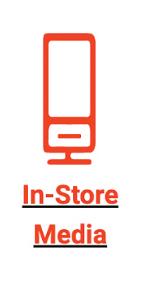
The majorit y of Retail Media Net works (RMNs) are controlled by national chains that force CPGs to play by their rules Adsta provides brands flexibilit y with their adver tising, allowing them to prioritize their goals and specif ic objectives. In addition to unprecedented levels of control when compared to other RMNs, Adsta also provides crucial access to valuable insight s and f irst-par t y data to help brands bet ter understand their customers and what is working in their outreach
RMN’s are still in their infancy, and brands
to identif y the best use of their adver tising budget s Adsta helps brands diversif y their ad spend, and expand their reach. With access to millions of shoppers with a single implementation, Adsta helps simplif y the execution process and get s brands the most value from their ad spend
Adsta is an expanding grocer y Retail Media Network (RMN) with a multichannel they are making grocer y buying decisions. that collect valuable analytics and essential first-par ty data
Adsta works directly with brands big and small to are distributed via our net work of grocer y digital platforms. We also power the retail media platforms of the nation’s largest grocer y wholesalers
KEY PARTNERSHIPS
• InMobi









• National & Regional Wholesalers


• AppCard and other digital coupon providers


Shawn Tucket t shawn@adsta.com Al Jones al@adsta.com



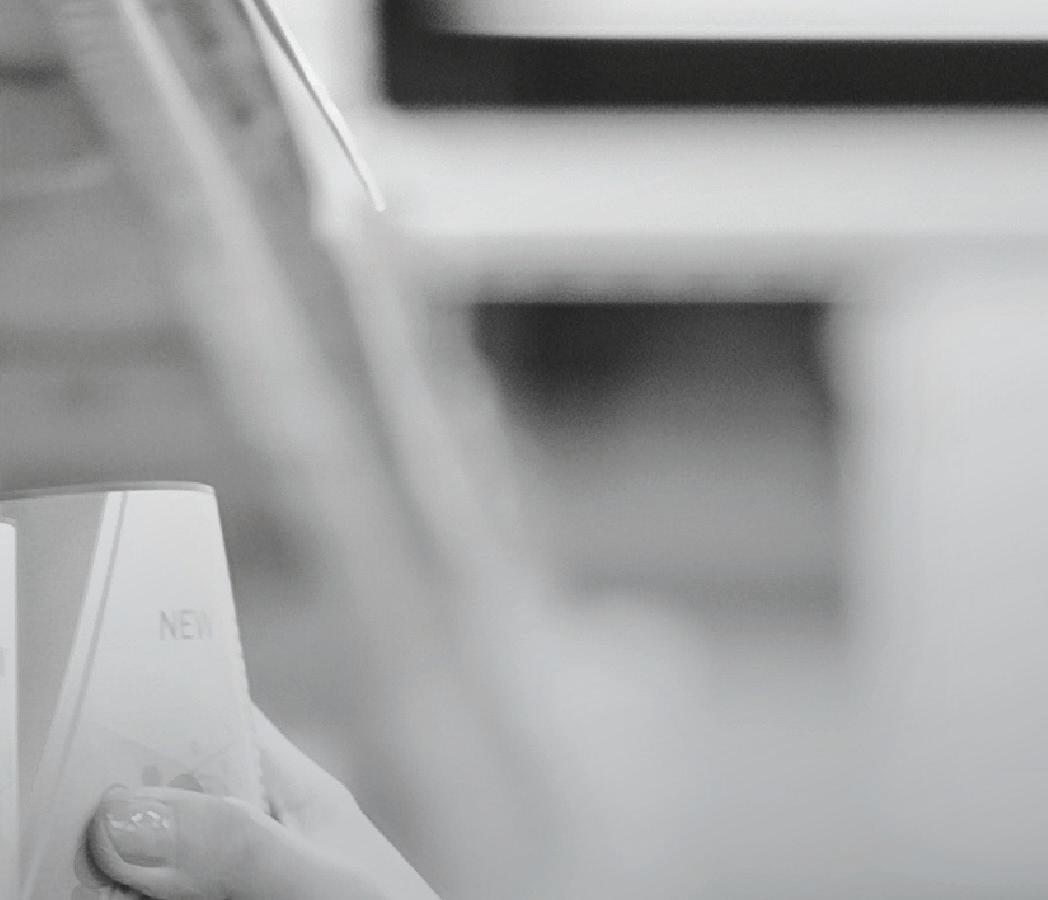























Albertsons Media Collective strives to be a trusted media partner that drives growth and builds lifelong customers for retail brands through data-driven insights. Let’s transform retail media through collaborative innovation together.

CONNECT WITH US ON LINKEDIN

Albertsons was built as a collective of local grocery stores, on a mission to bring people together around the joys of food.

Albertsons Media Collective was born in 2021 and is laser focused on creating connections, accelerating mutual growth and better serving our customers in-store and online.
Connect brands with shoppers, at the right moment. Create results through data-driven insights. Lead industry-revolutionizing innovation.
Cultivate strong partnerships.
mediacollective@albertsons.com
AlbertsonsMediaCollective.com














































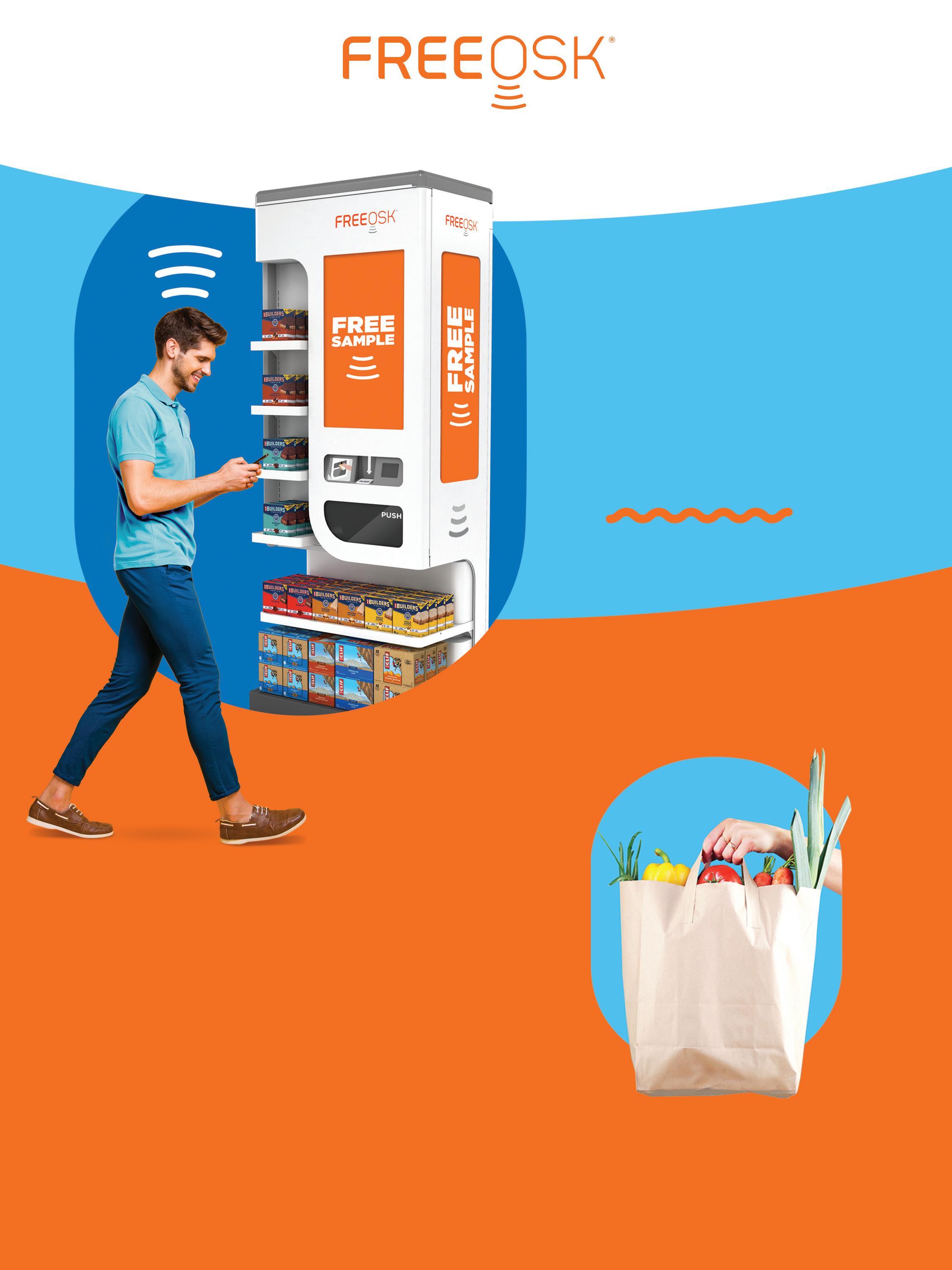















Goodway Group builds, operates, and deploys retail media network operations at scale for both retailers and brands. We dive deep to create more profit and growth through connecting disparate data services, better measurement, and vendor optimization.

The future of retail media offers a sea of endless opportunities that can be unlocked by bringing together the perfect trifecta of experienced people, innovative tech and proven processes. One-size-fits-all methods won’t work. Your brand narrative is one of a kind, requiring strategies as unique as your vision.
• Full Digital Commerce Strategy: Integrate open web, social and CTV for broad-scale customer reach.

• Industry-Leading Media Measurement + Modeling


• Architecture and Upgrades for Retail Media Networks
• Optimized Vendor Ecosystem
• Product and Sales Model Development
• Cross-Platform Data Engineering

Featured Partnerships (to name just a few)

Your customers crave seamless experiences.
It’s time to evolve. Instead of isolating retail media, integrate it into a harmonized omnichannel marketing mix. By connecting the dots, we help you speak directly to your customer’s journey.
DIVE INTO THE FUTURE OF PERSONALIZED RETAIL MEDIA
let’s chat
 MARC DUCNUIGEEN , Chief Client Officer mducnuigeen@goodwaygroup.com
MARC DUCNUIGEEN , Chief Client Officer mducnuigeen@goodwaygroup.com
InMobi is the leading Supply-Side Platform driving the next phase of growth in retail media with Video, AI and Mobile. Whether you are looking for easy-to-implement features to get your retail media journey started or for the latest innovative solutions to help get you to the next level, InMobi is here to help you drive towards the future.

How do I become a leader in retail media?
Find a partner that gives you:
• OnSite features that maximize your bottom line and unlock new media budgets, like our Full -Funnel Ad Experiences


• Differentiated, streamlined solutions like our Autonomous AI features that work for retailers at all stages of retail media

• OffSite extensions that make increase your media scale and deliver ROAS back to your advertising partners
How do I drive more revenue without the need for additional advertising inventory?


Offer your advertisers OnSite Video experiences to drive unparalleled brand awareness and consideration alongside standard sponsored product formats, unlocking new budgets that you previously had no access to.

How do I add new retailers to my retail media program without increasing headcount?
AI-led innovations and solutions for campaign set-up and optimization will save your teams time and increase your bandwidth to offer retail media opportunities to all your advertising partners, big or small.
How do I scale retail media, no matter my size as a brand?
Utilizing the largest independent OffSite platform for Mobile retail media gives you access to some of the most valuable audiences at scale on the biggest channel for ecommerce today.
•
The only Retail Media SSP leveraging Mobile, AI and Video.


Learn more about the InMobi Retail Media solution here.

















As Target’s retail media network, we design meaningful media connections that create a long-lasting relationship between our guests and the brands they love.

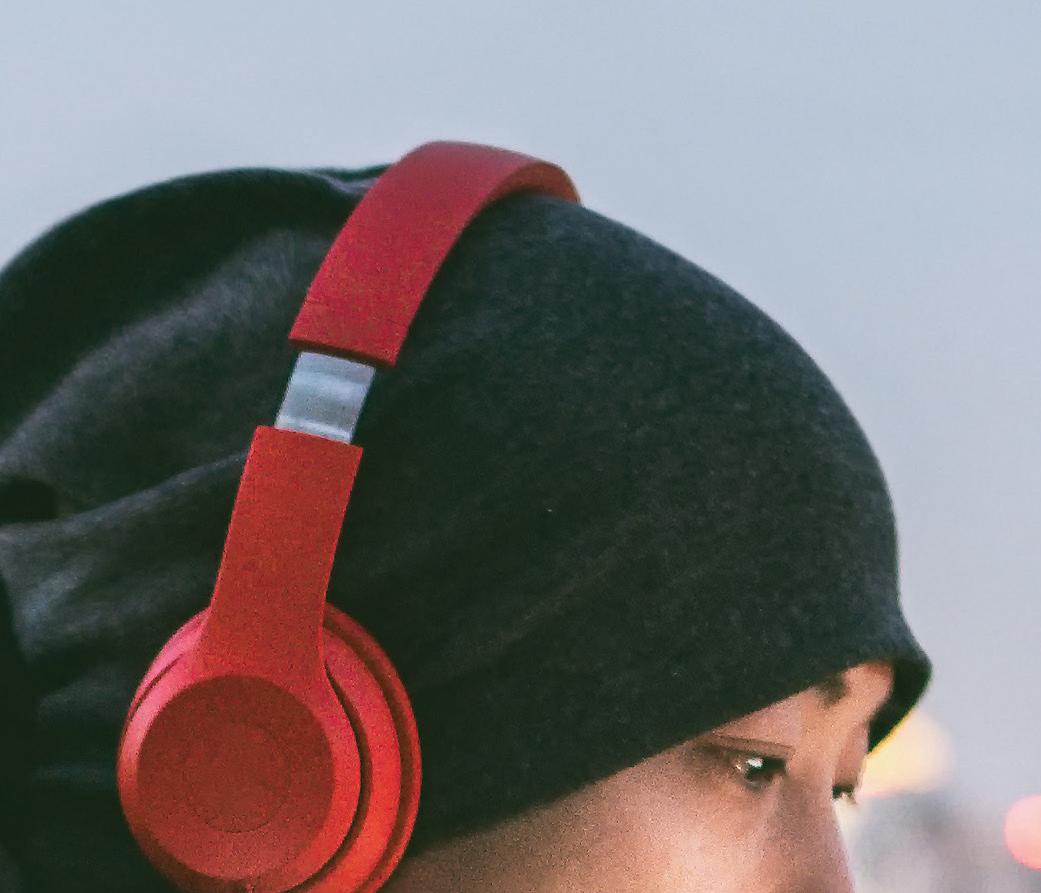



Using first-party data from 165M+ Target shoppers, we design insights that help your brand connect to Target guests across their preferred channels. Paired with measurement that proves ROAS and helps inform future campaigns, you can grow sales and loyalty.





Through our multichannel approach, we design experiences that engage Target guests in the moment by leveraging CTV, display, influencer, search, social, audio, and programmatic.



Sam’s Club Member Access Platform (MAP) is a retail access and ads platform centered on the Sam’s Club member. We reach members everywhere they shop with data on digital and physical transactions.
Our membership model makes our industry-leading measurement possible, connecting impressions to transactions.
We are among the first and possibly the only retail media platform to connect search ads to physical and digital sales, revealing the impact of your campaigns.
Our innovative dashboard seamlessly integrates display and search performance with sales data, providing key insights for in-flight optimizations.
• Search and display ads in the digital Sam’s Club experience
• Programmatic media across the digital ecosystem
• Unique member experiences during key moments and seasons
We partner with advertisers, agencies, and merchants to build a long-term growth strategy to better serve Sam’s Club members together.
CONTACT US:
Austin Leonard, Head of Sales
ALeonard@samsclub.com
Headquartered in Bentonville, Arkansas
• Third-party verified sales and campaign measurement
• Audience building and data collaboration
• A network of certified partners, agencies, and technologies
• Agencies + APIs: CommerceIQ, FlyWheel, Harvest Group, Pacvue, Skai, Stackline
• Data Collaboration: LiveRamp
• Measurement: Circana
• Offsite: The Trade Desk
• Social: Pinterest
Our membership model means we know how members shop and search. Sam’s Club MAP helps you reach them at the perfect moment—however they want to shop, digitally or physically.


REACH OUR UNIQUE MEMBERS
Connect with high-value, higherspending Millennials, Gen Z, and growing families.
GROW YOUR SALES
Find new buyers through curated search experiences and omnichannel touchpoints.

MEASURE AND OPTIMIZE
























Attribute physical sales to digital ads, even search.
Ready to accelerate your growth at Sam’s Club?
Scan this code to get started!

Connect your omnichannel brand messaging to the final point of decision in-store with shelfAdz.

70+ LEADING RETAILERS
60K+ RETAIL STORES
More than double the reach of retailer digital audiences, in-store retail media enables brand advertisers to reach relevant shoppers at scale* *Source: Insider Intelligence; Comscore, Placer.ai
As the industry leader in shelf-edge media, Vestcom enables retailers and CPGs to better engage shoppers at their critical point of decision through its item-specific shelf-edge media solution, shelfAdz.

Flexible, customizable capabilities
∙Item-specific messaging with UPC specific creative
∙Range of tactics to meet your marketing objectives: brand equity, new item, digital offers, QR code, portfolio, seasonal offers
∙Price tag integration drives unsurpassed compliance
∙Speed-to-market in less than 6 weeks
Measurable conversion that delivers rue incremental impact industry-leading test & control measurement tied to store-level POS data
10-20%
$ 2-3
In-store media at national scale
Tap into Vestcom’s network of leading retailers to generate high-quality impressions at scale across 60,000+ stores
Reach out to media@vestcom.com to learn more.



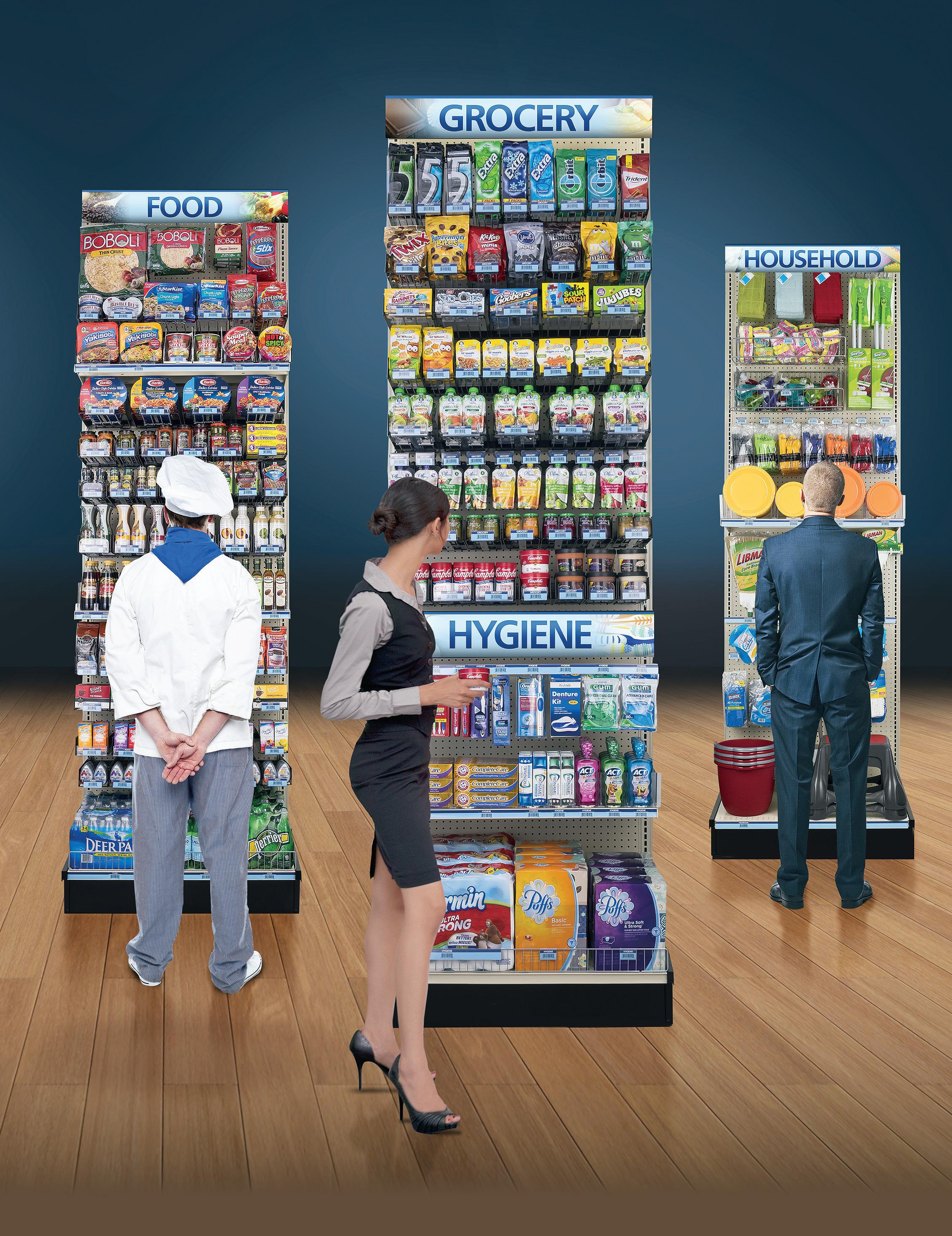


The forecast is a cold cooler front when you use Trion’s Air Flow Baffle in coolers. Product temperature can be difficult to maintain at the front of a cooler. This Air Flow Baffle ensures that cold air is forced forward to keep items at their ideal temperature. Use as part of your cooler outfitting strategy, along with WonderBar ® Bar Merchandisers and hooks, EWTTM Expandable Wire Tray System, and cooler capable Clear Scan® label holders.
Call 800-444-4665 | TrionOnline.com
Product offerings come in different sizes, so it makes sense that displays should come in different sizes, too. That’s why Trion created the WonderBar ® Expandable Wire Tray System. We included every feature you would want if you created it yourself: powder-coated galvanized wire that stands up to harsh environments; adjustable width; easy custom configuration; rail mount and freestanding units; wire or clear acrylic product stops. EWT mounts on pegboard, slatwall, gondola shelf, table top and cooler.
Product offerings come in different sizes, so it makes sense that displays should come in different sizes, too. That’s why Trion created the WonderBar® Expandable Wire Tray System, aka EWT. We included every feature you would want if you created it yourself: powdercoated galvanized wire that stands up to harsh environments; adjustable width; easy custom configuration; rail mount and freestanding units; wire or clear acrylic product stops. EWT mounts on pegboard, slatwall, gondola shelf, table top and cooler.
Call 800-444-4665 | TrionOnline.com
Call 800-444-4665 | TrionOnline.com

Think of these extruded signs as a GPS for your retail setting. Quickly guide customers to the products they want and need with these versatile sign holders. Plan your customer’s routes, then slide in signs when you’re ready. Creative merchandisers might also use these sign holders for monthly or weekly specials, buy-one-get-one offers, specialized category definition (think gluten free, organic, fair trade, etc.), or promotion of in-store loyalty cards. A variety of mounting options are available including hooks, push pin, and foam tape. The opportunities for use are endless.
Think of these extruded signs as a GPS for your retail setting. Quickly guide customers to the products they want and need with these versatile sign holders. Plan your customer’s routes, then slide in signs when you’re ready. Creative merchandisers might also use these sign holders for monthly or weekly specials, buy-one-get-one offers, specialized category definition (think gluten free, organic, fair trade, etc.), or promotion of in-store loyalty cards. A variety of mounting options are available including hooks, push pin, and foam tape. The opportunities for use are endless.
Bin there, organized that! Trion’s deck fencing helps you bin small, large, bulk or packaged items while keeping them accessible to customers. Customize your display to create closed-front or open-front compartments using straight or offset front fence, then add our convenient labeling systems to finish the job right. Call 800-444-4665 | TrionOnline.com
If you think the WonderBar EWT is great, wait till you meet its big brother! Oversized just like some of your products, this weightlifter stays strong on both metal and open wire shelves and bar. One-piece installation means you can drop this bad boy right into place, adjust as needed, and watch the revenue increase. The EWT takes over from there, automatically feeding product to the front and billboarding merchandise for maximum visibility. Call 800-444-4665 | TrionOnline.com

Use ZIP Track ® storewide for neat and tidy health, beauty and wellness displays. This is the most versatile system of its kind on the market. Easy to install, ZIP Track® components clip on a front rail allowing lanes to adjust quickly, even when full or to add additional facings. Use actual product to set lane width from 2" up to 3 3/4 " Slide product front-to-back to “ZIP” each track together. Custom spring tensions and lane depths are available to fit any and all shelf and product needs. Manufactured from durable, modern plastics, ZIP Track® provides an extended merchandising life.
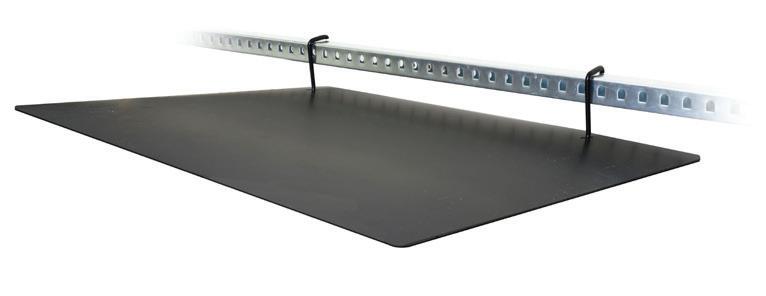

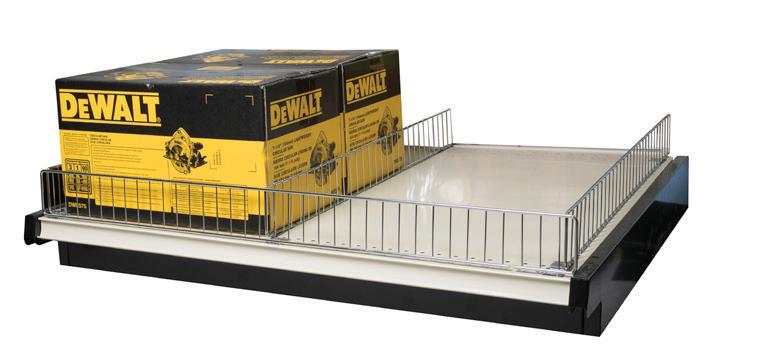

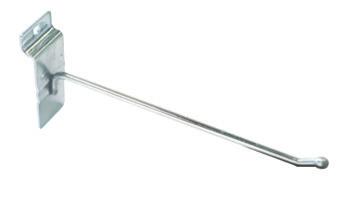
Let’s review your wish list of slatwall hook features: flat back plate base? Trion’s got it. Even load distribution?
Let’s review your wish list of slatwall hook features: flat back plate base?
Call 800-444-4665 | TrionOnline.com
Neatly and effectively display cooler and freezer items, including yogurt, dips, puddings, ice cream, single-serve foods, and more. Our small Adjustable Merchandising Tray (AMT) fits a range of 4- to 6-ounce cups; the medium AMT organizes mid-range offerings; and the large AMT gives ice cream lovers pause to browse and choose a pint of their favorite flavor (hmmm why not get both Cherry Vanilla and Rocky Road?). This manual-feed tray ensures that products remain faced and accessible. Time to re-stock? Just lift out and refill. Add Clear Scan® Label Holder, and you’re finished!


Call 800-444-4665 | TrionOnline.com
Call 800-444-4665 | TrionOnline.com
WonderBar® Displays are the versatile heroes of the Trion product family, coming to the rescue when you need muscle and good looks to merchandise items of all sizes. These Bar Hooks can lift heavy loads in their capable arms. Display or Scan, Saddle Mount or Plug in, there are Trion WonderBar Hooks for every need.
Trion’s got it. Even load distribution?
Check. Customizable with Clear Scan Labels? Yep. Flip-front or metal plate
Check. Customizable with Clear Scan Labels? Yep. Flip-front or metal plate Label Holder, gotcha. Like your varied products, Trion’s Slatwall Hooks are offered in a range of standard, medium, heavy, and extra heavy gauges. Our hooks fit all industry standard slatwall slots, and many work with slot inserts. Call for a sample to check the fit with your design.
Label Holder, gotcha. Like your varied products, Trion’s Slatwall Hooks are offered in a range of standard, medium, heavy, and extra heavy gauges. Our hooks fit all industry standard slatwall slots, and many work with slot inserts. Call for a sample to check the fit with your design.
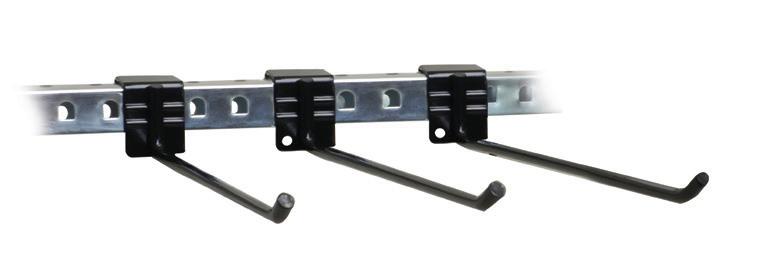






The forecast is a cold cooler front when you use Trion’s Air Flow Baffle in coolers. Product temperature can be difficult to maintain at the front of a cooler. This Air Flow Baffle ensures that cold air is forced forward to keep items at their ideal temperature. Use as part of your cooler outfitting strategy, along with WonderBar ® Bar Merchandisers and hooks, EWTTM Expandable Wire Tray System, and cooler capable Clear Scan® label holders.
This mini tray leads to maximum revenue, because it allows complimentary items to be featured together. Dual lanes adjust to fit narrow merchandise sizes as small as 1 3⁄4 ". Each lane features a separate pusher paddle to keep products forwarded and faced. Feature items of different widths via asymmetric lane configurations. Cross merchandise a variety of products with ease. Trays install without tools and lift out for quick restocking or product rotation. Full line includes standard and oversize trays, and display, scan and pusher hooks. Call 800-444-4665 | TrionOnline.com

These strong, downward-canted waterfall hooks lift more weights than a personal trainer. Ready for a workout, Trion Industries’ hooks display heavy products, like free weights in multiple sizes, with both sales and safety in mind. Your customers can easily browse the merchandise, which is held in place by built-in pins to keep product from shifting or falling. Exercise your opportunity to cross-sell related products and keep your bottom line in shape! Of course these waterfall utility
Merchandise all size drinks from mini Red Bull® cans to oversized Gatorade® bottles. ZIP Track® is the most versatile and cost-effective Grab-and-Go system available on the market. Use actual product to set lane width from 2" to 3 3/4 " Reset lane width on set-up in less than 30 seconds. Shelf-based and coolerready, this anchored system billboards product for easy selection and fast sale. ZIP Track® forwards and faces product at all times. Quickly add lanes with this easy to install and adjust system. ZIP Track® offers a wide range of adjustability for this ever-evolving beverage category and changing package designs.

Call 800-444-4665 | TrionOnline.com
This bottom is tops for displaying heavy, bulky, or hard-to-fit items. Display them attractively and neatly using front fencing and dividers to customize the display space and create unique presentations of similar or related items. This cross-selling approach makes shopping easier for the customer and more profitable for you. Select from a range of other Trion outfitting to maximize selling space from the base deck to the top shelf and beyond. Call 800-444-4665 | TrionOnline.com

Mirror, mirror on the wall. You can be the most difficult item to display of all. Clever merchandisers use large literature holders for three-dimensional, awkwardly sized items like mirrors, framed art, clocks, and more. Available in a range of sizes, gauges, and weights, Trion’s large literature holders can be spaced horizontally to accommodate all manner of product sizes.
Call 800-444-4665 | TrionOnline.com
If you think the WonderBar EWT is great, wait till you meet its big brother! Oversized just like some of your products, this weightlifter stays strong on both metal and open wire shelves and bar. One-piece installation means you can drop this bad boy right into place, adjust as needed, and watch the revenue increase. The EWT takes over from there, automatically feeding product to the front and billboarding merchandise for maximum visibility. Call 800-444-4665 | TrionOnline.com


What do you want your customers to know? Want to promote great prices or unique product features? Add wall tags to your displays faster than you can say “sign up!” Wall tags allow you to mount your product and price separately on vertical display surfaces, for cleaner overall presentation.
Neatly and effectively display cooler and freezer items, including yogurt, dips, puddings, ice cream, single-serve foods, and more. Our small Adjustable Merchandising Tray (AMT) fits a range of 4- to 6-ounce cups; the medium AMT organizes mid-range offerings; and the large AMT gives ice cream lovers pause to browse and choose a pint of their favorite flavor (hmmm why not get both Cherry Vanilla and Rocky Road?). This manual-feed tray ensures that products remain faced and accessible. Time to re-stock? Just lift out and refill. Add Clear Scan® Label Holder, and you’re finished!

Call 800-444-4665 | TrionOnline.com
These strong, downward-canted waterfall hooks lift more weights than a personal trainer. Ready for a workout, Trion Industries’ hooks display heavy products, like free weights in multiple sizes, with both sales and safety in mind. Your customers can easily browse the merchandise, which is held in place by built-in pins to keep product from shifting or falling. Exercise your opportunity to cross-sell related products and keep your bottom line in shape! Of course these waterfall utility hooks are perfect for more than hand weights. Give them a try.
Call 800-444-4665 | TrionOnline.com
Storewide solutions for any labeling need. Available in a variety of profiles (shapes), these bright, clear label holders are easily positioned in all standard C-channel configurations, as well as displays incorporating metal, glass, wood, wire baskets, wire shelving, wire fencing, and scanning hooks. Plain paper labels drop in behind a clear flexible PVC front, allowing labels to be changed quickly and inexpensively without messy adhesive backing. Adhesive label holders and strips also available if that is your need. Save time, increase visibility, and boost sales with this storewide labeling system. Cooler capable, color, and built-in promo Clip label holders and strips available. Call 800-444-4665 | TrionOnline.com

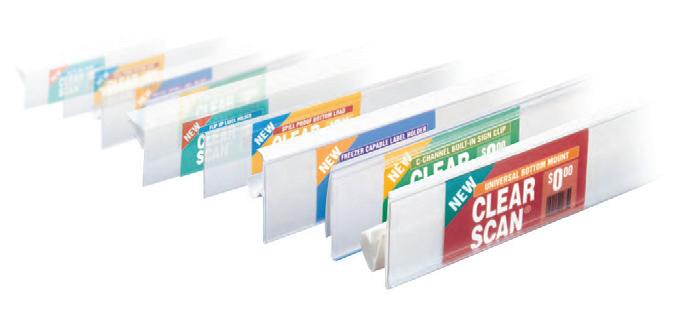
These strong, downward-canted waterfall hooks lift more weights than a personal trainer. Ready for a workout, Trion Industries’ hooks display heavy products, like free weights in multiple sizes, with both sales and safety in mind. Your customers can easily browse the merchandise, which is held in place by built-in pins to keep product from shifting or falling. Exercise your opportunity to cross-sell related products and keep your bottom line in shape! Of course these waterfall utility hooks are perfect for more than hand weights. Give them a try.



Call | TrionOnline.com
Call 800-444-4665 | TrionOnline.com
Mirror, mirror on the wall. You can be the most difficult item to display of all. Clever merchandisers use large literature holders for three-dimensional, awkwardly sized items like mirrors, framed art, clocks,

make it easy to label and price products, regardless of plan-o-gram fixture layout, unusual product shape, or tightly spaced displays. When you need a flexible aid to label and price items quickly and conveniently, turn to this Swiss Army knife of outfitting. Scan-ItTM is available in a range of back plate sizes and label holder configurations.


heroes of the Trion product family, coming to the rescue when you need muscle and good looks to merchandise items of all sizes. These Bar Hooks can lift heavy loads in their capable arms. Display or Scan, Saddle Mount or Plug in, there are Trion WonderBar Hooks for every need.


Mirror, mirror on the wall. You can be the most difficult item to display of all. Clever merchandisers use large literature holders for three-dimensional, awkwardly sized items like mirrors, framed art, clocks, and more. Available in a range of sizes, gauges, and weights, Trion’s large literature holders can be spaced horizontally to accommodate all manner of product sizes.
Flip-Scan case for ease of use. The articulated label holder lifts up and out of the way for easy product access, then falls back to vertical for viewing product and price info. Our unique label holder flexes open so plain paper labels can be inserted effortlessly. Available with short label holders or full length label strips and constructed of long-life materials, these durable, attractive scan hooks can outfit all display surfaces, including pegboard, slatwall, grid, crossbar, and corrugated. Fully compatible with the Clear Scan® Label Holder System for C-channel, shelf edge, wire basket, and refrigerated areas storewide.
Call 800-444-4665 | TrionOnline.com
the length and uses. Mount level or in gravity-feed mode from pegboard or slatwall, or place on shelves or table tops. Pair the baskets with hang tags, efficiently displaying both products and prices. Customize your baskets with handy dividers to create exactly the compartmentalization you need.





effectively, attractively merchandise in these baskets is, well, endless, as is the length and uses. Mount level or in gravity-feed mode from pegboard or slatwall, or place on shelves or table tops. Pair the baskets with hang tags, efficiently displaying both products and prices. Customize your baskets with handy dividers to create exactly the compartmentalization you need.
you use Trion’s Air Flow Baffle in coolers. Product temperature can be difficult to maintain at the front of a cooler. This Air Flow Baffle ensures that cold air is forced forward to keep items at their ideal temperature. Use as part of your cooler outfitting strategy, along with WonderBar ® Bar Merchandisers and hooks, EWTTM Expandable Wire Tray System, and cooler capable Clear Scan® label holders.
Call 800-444-4665 | TrionOnline.com
Call 800-444-4665 | TrionOnline.com
The number of products you can effectively, attractively merchandise in these baskets is, well, endless, as is the length and uses. Mount level or in gravity-feed mode from pegboard or slatwall, or place on shelves or table tops. Pair the baskets with hang tags, efficiently displaying both products and prices. Customize your baskets with handy dividers to create exactly the compartmentalization you need.
Call 800-444-4665 | TrionOnline.com
Call 800-444-4665 | TrionOnline.com
The number of products you can effectively, attractively merchandise in these baskets is, well, endless, as is the length and uses. Mount level or in gravity-feed mode from pegboard or slatwall, or place on shelves or table tops. Pair the baskets with hang tags, efficiently displaying both products and prices. Customize your baskets with handy dividers to create exactly the compartmentalization you need.
Call 800-444-4665 | TrionOnline.com
Use ZIP Track® storewide to organize various types of cleaning products, insect repellent and various other household items. It is the most versatile system of its kind on the market. Easy to install, ZIP Track® components clip on a front rail allowing lanes to adjust quickly, even when full or to add additional facings. Use actual product to set lane width from 2" up to 3 3/4 " Slide product front-to-back to “ZIP” each track together. ZIP Track® offers a wide range of adjustability for everevolving package designs.
assembled – a dream come true for speeding labor intensive projects. Because the hooks are already assembled, you can display merchandise as quickly as you can say “profits.” Once installed, these hooks come apart easily, making merchandising changes in tight displays fast and easy. Reinforced to host even heavy items, these hooks are available in standard, medium and heavy gauge frontwires with engineering grade plastic backplates to provide durable and attractive ways to keep your merchandise accessible.
straight-entry hooks arrive already assembled – a dream come true for speeding labor intensive projects. Because the hooks are already assembled, you can display merchandise as quickly as you can say “profits.” Once installed, these hooks come apart easily, making merchandising changes in tight displays fast and easy. Reinforced to host even heavy items, these hooks are available in standard, medium and heavy gauge frontwires with engineering grade plastic backplates to provide durable and attractive ways to keep your merchandise accessible.
Neatly and effectively display cooler and freezer items, including yogurt, dips, puddings, ice cream, single-serve foods, and more. Our small Adjustable Merchandising Tray (AMT) fits a range of 4- to 6-ounce cups; the medium AMT organizes mid-range offerings; and the large AMT gives ice cream lovers pause to browse and choose a pint of their favorite flavor (hmmm why not get both Cherry Vanilla and Rocky Road?). This manual-feed tray ensures that products remain faced and accessible. Time to re-stock? Just lift out and refill. Add Clear Scan® Label Holder, and you’re finished! Call 800-444-4665 | TrionOnline.com

You read that right. These two-piece straight-entry hooks arrive already assembled – a dream come true for speeding labor intensive projects. Because the hooks are already assembled, you can display merchandise as quickly as you can say “profits.” Once installed, these hooks come apart easily, making merchandising changes in tight displays fast and easy. Reinforced to host even heavy items, these hooks are available in standard, medium and heavy gauge frontwires with engineering grade plastic backplates to provide durable and attractive ways to keep your merchandise accessible.
Call 800-444-4665 | TrionOnline.com
Call 800-444-4665 | TrionOnline.com
You read that right. These two-piece straight-entry hooks arrive already assembled – a dream come true for speeding labor intensive projects. Because the hooks are already assembled, you can display merchandise as quickly as you can say “profits.” Once installed, these hooks come apart easily, making merchandising changes in tight displays fast and easy. Reinforced to host even heavy items, these hooks are available in standard, medium and heavy gauge frontwires with engineering grade plastic backplates to provide durable and attractive ways to keep your merchandise accessible.
Call 800-444-4665 | TrionOnline.com
Call 800-444-4665 | TrionOnline.com
displayed, upscale merchandise. Adjustable, multi-functional dividers allow you to customize depth and change the width of displays just as fast as new products are delivered. Sturdy, clear presentation keeps products looking their best, highlighting the colors, options, sizes, quality, and billboarding brands. Trion’s Clear Acrylic Divider Systems are among the best looking and adaptable merchandising systems. Call 800-444-4665 | TrionOnline.com
If you think the WonderBar EWT is great, wait till you meet its big brother! Oversized just like some of your products, this weightlifter stays strong on both metal and open wire shelves and bar. One-piece installation means you can drop this bad boy right into place, adjust as needed, and watch the revenue increase. The EWT takes over from there, automatically feeding product to the front and billboarding merchandise for maximum visibility.
customers can spot and browse neatly displayed, upscale merchandise. Adjustable, multi-functional dividers allow you to customize depth and change the width of displays just as fast as new products are delivered. Sturdy, clear presentation keeps products looking their best, highlighting the colors, options, sizes, quality, and billboarding brands. Trion’s Clear Acrylic Divider Systems are among the best looking and adaptable merchandising systems. Call 800-444-4665 | TrionOnline.com




The way to profits is clear when customers can spot and browse neatly displayed, upscale merchandise. Adjustable, multi-functional dividers allow you to customize depth and change the width of displays just as fast as new products are delivered. Sturdy, clear presentation keeps products looking their best, highlighting the colors, options, sizes, quality, and billboarding brands. Trion’s Clear Acrylic Divider Systems are among the best looking and adaptable merchandising systems. Call 800-444-4665 | TrionOnline.com
The way to profits is clear when customers can spot and browse neatly displayed, upscale merchandise. Adjustable, multi-functional dividers allow you to customize depth and change the width of displays just as fast as new products are delivered. Sturdy, clear presentation keeps products looking their best, highlighting the colors, options, sizes, quality, and billboarding brands. Trion’s Clear Acrylic Divider Systems are among the best looking and adaptable merchandising systems. Call 800-444-4665 | TrionOnline.com
Call 800-444-4665 | TrionOnline.com
coming to the rescue when you need muscle and good looks to merchandise items of all sizes. These Bar Hooks can lift heavy loads in their capable arms. Display or Scan, Saddle Mount or Plug in, there are Trion WonderBar Hooks for every need.










pegboard extenders. Use them to layer display surfaces so you can simultaneously show tall and short items. Commonly used to merchandise mops, brooms, long handled tools and more, with cross sells and accessories directly in front. Pegboard extenders extend your merchandising reach.
layer display surfaces so you can simultaneously show tall and short items. Commonly used to merchandise mops, brooms, long handled tools and more, with cross sells and accessories directly in front. Pegboard extenders extend your merchandising reach.

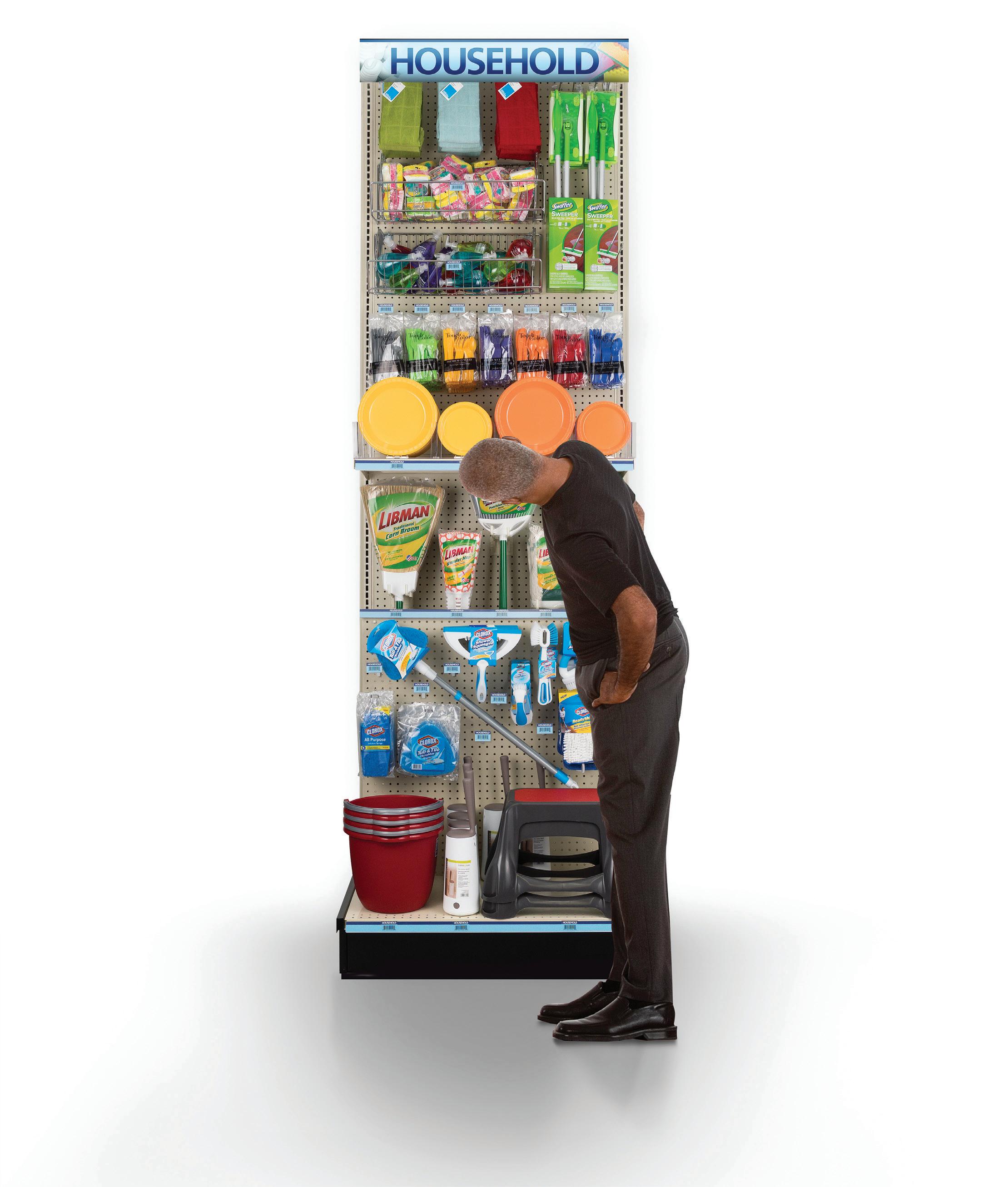
Extend your opportunities to increase revenue with Trion’s pegboard extenders. Use them to layer display surfaces so you can simultaneously show tall and short items. Commonly used to merchandise mops, brooms, long handled tools and more, with cross sells and accessories directly in front. Pegboard extenders extend your merchandising reach.
Extend your opportunities to increase revenue with Trion’s pegboard extenders. Use them to layer display surfaces so you can simultaneously show tall and short items. Commonly used to merchandise mops, brooms, long handled tools and more, with cross sells and accessories directly in front. Pegboard extenders extend your merchandising reach.

